New hope for the northern white rhino
ANIMALS THAT RULED BEFORE THE DINOSAURS 10 Spectacular condors in the Andes
The trophy hunting debate

Sir David Attenborough’s

New hope for the northern white rhino
ANIMALS THAT RULED BEFORE THE DINOSAURS 10 Spectacular condors in the Andes
The trophy hunting debate

Sir David Attenborough’s
The inside story of the epic new BBC series
The wildlife and scenery at the top of the world are unlike any other on Earth. On The Svalbard Express, watch walruses basking in the sun along sandy beaches. Look for migrating pods of whales; for sea eagles soaring high above turquoise fjords and verdant mountains or for families of reindeer dotted among Svalbard’s jagged mountain ranges.
Departures: May – September 2024
Bergen – Longyearbyen – Bergen
Book Now

North Cape 71¡N
Honningsvåg
Ny-Ålesund
Longyearbyen
SVALBARD
Bjørnøya
Svolvær
Tromsø
Senja Træna
Stokmarknes
66°33'N ARCTIC CIRCLE
Brønnøysund
Ålesund Åndalsnes
Bergen NORWAY
Urke
COVER IMAGE: ANDY ROUSE; BBC PANEL: GETTY; RHINO: JON A

Egyptian bas-relief

Presenter Adam Walton meets two researchers from Bangor University to learn about the diversity of venomous snakes found across ancient Egypt by combining ancient texts with current technology.
Catch up on BBC Sounds
Earth from space


In this new series, Emily Knight explores the stories that sophisticated tracking devices can tell us about animals, as well as their surroundings, including climatic conditions and the health of ecosystems in a rapidly changing world.
Catch up on BBC Sounds

The world’s oldest fossilised forest was recently uncovered in Somerset.
Palaeobotanist Christopher Berry sheds light on the cladoxylopsids that lived 390 million years ago and reveal extraordinary evolutionary secrets. Catch up on BBC Sounds
wildlifemagazine@ourmedia.co.uk
instagram.com/bbcwildlifemagazine twitter.com/WildlifeMag
facebook.com/wildlifemagazine
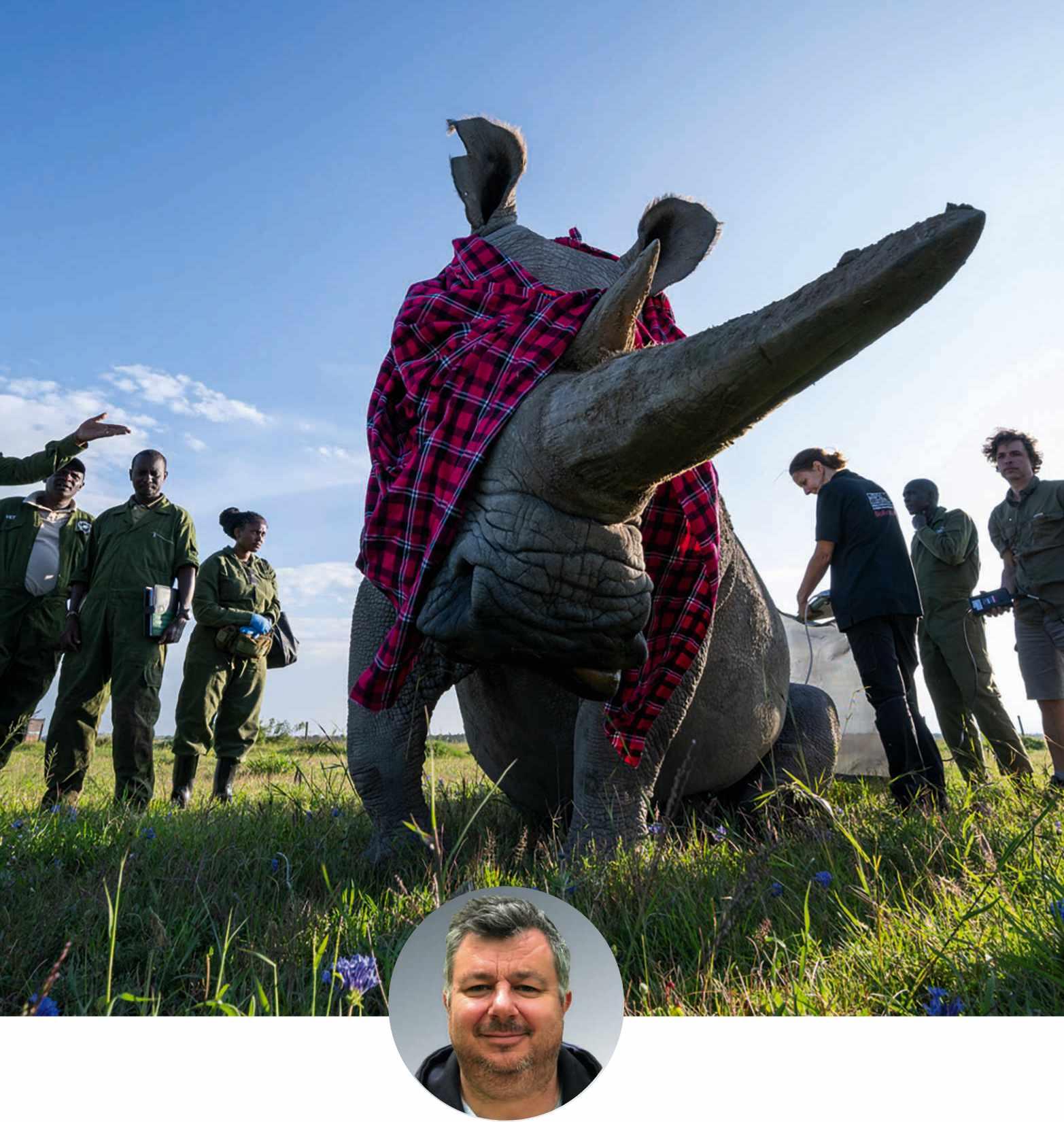
There is still hope for the northern white rhinoPAUL McGUINNESS, EDITOR
Only two northern white rhinos remain, and they’re both females, and both incapable of carrying a pregnancy to full term. Surely extinction is just a matter of when, not if? And yet, as Jon A Juárez illustrates in his remarkable Portfolio feature this month (p46), there is still hope.
Using the very latest science, a project is underway in Kenya to use a surrogate southern white rhino mother to incubate a northern white rhino embryo created in a laboratory using harvested eggs and frozen sperm. Human IVF is unimaginably stressful and delicate, and very often unsuccessful, so attempting the same process with a wild animal of such size is hard to believe.
The northern white is not out of the woods yet, but where there’s a will, science is hopefully finding a way!

editor Paul McGuinness
managing editor Sarah McPherson
production editor Catherine Mossop seo lead Debbie Graham
contributors
Scott
Lucy Cooke, Mike Dilger, Holly Exley, James Fair, Kensho Goto, Shane Gross, Jo Haley, Tony Heald, Ben Hoare, Melissa Hobson, Jon A Juárez, Cate Langmuir, Florian Ledoux, Will Newton, Jenny Price, Jo Price, Andy Rouse, Peter David Scott, Richard Smyth, Wanda Sowry, Kenny Taylor, Lillian Todd-Jones, Nick Upton, Leoma Williams
Our Media, Eagle House, Bristol BS1 4ST, UK wildlifemagazine@ourmedia.co.uk bbcwildlife@ourmediashop.com
@wildlifemagazine
@WildlifeMag
@bbcwildlifemagazine
discoverwildlife.com bit.ly/bbcwildlifeyoutube
advertising
client solutions manager Dan Baker 0117 300 8280 dan.baker@ourmedia.co.uk
ad manager Sophie Keenan 0117 300 8804 sophie.keenan@ourmedia.co.uk
commercial brand manager Samantha Hurter-Wall 0117 300 8815 samantha.hurter-wall@ourmedia.co.uk
brand sales executive Anthony Jago 0117 300 8543 anthony.jago@ourmedia.co.uk
brand sales executive Marc Hay 0117 300 8758 marc.hay@ourmedia.co.uk
inserts Laurence Robertson 00353 876 902208 laurence.robertson@ourmedia.co.uk
licensing and syndication
senior paralegal Emma Brunt 0117 300 8979 emma.brunt@ourmedia.co.uk
director of licensing and syndication Tim Hudson
Our media ltd
CEO Andy Marshall managing director Andrew Davies brand lead Daniel Bennett
head of brand marketing Rosa Sherwood
marketing subscriptions director Jacky Perales-Morris
senior direct marketing manager Aimee Rhymer
subscriptions Marketing Manager Chris Rackley
production
production Director Sarah Powell
deputy production manager Emily Mounter
senior ad co-ordinator Charles Thurlow ad designer Parvin Sepehr
bbc studios, uk publishing chair, editorial review boards Nicholas Brett md, consumer products & licensing Stephen Davies
director, magazines and consumer products Mandy Thwaites compliance manager Cameron McEwan uk.publishing@bbc.com
bbc editorial review board
Alasdair Cross producer, bbc audio Rosemary Edwards executive producer, bbc natural history unit Sue Kent independent consultant
Jane Lomas series editor, countryfile Camila Ruz Renjifo digital producer, bbc natural history unit
photography and ethics
BBC Wildlife champions ethical wildlife photography that prioritises the welfare of animals and the environment. It is committed to the faithful representation of nature, free from excessive digital manipulation, and complete honesty in captioning. Photographers, please support us by disclosing all information about the circumstances under which your pictures were taken (including, but not restricted to, use of bait, captive or habituated animals). BBC Wildlife provides trusted, independent travel advice and information that has been gathered without fear or favour. We aim to provide options that cover a range of budgets and reveal the positive and negative points of the locations we visit. The views expressed in BBC Wildlife are those of the authors and not necessarily those of the magazine or its publisher. The publisher, editor and authors accept no responsibility in respect of any products, goods or services that may be advertised or referred to in this issue or for any errors, omissions, mis-statements or mistakes in any such advertisements or references.
Our Media Ltd is working to ensure that all of its paper comes from well-managed, FSC®-certified forests and other controlled sources. This magazine is printed on Forest Stewardship Council® (FSC®) certified paper. This magazine can be recycled, for use in newspapers and packaging. Please remove any gifts, samples or wrapping and dispose of them at your local collection point.
BBC Wildlife (ISSN 0265-3656 USPS XXXXX) is published monthly with an extra copy in June by Our Media Ltd, Eagle House, Bristol, BS1 4ST United Kingdom. Airfreight and mailing in the USA by World Container Inc., c/o BBT 150-15 183rd St, Jamaica, NY 11413-4037, USA. Periodicals postage paid at Brooklyn, NY 11256.
POSTMASTER: Send address changes to BBC Wildlife, World Container Inc., c/o BBT 150-15, 183rd St, Jamaica, NY 11431, USA. All rights reserved. No part of BBC Wildlife may be reproduced in any form or by any means, either wholly or in part, without prior written permission from the publisher. Not



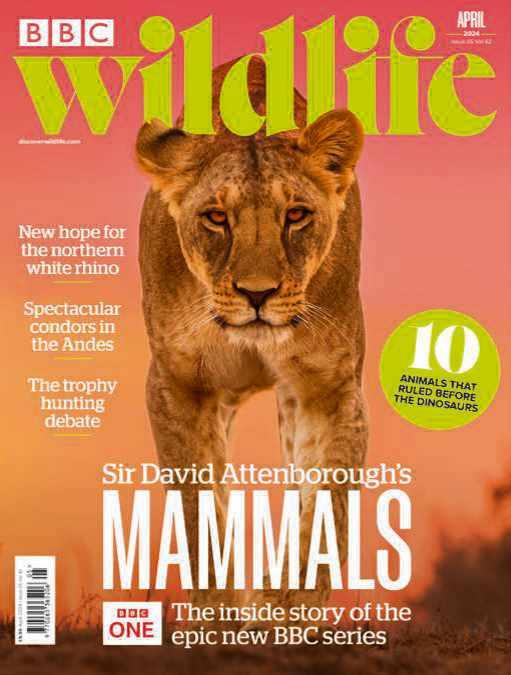
Lions are one of the many species that star in the brandnew BBC One series, Mammals, airing this spring. The Forest episode features a pride in Uganda that have learnt how to stay cool by climbing into euphorbia trees. “Mammals are the most adaptable and – for my money – adorable animals on earth,” says head of commissioning Jack Bootle. A new series is coming to BBC One...
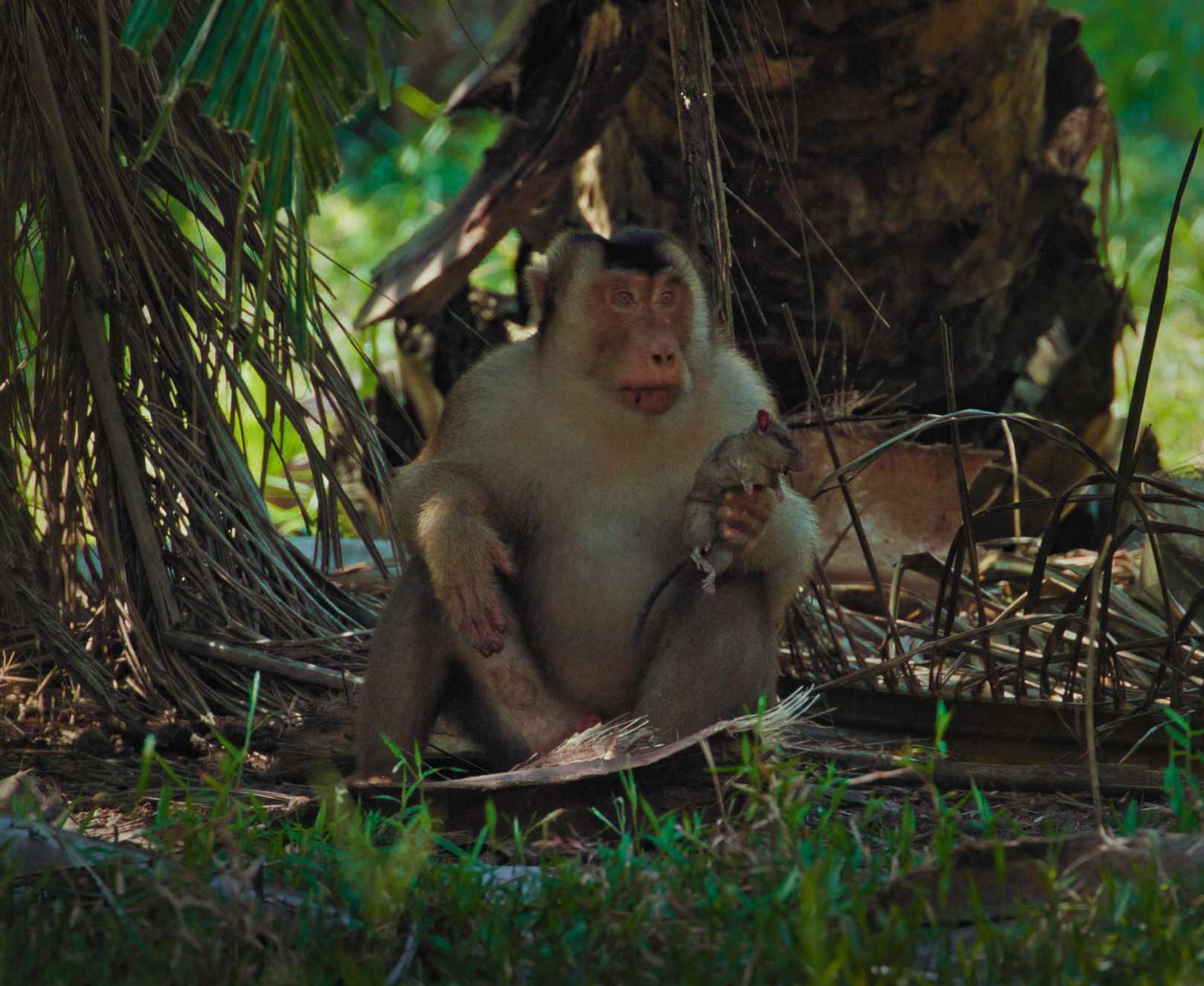

“The

GILLIAN BURKE
“Surely

MARK CARWARDINE
Unfortunately, we’re unable to feature a column from Mark this month, but look out for him in a future issue


08 Wild Times
Catch up with all the latest developments and discoveries making the headlines
30 Spectacular condors in the Andes
Mike Dilger offers his top tips for observing these masterful vultures effortlessly soaring
34 Hidden World
A clever adaptation allows water anole lizards to stay submerged and out of danger
38 Mammals
Series producer Scott Alexander shares behind-the-scenes tales from the new BBC One show
46 New hope for the northern white rhino IVF is providing one last chance to save this incredibly rare subspecies from extinction
56 The trophy hunting debate
Does allowing wealthy tourists to kill wild animals actually help conservation?
64 10 animals that ruled before the dinosaurs
From super-sized millipedes to fish that could walk on land
72 Mandarin magic
A glimpse into the secret life of the mandarin duck – a shy but beautiful bird that has made itself at home in the UK

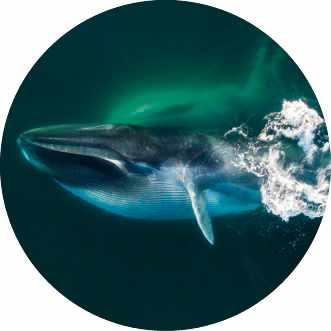


GET A WIGGLE ON
Highly Commended in the Wide Angle category of Underwater Photographer of the Year 2024, this compelling image transports the viewer into a magical underwater world as millions of western toad tadpoles swim upwards to the lake shallows to feed on algae among the lilypads.

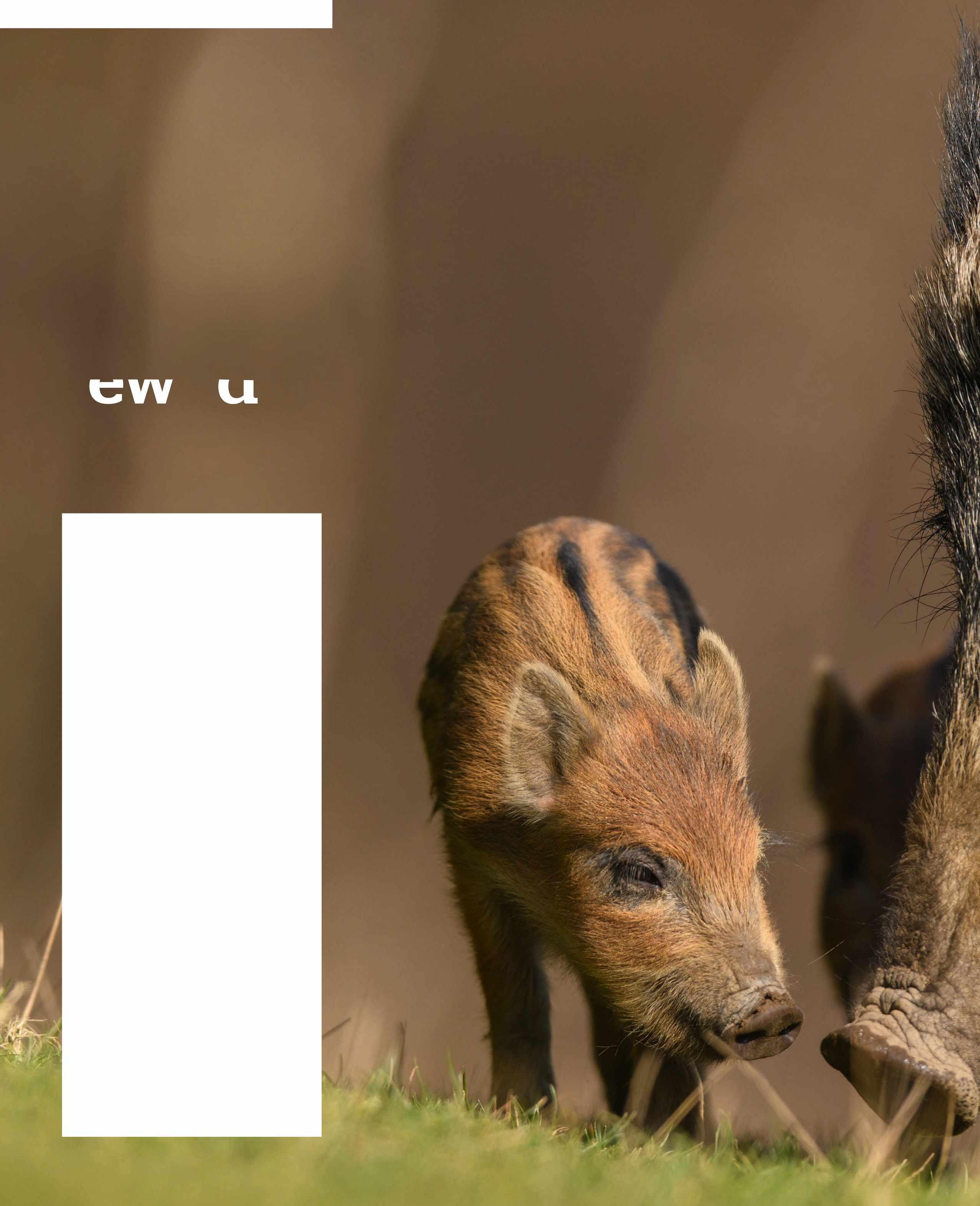

Seventy-odd kilos of irritated bristly boar is not to be messed with. Mature wild boar sows have young in tow in April and are super-protective of their boarlets, so if you’re lucky enough to glimpse these muscular, tusked pigs in a spring woodland, give them a wide berth. The stripy piglets are fondly nicknamed ‘humbugs’ for their resemblance to the mint-flavoured sweets. There may be five or six of them in a litter, but several sows and their piglets often join forces, forming a larger group called a sounder. By contrast, the big adult male boars, which can be twice as heavy as sows, are loners.
One estimate suggests there are 2,600 boar at large in Britain, with a stronghold in Gloucestershire’s Forest of Dean. Chantal Lyons, in her brilliant new book Groundbreakers, acknowledges boar can be difficult to live with, but sings their praises as piggy rewilders. The boar create a healthy mosaic of woodland habitats by turning over the earth and breaking the dominance of bracken, nettles and brambles, allowing a wider variety of plants and invertebrate life to flourish.
Ben Hoare

IF you enjoyed last year’s Wild Isles, the six-part series for BBC One presented by Sir David Attenborough that showcased the best of Britain’s wildlife, here’s your chance to hear more about the natural history extravaganza – in person. At this big-screen talk, veteran producer Alastair Fothergill discusses highlights from the series, shows never-before-seen footage and shares his behind-the-scenes stories. He promises to take the audience on a captivating journey through the most breathtaking landscapes of the UK, from the peaks of the Scottish Highlands down into the woodland undergrowth, showcasing the myriad species that call such places home. “Nature in these islands, if you know where to look, can be extraordinary, dramatic and beautiful,” reminds Sir David in his voiceover. “It rivals anything I’ve seen elsewhere. It’s not far; it’s home.”
The tour starts on 10th May in Basingstoke, following in venues in Bristol, Edinburgh, Birmingham, London (Royal Festival Hall) and Brighton. Tickets start at £21.80, book at wildisleslive.org.
Sarah McPhersonGannets, great skuas and roseate terns have been devastated by the disease
Anew report by the rspb, bto and other conservation organisations has revealed the true impact of avian flu on the UK’s globally important populations of seabirds.
According to the study, the great skua was particularly badly hit, with more than three quarters of the UK population lost. At least 2,500 birds were reported dead across Scotland, which is home to 60 per cent of the world population.
The gannet has also been severely impacted, with a 25 per cent drop in numbers across the UK, which supports more than half of the world’s birds. At least 11,000 deaths were recorded in Scotland, and there was a 54 per cent collapse in
the Welsh population – 5,000 deaths were recorded on the RSPB island reserve of Grassholm alone. Gannets breed in a small number of densely packed colonies, making them particularly vulnerable to the spread of the disease.
The report also revealed a 21 per cent decline in the UK population of roseate terns, our rarest breeding seabird.
“The findings are extremely worrying, confirming avian flu to be a major additional threat to our already struggling seabirds,” says Jean Duggan, policy assistant on avian flu at the RSPB. “We knew the situation was bad for gannets and great skuas in

particular, but it’s worse than we thought.”
In other news, the long-term future of the UK’s threatened seabirds – including gannets and great skuas – is looking more hopeful following the ban on industrial sandeel fishing in the English North Sea and all Scottish waters. The move represents a significant victory for environmental groups, which have been campaigning for a ban for decades.
Jean Duggan“The closure of sandeel fisheries will be a vital lifeline for our seabirds,” says Duggan. “Now we need to build on this with further action to increase resilience and safeguard their future.”
Simon Birch

The cooperation of communites was critical to new observations of rare river turtle in tropical India
Agroup of biologists has discovered a breeding population of extremely rare Cantor’s giant softshell turtles (Pelochelys cantorii) on the banks of the Chandragiri River in India’s tropical south-west. It’s the first time this secretive species has been recorded nesting, according to a study published in the journal Oryx. With data on the species’ ecology, behaviour and population size limited, the finding – which relied heavily on community knowledge – represents an important breakthrough for conservationists.
Cantor’s giant softshell turtle, also known as the ‘frog-faced softshell’ due to its amphibian-like facial features, is a large species of freshwater turtle with a broad head, small eyes and a pointed snout. Despite its wide distribution across much of southern Asia, the species, which can exceed more than one metre in length and weigh more than 100kg, is in decline and classified as Critically Endangered on the IUCN’s Red List of Threatened Species. Habitat destruction is the main cause of the population drop, though the turtles are also harvested for meat and are often killed when they become caught in fishing gear.
The quest to uncover the whereabouts of the softshell took a team of researchers to the south-west Indian state of Kerala. By talking to people from local communities, the scientists were able to locate the turtles on the banks of the Chandragiri River and begin to record their observations. Their research led to the first documentation of a nesting female.
“Through household interviews and the establishment of a local alert network, we did not just listen; we learned,” says Ayushi Jain, co-author of the paper. “The community’s willingness to engage formed the backbone of our project, allowing us to record not just fleeting glimpses of the turtles but evidence of a reproductive population – a discovery that rewrites the narrative of a species thought to be vanishing from India’s waters.”

The paper highlights the vital role of local knowledge in conservation, and suggests that the creation of an alert network, where community involvement offers not only expert knowledge and insight, but also immediate action, will pave the way for a more responsive and inclusive model of wildlife conservation in Kerala.
Danny Graham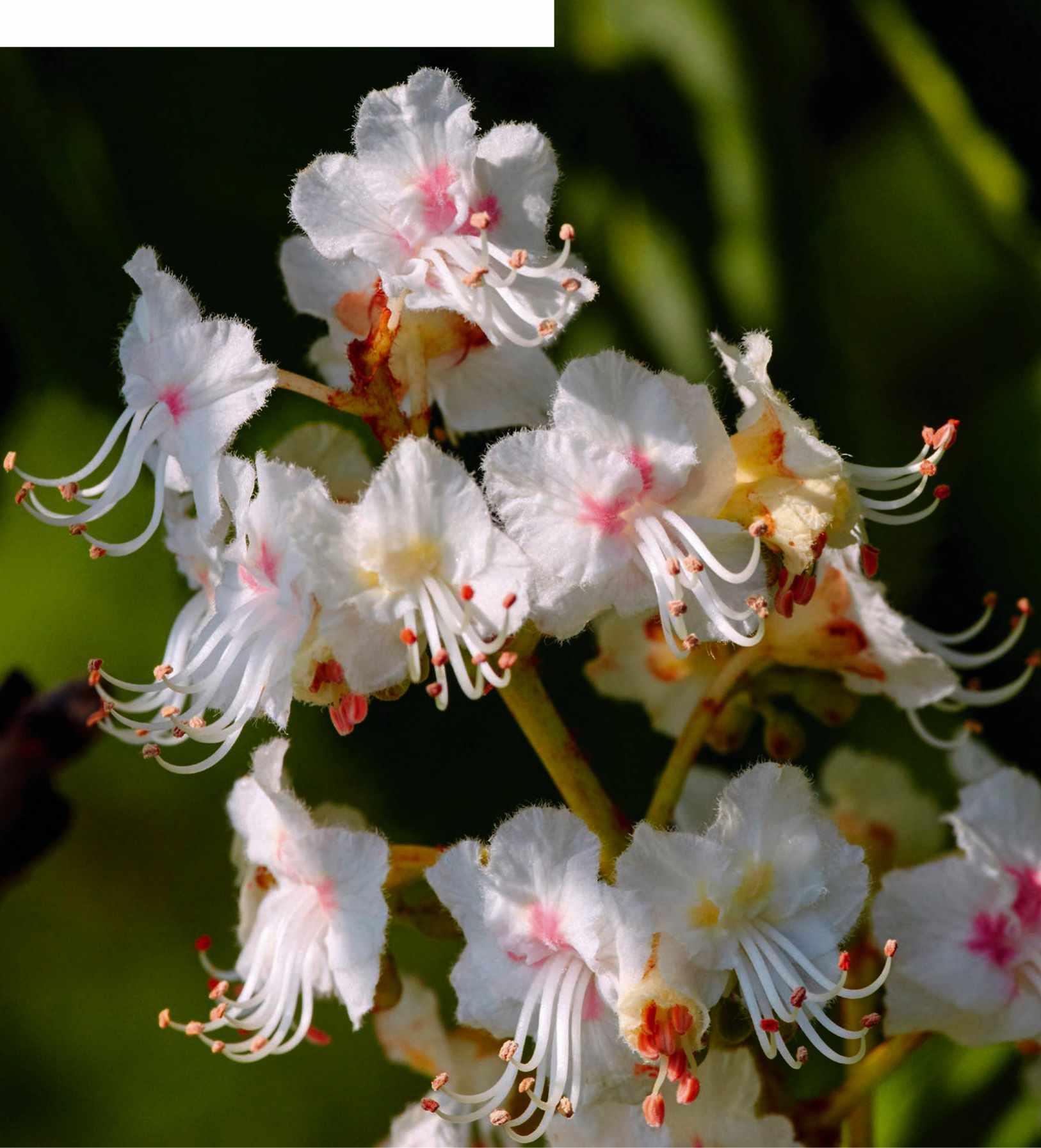
Hooves are the hardened tips of the toes found in many a large herbivore. A cloven hoof is one that appears to have been cleaved in two – think of the print left by a cow or deer. The earliest common ancestor of ungulates would have had five toes on each foot, but some of these have been lost during the course of evolution. Cloven hooves correspond to the third and fourth of these ancestral digits.
Stuart Blackman
It’s a little over 400 years since the first horse chestnut trees were brought to the British Isles from their native home in the mountains of Greece. You only have to look at these handsome trees covered in pinkish-white blossom to appreciate why the owners of grand houses were so desperate to include them in their gardens and deer parks. Horse chestnuts can now claim to be some of the tallest flowering plants in the country, and the individual flower spikes, known romantically as candles, are themselves huge, measuring up to 20cm tall.
These rather magnificent flowers, which burst into bloom in April and May, are rich in both nectar and pollen. Look closely and you’ll notice the petals sport bright yellow streaks, known as nectar guides, which, as their name suggests, show bees where the goodies lie. Once pollinated, the nectar guides turn deep red to indicate that this particular flower is ‘spent’ and no longer worth visiting. Ben Hoare

Discover world-class birding along the longest river in Africa, where intricate ecosystems are flanked by archaeological treasures

Famous ruins, towering monuments and aweinspiring pyramids – a trip to Egypt is unforgettable, in part because of its immense cultural offering. But alongside the remnants of an iconic ancient civilisation, Egypt is home to some unique habitats and an astounding variety of birdlife, especially along the banks of its magnificent river, the Nile.
What better way to explore the ecological (and historical) riches on offer than joining an intimate river cruise with Aggressor Adventures? Luxury rooms, fivestar service and expert guides,
as well as breathtaking views and exceptional birdwatching opportunities, make for a travel experience like no other. Plus, the subtropical desert climate makes Egypt a great destination for some winter sun.
Beginning in Luxor on the east bank of the Nile, home to several ancient sites including Amun Temple and the Valley of the Kings, the Aggressor Nile Queen II embarks on its six-day voyage. First up, you’ll explore King Island — one of the area’s premier wetland sites — on the boat’s nine-metre floating bird hide. Look out for various
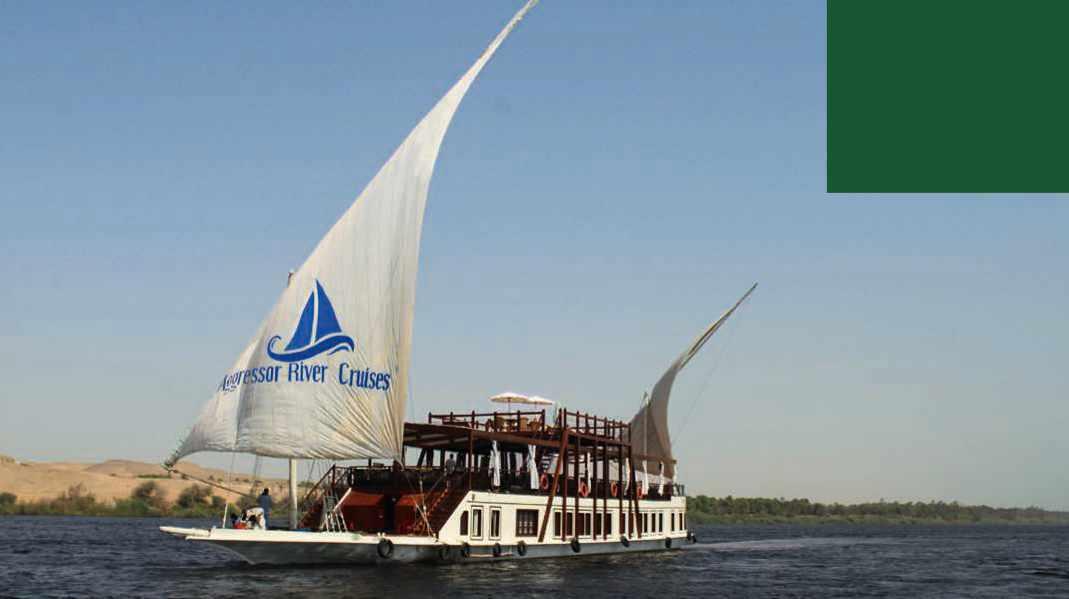
wetland species, such as the little egret, cattle egret and purple heron, as well as kingfishers and raptors.
The adventure unravels at a leisurely pace – each day you cruise down the river and visit different birding hotspots along the way. Travelling southwards to Aswan, the ship sails by several historical wonders, including Gebel Silsila quarry and Kom Ombo, and many important nesting sites for native and migratory birds. Keep an eye out for some of the region’s colourful residents, like the Nile Valley sunbird and the red avadavat.
With only 20 passengers aboard each charter, the Aggressor Nile River Cruise offers a truly
personalised experience with five-star service all-round. After a day’s sightseeing, watch the world go by from the hot tub on the sundeck, or retreat to your deluxe room with a private bathroom and tiled walk-in shower. Enjoy fantastic chef-prepared meals and complimentary beer and wine while you mingle with likeminded people, or simply watch the Saharan sunset change the colours of the sky. This is slow travel at its best.
Call +1 706-993-2531, message info@aggressor.com or visit aggressor.com for more information.

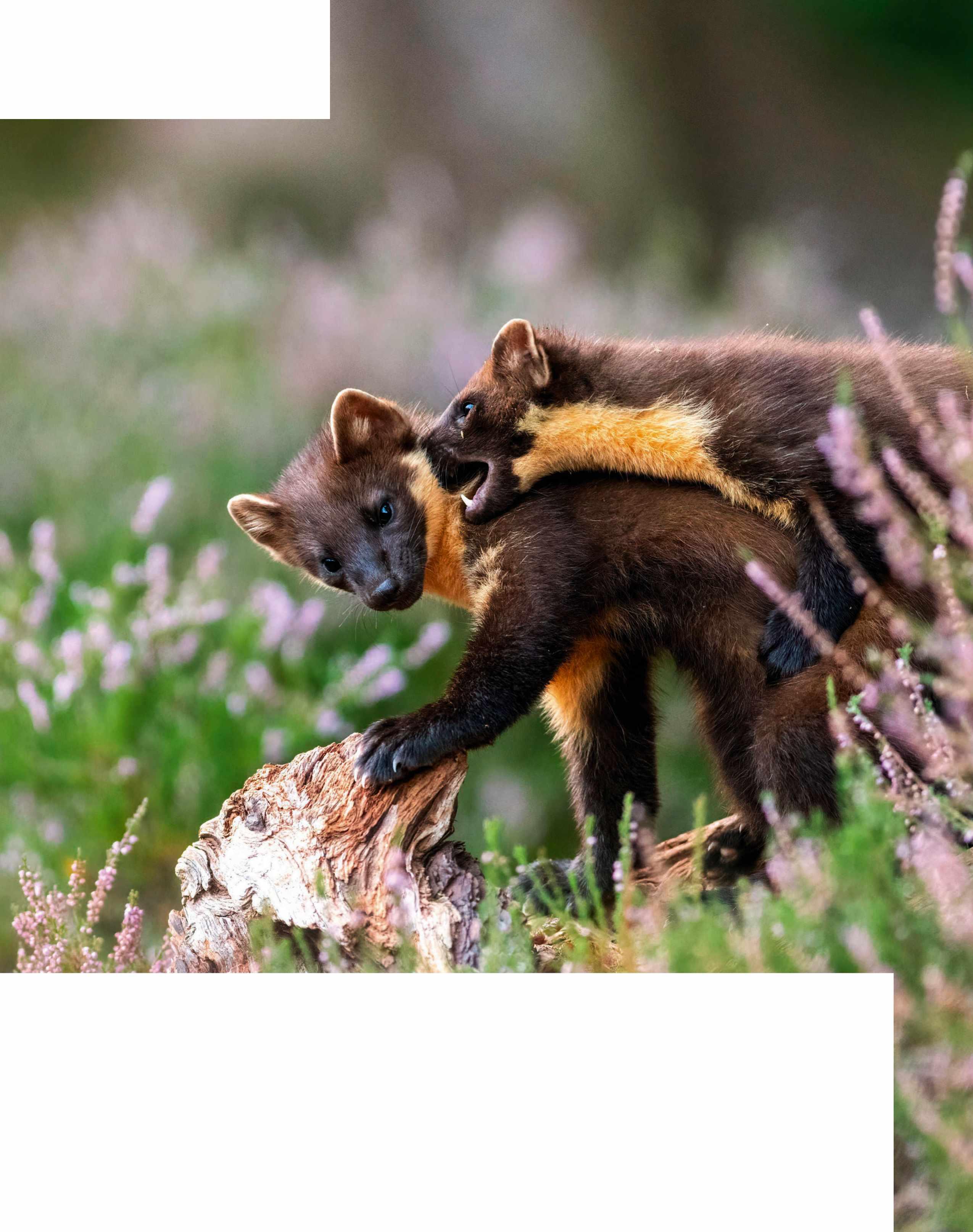
Pine martens give birth in spring, usually to two or three kits. The helpless young stay hidden in mum’s tree-hole den until May or June. For too long, these elusive mammals have clung to a fraction of their former range in Scotland, northern England and Wales, but reintroduction projects may soon return them to south-west and south-east England. Ben Hoare


First identified in 2017 by a group of Star Wars-loving scientists, the Skywalker hoolock gibbon was known only to exist in China, with fewer than 200 individuals. While experts suspected the distribution of the arboreal primate extended into Myanmar, a complex history of civil ethnic conflict in the country made it impossible to verify this theory. Now, new research published in the International Journal of Primatology proves that the species’ range does indeed spread into the South-East Asian nation.
Between December 2021 and March 2023, a field team, led by Fauna & Flora International and Nature Conservation Society Myanmar, undertook expeditions to six sites in Myanmar’s Kachin State and three sites in Shan State to determine the presence of Skywalker gibbons. The study involved the use of acoustic monitoring systems, which were set up at the sites. Each morning, the researchers listened to the Skywalker gibbons’ loud vocal displays to identify their locations.
The team also collected samples of plants and fruits discarded by the gibbons and analysed the material in a DNA/ RNA Shield. This non-invasive DNA-sampling technique enabled
the researchers to confirm 44 new groups of Skywalker gibbon in Myanmar. The exact number of individuals is unknown.
Ngwe Lwin, who led the expedition, says that the confirmation of Skywalker gibbons is “a significant discovery for the future of primate conservation in Myanmar,” whilst conceding that “while there are now more confirmed groups of Skywalker gibbons in the wild, it is feared that their populations are fast declining due to habitat degradation and loss, and poaching”.
Currently, just 4 per cent of Myanmar’s existing protected areas offers suitable habitat for Skywalker gibbons. The paper recommends combining governmentorganised protection with community protected areas. Two communities have already shown an interest in establishing protected areas, with one willing to start an awareness programme to prevent hunting of the endangered primate.

“Now more than ever, it is recognised that the collective efforts of stakeholders – including governments, communities and indigenous peoples’ groups – are the only effective way to protect and save our closest living relatives,” says Lwin.
Danny Graham
Scientists are uncovering the mysteries of deep coral reefs with underwater drones and eDNA
Researchers are using underwater drones to learn about mysterious mesophotic coral ecosystems (MCEs) – low-light habitats in tropical and subtropical regions made up of coral, sponges and algae. Because MCEs are found at depths of 30-150m, which is beyond recreational scuba-diving limits, they are very hard to study. So, Noriyuki Satoh and his team at Okinawa Institute of Science and Technology and NTT Communications in Japan have trialled the use of underwater drones to collect seawater samples and analyse their environmental DNA (eDNA). The aim is to find out which types of stony coral are present.
As organisms shed cells, mucus or faeces, they leave traces of eDNA behind. By analysing these, scientists can identify what creatures are present, even if they haven’t observed
them. eDNa is already used to study marine animals in shallow coral reefs.
The researchers collected samples at 24 sites in the Okinawa Archipelago – a region known for its clear waters and diversity of stony corals. Initial findings have identified coral at genus level and shown that the reef composition varies according to depth. Acropora corals, for instance, were more common in shallower reefs; Porites were more common in the MCEs.
Satoh hopes the use of underwater drones will help researchers learn more about MCEs. These reefs are home to a higher proportion of endemic species than their shallow counterparts, so knowing how they function is vital to keep the ocean healthy.
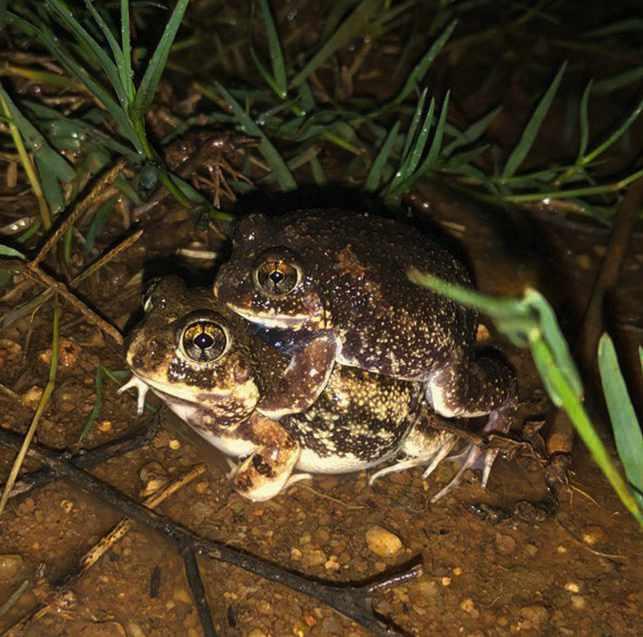
WHAT IS IT?
This plump, innocent-looking character is a new species of burrowing frog. Up to about 4cm in length, it can be distinguished from other members of its genus by its liver-spotted skin dotted with raised orange pimples.
WHERE IS IT?
So far, it is known from a few suburban sites around the Indian city of Bengaluru, where it seems to be active above ground only during the monsoon season. Males have been heard calling during torrential rain, but go quiet between showers. With no permanent water bodies in its habitat, it breeds in temporary muddy puddles.
WHAT’S THE MEANING BEHIND THE SCIENTIFIC NAME?
The genus, Sphaerotheca, derives from the Greek for ‘spherical box’, while varshaabhu is a Sanskrit name meaning ‘rain birth’, a reference to the species’ monsoon breeding season.
Find out more mapress.com/zt/article/ view/zootaxa.5405.3.3
 Melissa Hobson
Melissa Hobson
Koki Nishitsuji, Haruhi Narisoko and Noriyuki Satoh
A grey seal colony has established itself at a former military testing site used during both world wars and into the Cold War. More than 130 seal pups have been born at Orford Ness in Suffolk this breeding season. Rangers say that the site, now owned by the National Trust, has been used as a breeding ground since 2021 and hope the numbers will continue to rise.






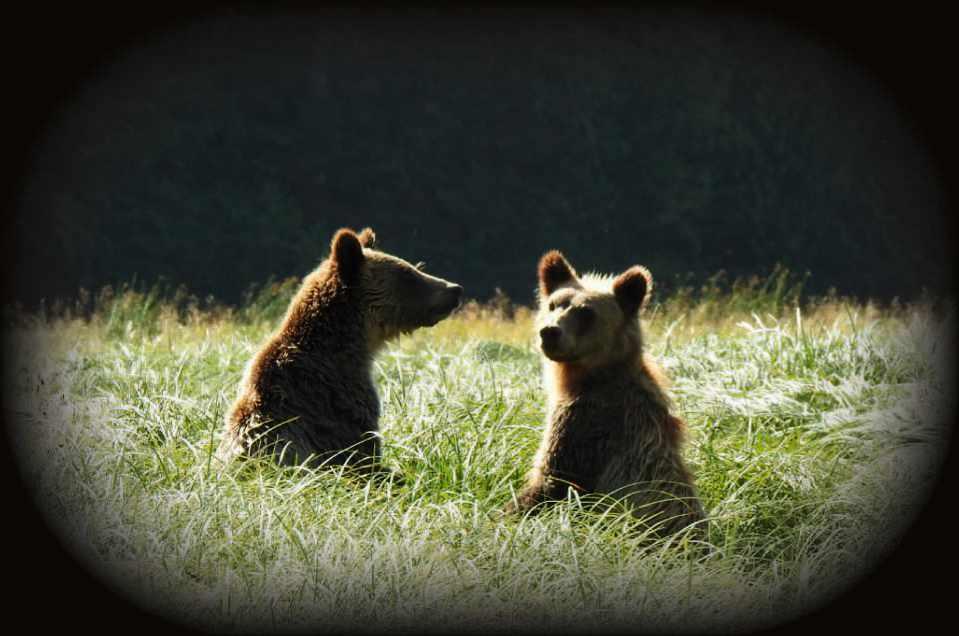

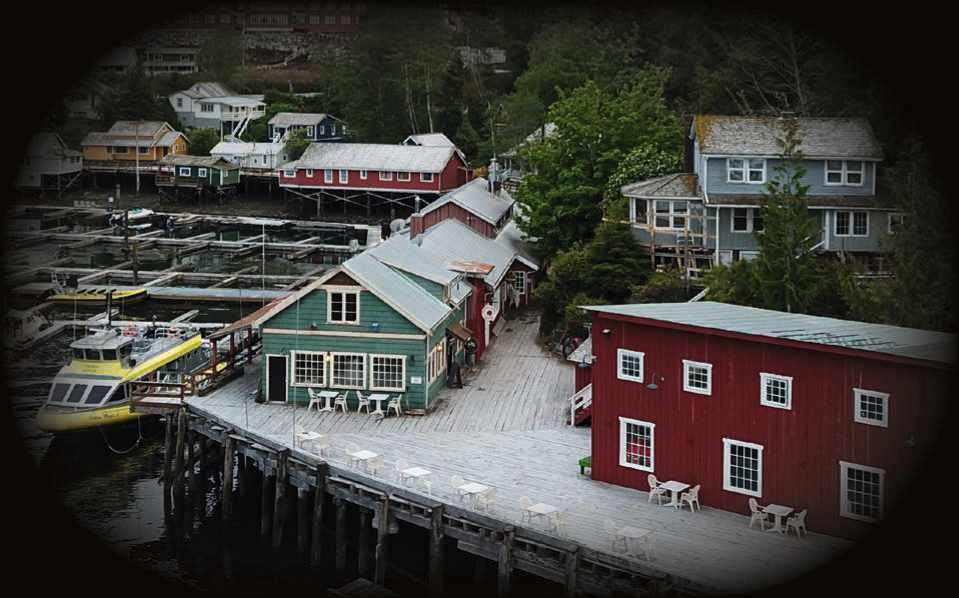

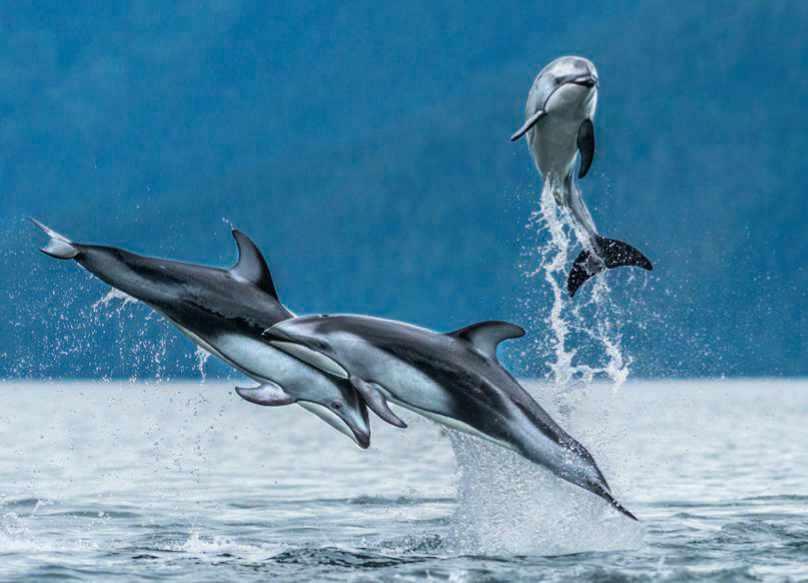

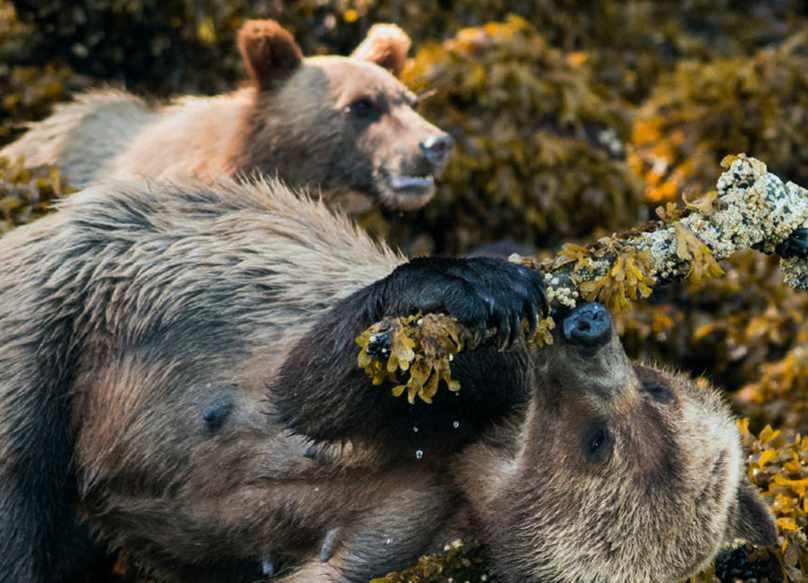
The idea of humans as an interplanetary species has been gaining momentum for the past few decades. Admittedly, I’m a little late to the party as I only first heard the term last year in an interview with the billionaire entrepreneur Elon Musk, who revealed his deep concern that our species is extremely vulnerable because we are currently limited to one planet.
My first thought was here’s someone who clearly doesn’t have enough to worry about. But Musk is not alone. The World Economic Forum has set out why humans must become an interplanetary species, while other scientists, including the late Stephen Hawking, have been advocating for going interstellar (because why stop at our solar system, I suppose?).
My gut reaction is surely extracting ourselves from the beautifully complex web of life to create a viable, healthy interstellar population isn’t really possible? It’s just a hunch, but I reckon the gut is a good place to start. The human gut-microbiome is home to 100 trillion bacteria, archaea, fungi, protozoa and viruses, and is just one of many microbial habitats on and inside our bodies.
Every one of us is like a walking planet with a multitude of ecological niches. These are home to microbes whose essential services we employ to help train our immune systems, digest our food, and regulate our energy levels and brain function, even including our moods.
Kick-starter microbial communities are acquired from our mothers at birth and evolve, diversify or shrink, according to life experience and environmental factors, to create a bespoke microbial signature for every individual. It’s thought that these microbial associations have been working their way down the maternal hominid line for more than 15 million years, which makes for an epic research and development phase that will be hard to beat if we were to up sticks and move to a foreign planet.
The role of microbiomes in humans and other animals (wood mice, giant pandas, bison and even common rock barnacles) is a new frontier of science, and so has been the subject of extensive research. But the sober irony is much of it is gleaned from gnotobiotic, or ‘germ-free’, lab animals who, by virtue of being artificially stripped of their microbial ‘helpers’, have extremely poor health outcomes and short lifespans.
Recognising that there will be a need to take our microbial compatriots with us,

Gillian Burke is a biologist, writer, film-maker, TV presenter and podcaster. She joined the BBC Two Watches team in 2017.
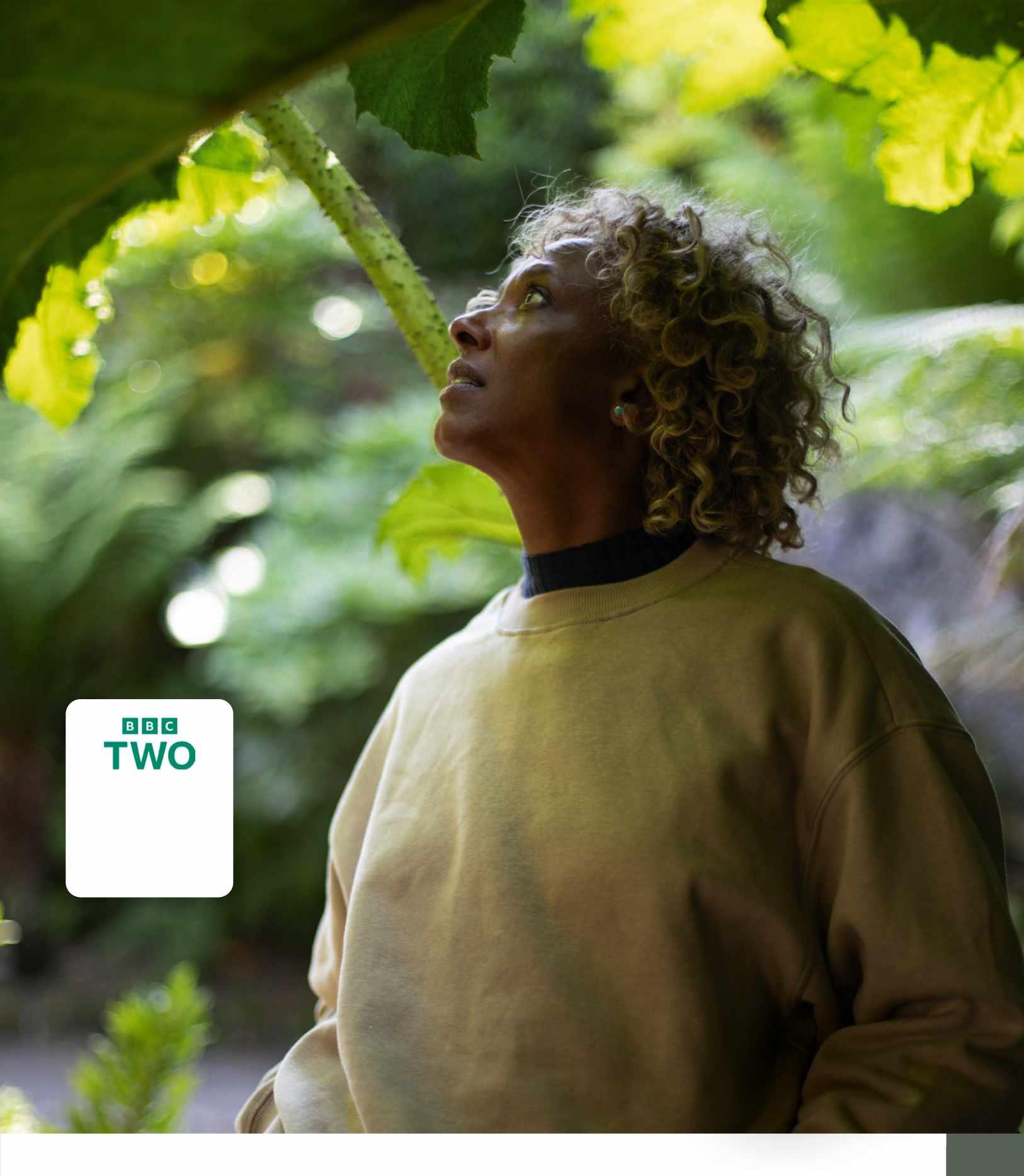
Catch up with all four episodes of Winterwatch on iPlayer
Maybe we need to look around us before we launch into space
“Is creating an interstellar human population really possible?”
NASA scientists have been studying baby bobtail squid on the International Space Station to observe how the effects of zerogravity, radiation exposure and other factors affect their microbiomes.
Meanwhile, back on earth, microbial communities underpin life as we know it, as photosynthesising plants feed exudates through their roots to microbes in the soil. A production line of bacteria, fungi, protozoa, nematodes and microarthropods convert inorganic minerals into essential nutrients that are re-absorbed by the plant and handed up the food chain, eventually nourishing us.
Setting aside ‘could we?’ for a moment, let’s ask, should we? I’m not against striving to boldly go where no human has gone before, but I am more in favour of addressing the existential threats that have prompted at least some scientists to think about launching a lifeboat into space.
The primary “global terminal risks”, as identified by the Future of Humanity Institute, are “nuclear holocaust, genetically engineered mistakes, destructive nanobots and even the gradual loss of human fertility”. All are entirely manufactured, so within our power to do something about.

A new genetic study finds that blue whales are mating with fin whales and producing fertile young
An examination of blue whale genetics has revealed that the world’s largest animals have been breeding with fin whales. During a study published in Conservation Genetics, researchers analysed the genomes of the North Atlantic blue whale subspecies – a group still in recovery following extensive whaling in the past – and discovered relatively high levels of fin whale DNA.
Though it has been known that the two species could create hybrids, often called ‘flue’ whales, it was only recently found that these hybrids were fertile. By mating with blue whales, fin whale DNA is introduced into the blue whale population, a process known as introgression.
Strangely, this introgression only seems to be going one way, from fin whales to blue whales, as the hybrids don’t appear to be mating with fin whales. “We don’t know why
introgression appears unidirectional,” says Mark Engstrom, co-author of the study, “but it may be related to reproductive behaviour and mating activities of the two species, and also possibly to the much larger numbers of fin whale individuals (and in this case specifically males) compared to the smaller population size of blues.” Engstrom adds that this hybridisation and introgression is not currently a cause for alarm but should be monitored going forward.
“As well as concerns that an endangered species could become extinct, there is also the associated issue of one species being highly protected and the other not,” says Danny Groves, head of communications at Whale and Dolphin Conservation in the UK. “The whale hunts in Iceland have led to hybrid blue and fin whales being killed.” Megan Shersby

Mark
Engstrom,co-author of the study

Lobsters pee out of their faces via special openings called nephrophores at the base of their antennae. The urine contains pheromones that allow lobsters to communicate with one another. Males pee to defend their caves, while females pee to indicate their
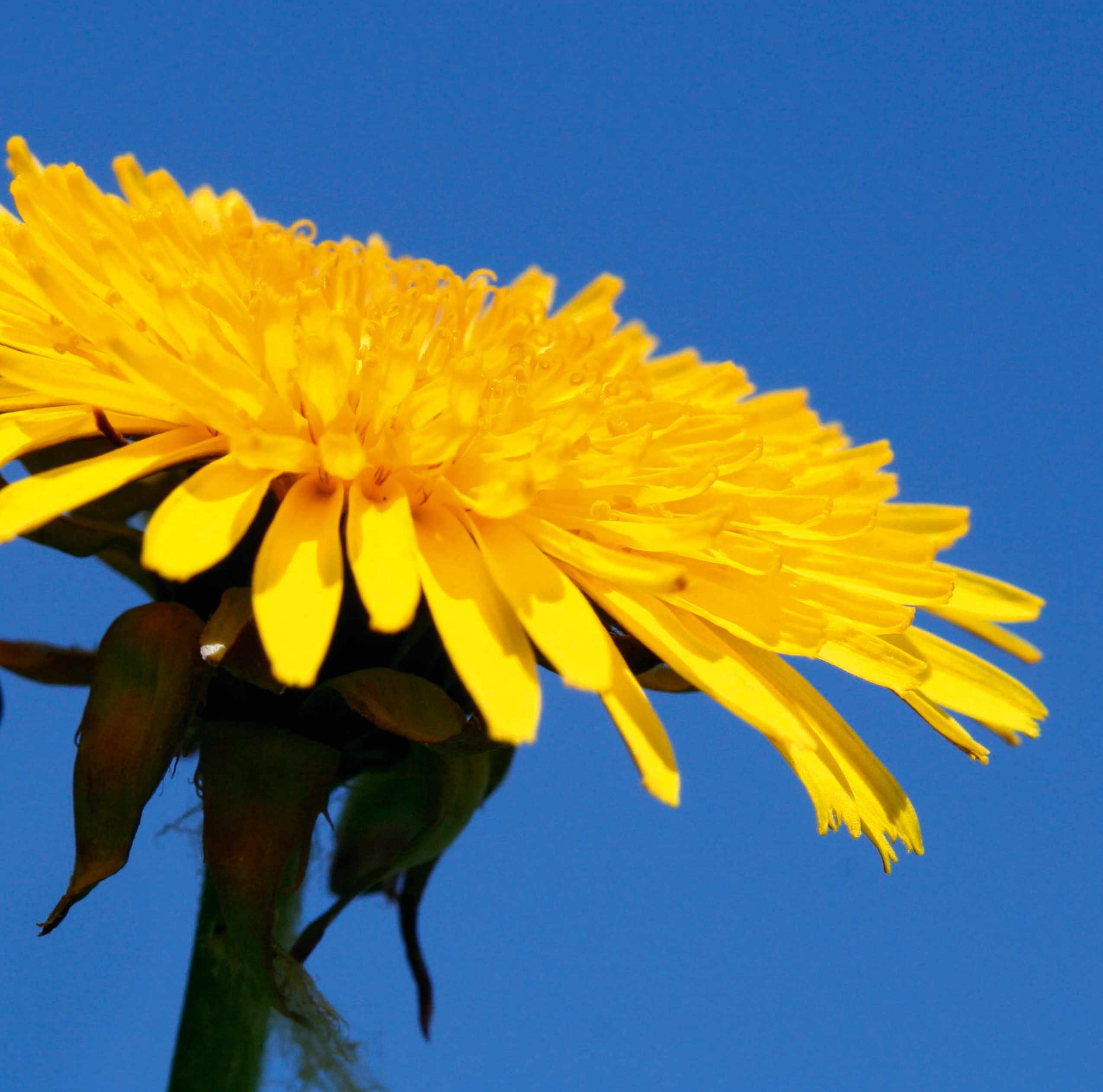
Dandelions enjoy their moment in the sun each spring, turning roundabouts, roadsides, lawns and any other scraps of grass that have been spared mowers and chemical sprays into a sea of yellow. Don’t dismiss these humble yet prolific ‘weeds’. They produce more nectar and pollen than most other wildflowers and are brilliant for bumblebees, solitary bees and hoverflies. Ben Hoare
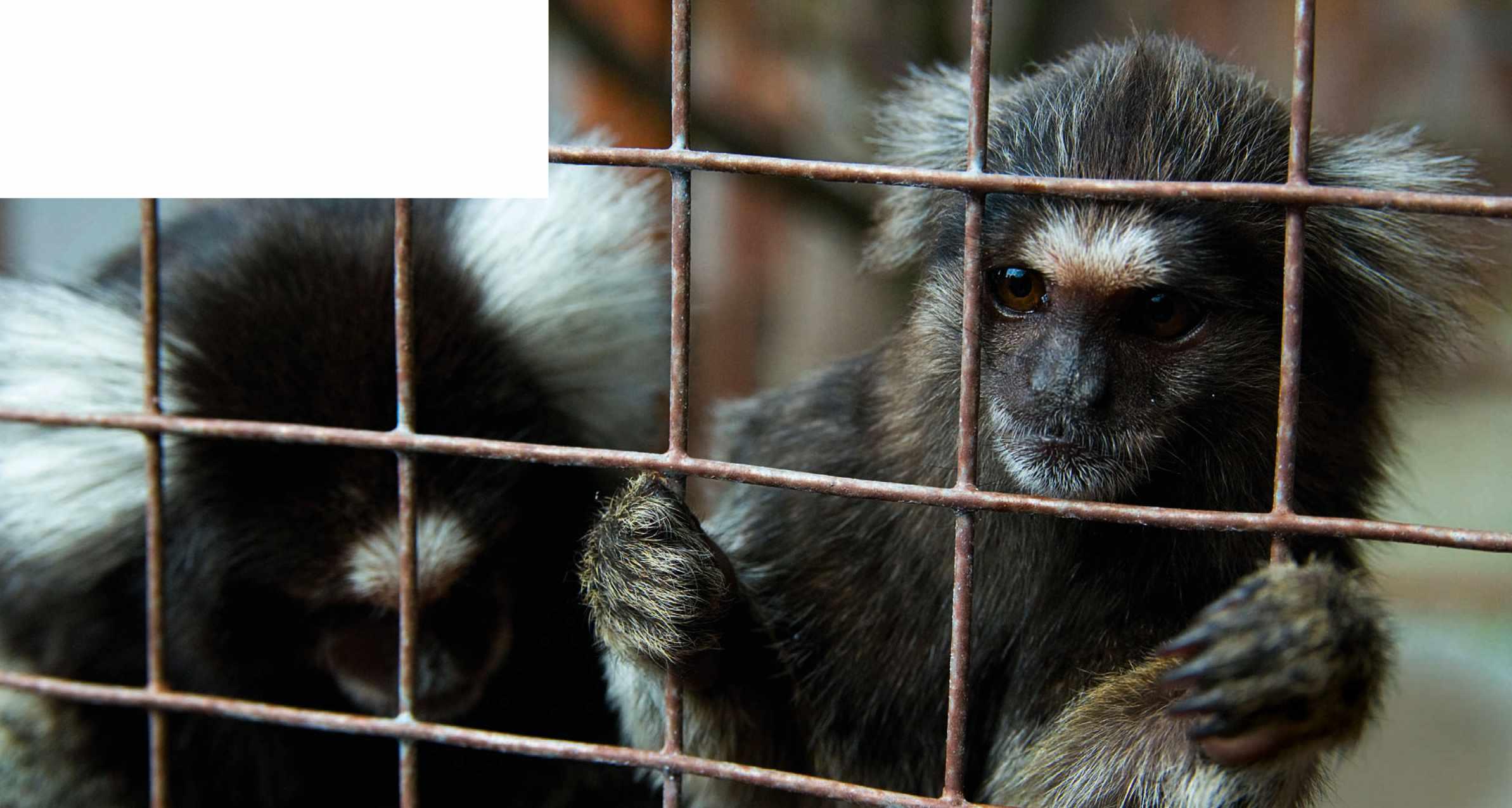
Welfare of primates set to improve as private keepers in England will soon require a licence
Following years of campaigning by the RSPCA, legislation introduced recently by the government will mean tighter future controls on the domestic keeping of primates. There are up to 5,000 pet primates in the UK, the most common being marmoset monkeys, which typify why primates make unsuitable pets. Marmosets are intelligent, social and long-lived creatures, more suited to group life, roaming free and eating a varied diet in South American forests. They also scentmark, spreading a musky aroma not welcome in a human home. A marmoset kept alone,
eating a limited diet in a small domestic space can suffer severe stress and other health problems. RSPCA inspectors regularly report seeing pet primates with behaviour problems and poor health, especially metabolic bone disease (rickets in humans) due to inappropriate care.
From April 2026, all private primate keepers in England will need to be licensed through their local authority, subject to an inspection of Ros Clubb, RSPCA head of wildlife
FROM THE BBC WILDLIFE ARCHIVE June 1983

animals and premises to assess welfare standards. Licensees will need at least one further inspection during a three-year period. If they fail to meet the same welfare standards found in zoos, they will face a fine or have the primate removed from their care. Effectively the legislation bans the practice of keeping primates as pets.
Acknowledging the government’s commitment to end domestic primate keeping, Ros Clubb, head of the RSPCA’s wildlife department, says she hopes this will “put an end to the shocking situations we have seen, with monkeys cooped up in birdcages, fed fast-food, sugary drinks and even class A drugs, deprived of companions of their own kind, living in squalor and suffering from disease.”

There is still a need, she adds, for ministers to set out how the welfare needs of monkeys will be met once the new law comes into force.
The Welsh government is now consulting on licensing private keepers.
Kenny TaylorSnail-watching was the subject of a five-page feature in the June 1983 issue of Wildlife. Curator of the Gilbert White Museum and keen conchologist June Chatfield covers all aspects of the lives of Britain’s 87 species of land snail, from their strange sexual habits to how they fix their shells. She even explains how to observe them feeding: “Bring home some snails and starve them overnight; then allow them to browse on a thin transparent plastic dish painted with a film of flour and water paste. You can see the rasping action of the radula and the rhythmic movement of the jaw through the bottom of the dish.”
ARCTIC TERN
By the end of May, these gorgeous birds will be nesting in Britain and can be seen fishing offshore

Join multi-award winning wildlife filmmaker Colin Stafford-Johnson on one of his personally guided tours to see some of the most amazing wildlife in the world on three very different journeys . Booking now for autumn 2024 and early 2025.
India Jungles and tigers
Botswana The Okavango Delta Guyana Rainforest, rivers and savannahs
For more information, drop Colin a line at adventureswithcolin@gmail.com or give him a call on +353 892032517

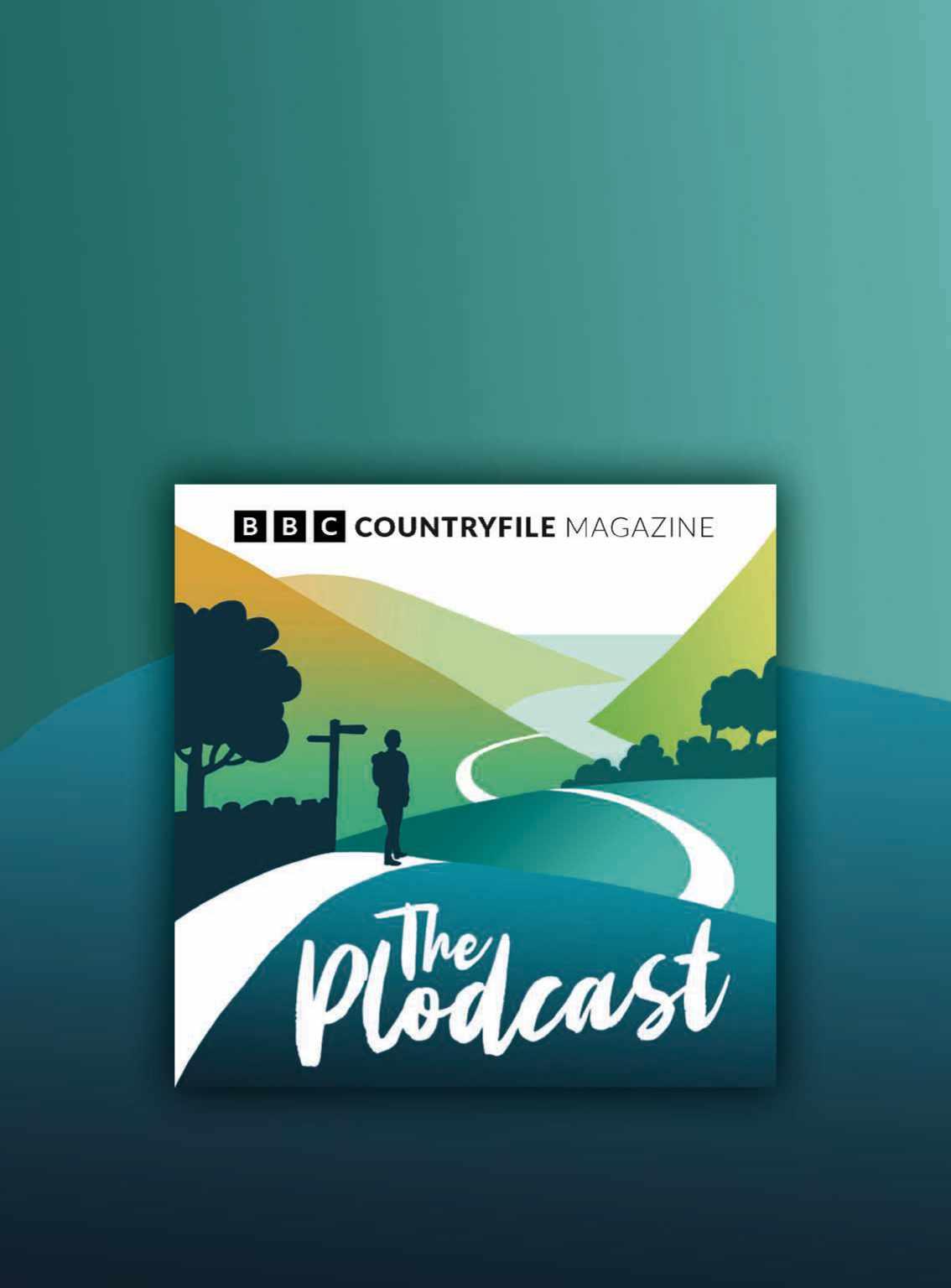
Your chance for a weekly adventure in nature and the countryside with the BBCCountryfileMagazineteam
You can find the Plodcast on all good podcast platforms
Our new podcast with top gardening guests

You can find Talking Gardens on Apple Podcasts, Google, Spotify, Acast and all good podcast providers. Subscribe so you never miss an episode.

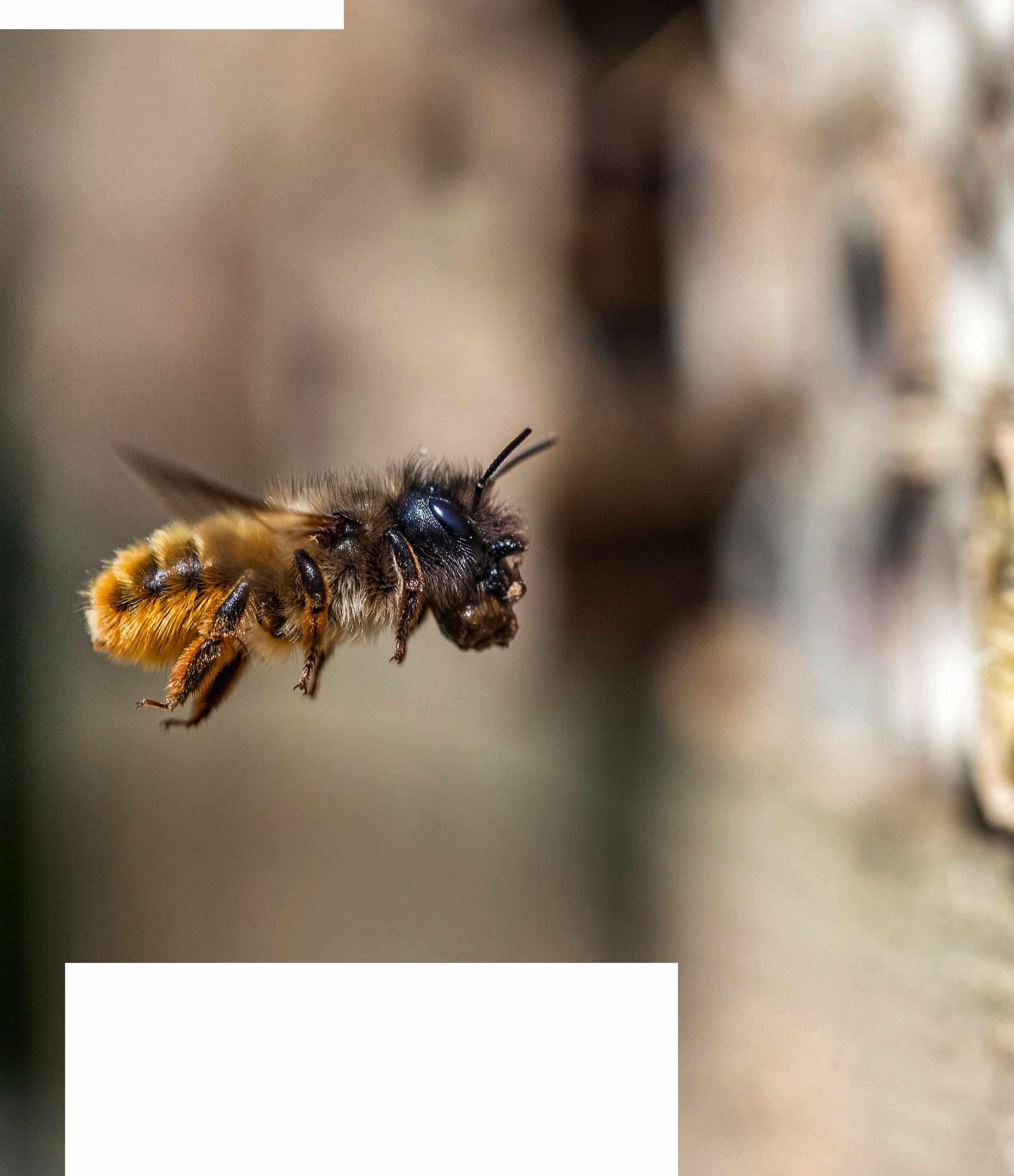
One bee to look out for this April is the red mason bee. It is common in towns and suburbia and resembles a small, gingery honeybee. The red mason is a kind of solitary bee, which means the female builds her own nest cells instead of living in a colony, like honeybees and bumblebees. In practice, that doesn’t mean she’s entirely on her own, since female red mason bees nest in loose groups. Their nesting requirements
are very precise: tube-like cavities around 7-8mm in diameter, normally in hollow plant stems or sandy banks.
It is easy to attract these beautiful bees to a garden or balcony simply by fixing cutdown bamboo canes to a south-facing wall – or buy a bee hotel. On sunny days in April, the female red mason bees will be emerging from hibernation and checking out suitable places to nest, so make sure you’re ready for them!
Ben HoareIn

While most North American mammal species are suffering declines, there is one species that bucks the trend quite dramatically, even in the face of intense persecution.
Coyotes are North America’s most oppressed animal – more than 400,000 are exterminated every year, 80,000 by the US federal government, which co-opts helicopters and snipers to shoot down this ‘pest’ species. Yet despite this lethal activity, numbers continue to rise.
Since the 1950s, these wily canids have increased their habitat by 40 per cent, more than any other North American carnivore. They can be found in every US state (apart from Hawaii) and from the far north of Alaska, they’ve even spread into Central America. A large part of their extraordinary success is a flexible approach to motherhood.
The coyote is a close relative of the wolf, albeit three times smaller – the average coyote weighs around the same as a standard Schnauzer. They are much hated by farmers, who claim they kill their livestock. The truth is these opportunistic eaters mostly subsist on far smaller prey such as rodents, rabbits and even reptiles. Coyotes are also not averse to plant matter and have even been known to climb trees to graze on berries.
A wide-ranging diet has certainly helped them colonise a variety of habitats, from deserts to prairies, mountains to cities. Coyotes also boast shrewd intelligence and high mobility – they can run at 64kph and cover large distances. But it is their family life that’s proved to be the real winner. Coyotes form monogamous pairs that mate for life. Their loyalty is such that death is the only reason a coyote will seek out a new
Catch up with Lucy’s three-part BBC Radio Four series, Political Animals
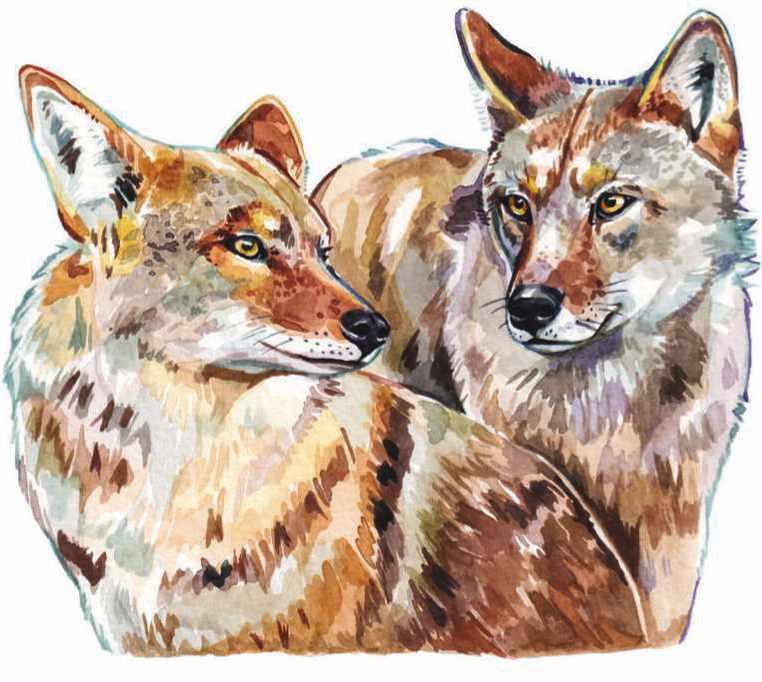
partner. The breeding pair hold alpha status in their family pack, which will hunt, den and range together. They can communicate using 11 known vocalisations – yips, howls, barks and grunts – that enable them to work as a team when bringing down bigger prey, such as deer, or defending their territory.
This cooperative lifestyle also extends to breeding. Coyotes reproduce just once a year and give birth in spring, producing an average litter of four to six pups. Though numbers vary according to location and food abundance, a litter of 19 was once recorded. When times are tough and resources low, young female coyotes delay reproduction and instead bide at home as helpers. These juvenile females babysit the alpha’s pups and help bring home food for their nursing mum. In areas of high resource availability, however, almost half will leave their natal pack and breed as yearlings. This flexibility allows rapid increase in numbers when times are good, contributing to their incredible resilience to persecution. Whether it helps them catch that pesky roadrunner, however, remains unknown.

Lucy is a broadcaster, zoologist and author of Bitch: What Does It Mean To Be Female? (Penguin paperback on sale now)
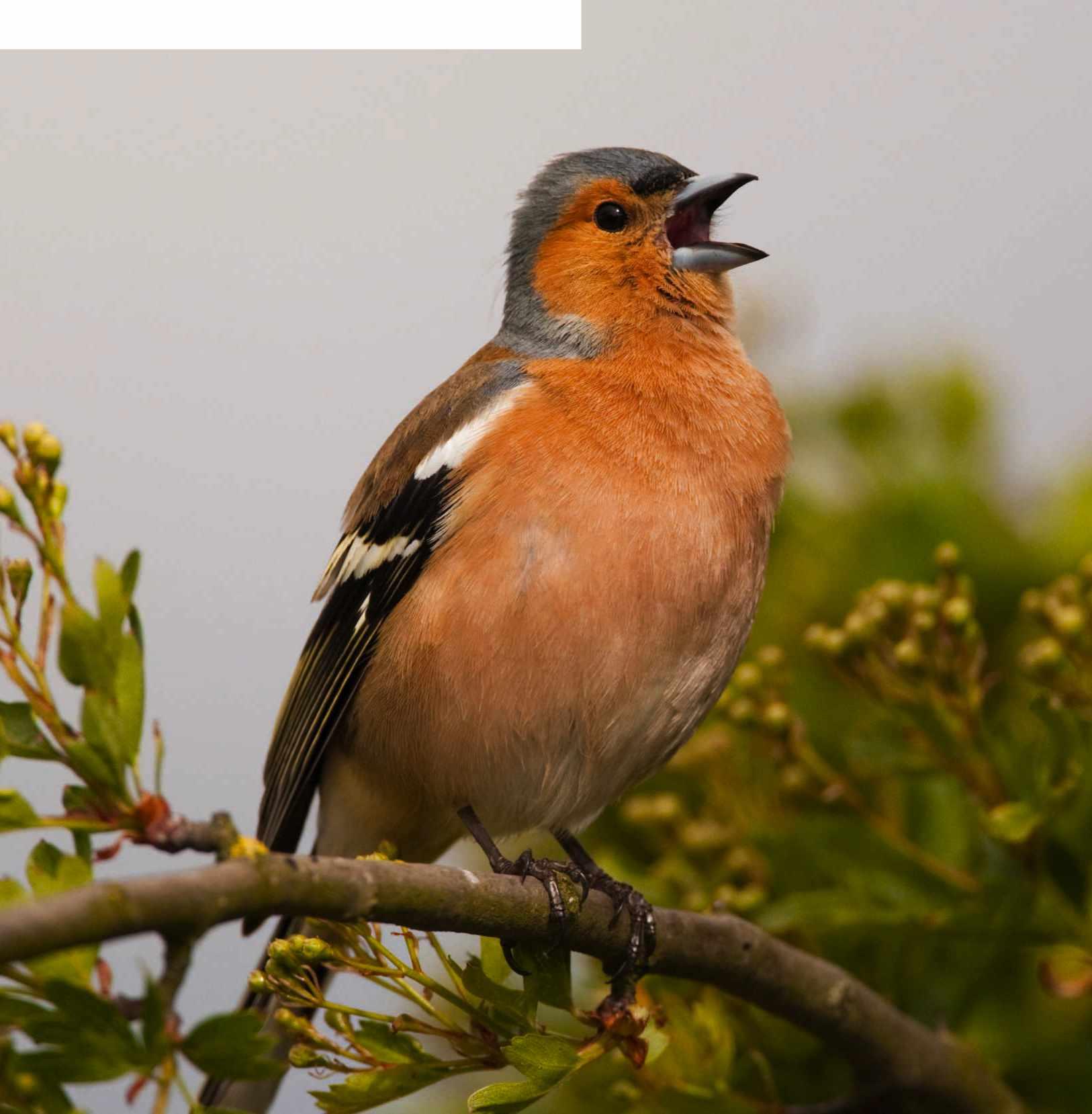
ID GUIDE
The stoat, with its long, slender body and black-tipped tail, is one of Britain’s most elusive animals. So count yourself lucky if you spot one in the flesh – instead, you may need to resort to field signs, such as droppings, to confirm its whereabouts. Stoats mainly feed on water voles, rabbits and other small mammals, so look for faeces containing bits of bone and hair. Like other carnivores, their droppings are thin with twisted ends, blackish brown in colour and deposited singly. Up to 8cm in length, they are longer and thicker than weasel droppings.
Chaffinches are noisy and usually heard before they’re seen
Among the most widespread small birds in Europe, chaffinches have been the subject of intensive study all over the continent, focusing on their vocalisations in particular. For example, we’ve discovered that male chaffinches deliver their cheerful song up to 3,000 times a day, sing with regional accents, and inherit bits of their song from their parents but pick up the rest by listening to other birds and learning on the job.
But one chaffinch call remains a mystery: a repetitive, monosyllabic whistle heard in spring. In H is for Hawk, Helen Macdonald captures it perfectly: “One interrogatory note over and over again, like a telephone call from a bird deep in leaves.” As it was once thought to foretell rain, we call it the ‘rain call’, but another theory is that the singer is frustrated – by poor weather, the loss of a nest or some other disturbance. Ben Hoare

Stoat droppings give off a neutral musky aroma



 MWILDLIFE SPECTACLES
MWILDLIFE SPECTACLES
The broadcaster, naturalist and tour guide shares the most breathtaking seasonal events in the world
The heights of the cliffs and canyons of the Andes is where to spot these mighty creatures
Animal superlatives always excite the enquiring mind. Questions such as what is the biggest, smallest, longest and fastest have long been a staple of the pub quiz. If recordbreakers are your bag, then the Andean condor – both the heaviest bird of prey and the raptor with the longest wingspan – needs little introduction. With a wingspan (for the record) maxing out at around 3.2m, and weighing up to 15kg, adult Andean condors have principally dark plumage and black primaries, or ‘fingers’, which contrast to their startlingly white secondary flight feathers and white ‘fluffy’ neck collar. They also possess naked, fleshy
So natural is the Andean condor’s soaring that one bird was found to have flown for five hours, covering a distance of 160km, without once flapping its wings.
heads, presumably a hygienic adaptation that allows them to delve into animal carcasses without their plumage becoming overly soiled by innards.
Andean condors are the only New World vulture to display sexual dimorphism. The bigger males have a large, dark red comb, or caruncle, on the crown of the head, that surely plays a key role when the time comes for this sexually monogamous species to find its life-partner.
As masters in the art of effortless soaring, it is up in the air where condors excel. Using a combination of wind gusts, currents of warm rising air and streams of air pushed upwards by cliffs and mountains, condors are able to spend hours on the wing, in a perennial hunt for carrion. So efficient is this


Condors are vultures, so they keep their sharp eyes peeled for the carrion that makes up most of their diet
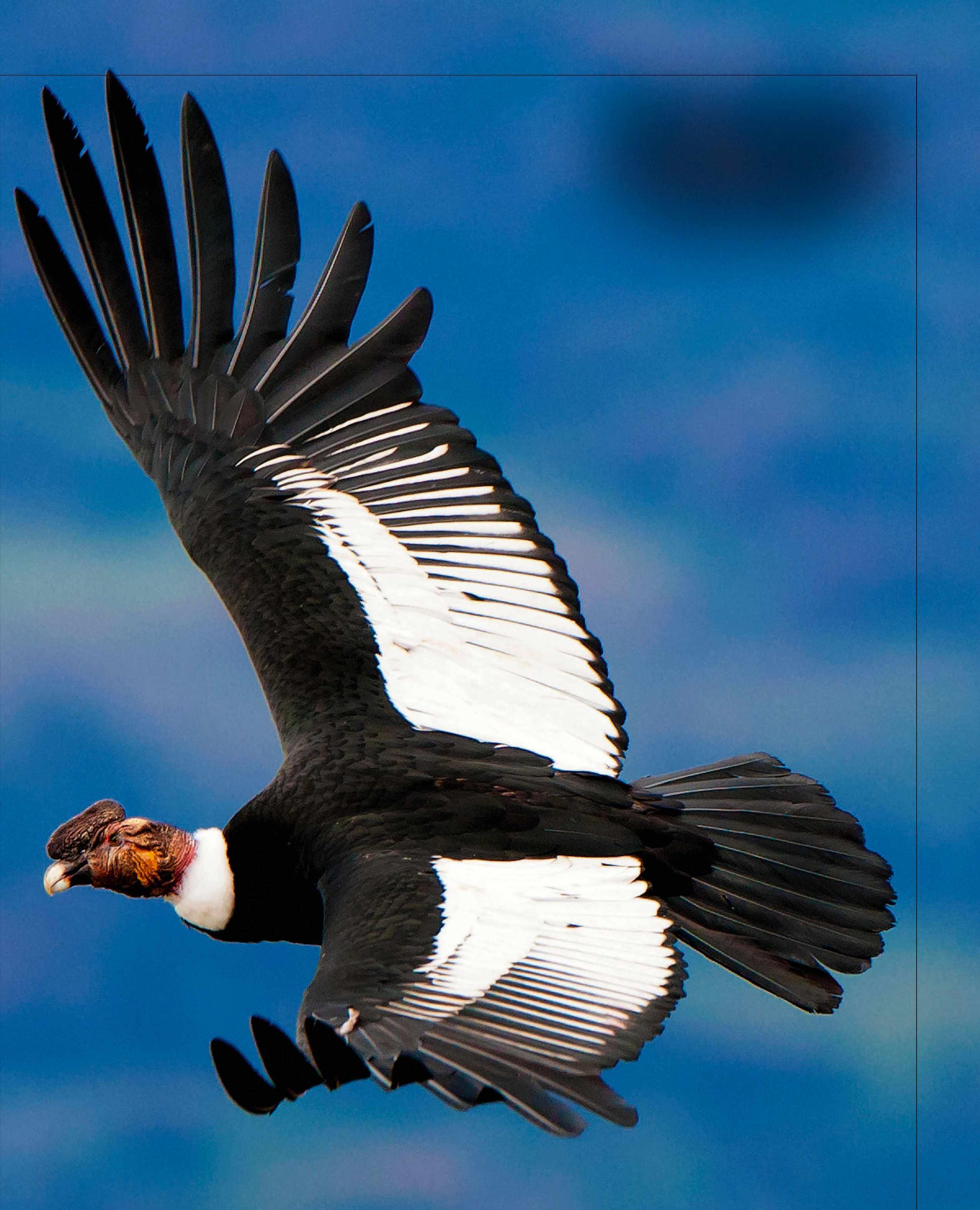
“As masters in the art of effortless soaring, it is up in the air where condors excel”
1COLCA CANYON, PERU
Well known as a dramatic place to watch condors, an April hike to the Mirador can result in seeing the birds at eye level, with the deep canyon as a backdrop.
5QUEBRADA DEL CONDORITO NATIONAL PARK, ARGENTINA An easy hike to North Balcony offers the chance to look down into the Condorito ravine and watch condors both flying past and roosting on the cliffs below.
2ANTISANA NATIONAL PARK, ECUADOR
Close to the capital of Ecuador, this relatively new reserve holds the largest population of condors in the entire country, with a total of 35 recorded across the park.
3TORRES DEL PAINE NATIONAL PARK, CHILE The Mirador at Cerro Cóndor allows incredible views over the three ‘torres’ and a chance to spot those condors with nests close by.
4EL CALAFATE BALCONY, ARGENTINA
This natural feature is a base from which to visit the Perito Moreno Glacier, but the balcony at Calafate also happens to be a terrific place from which to view condors at close quarters.
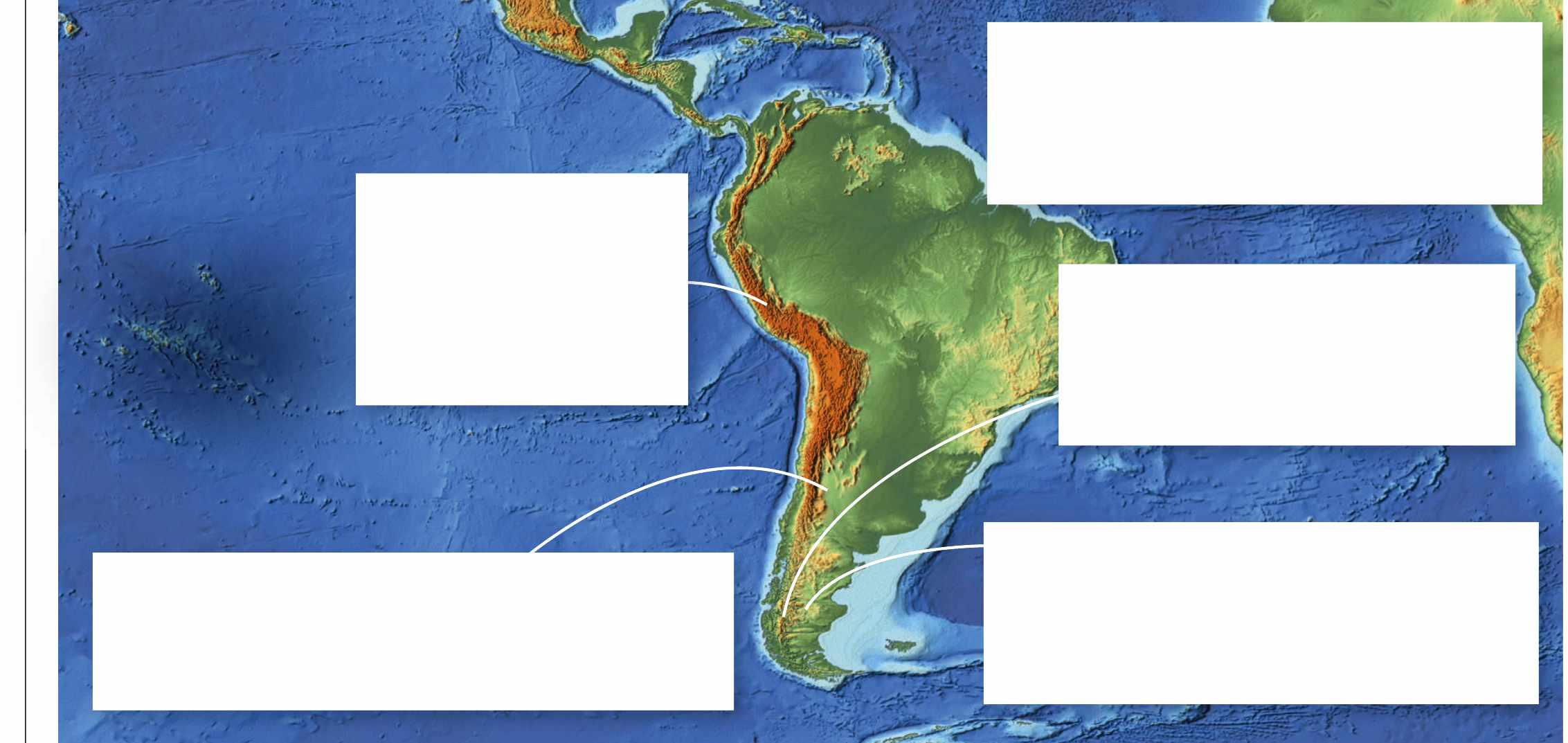
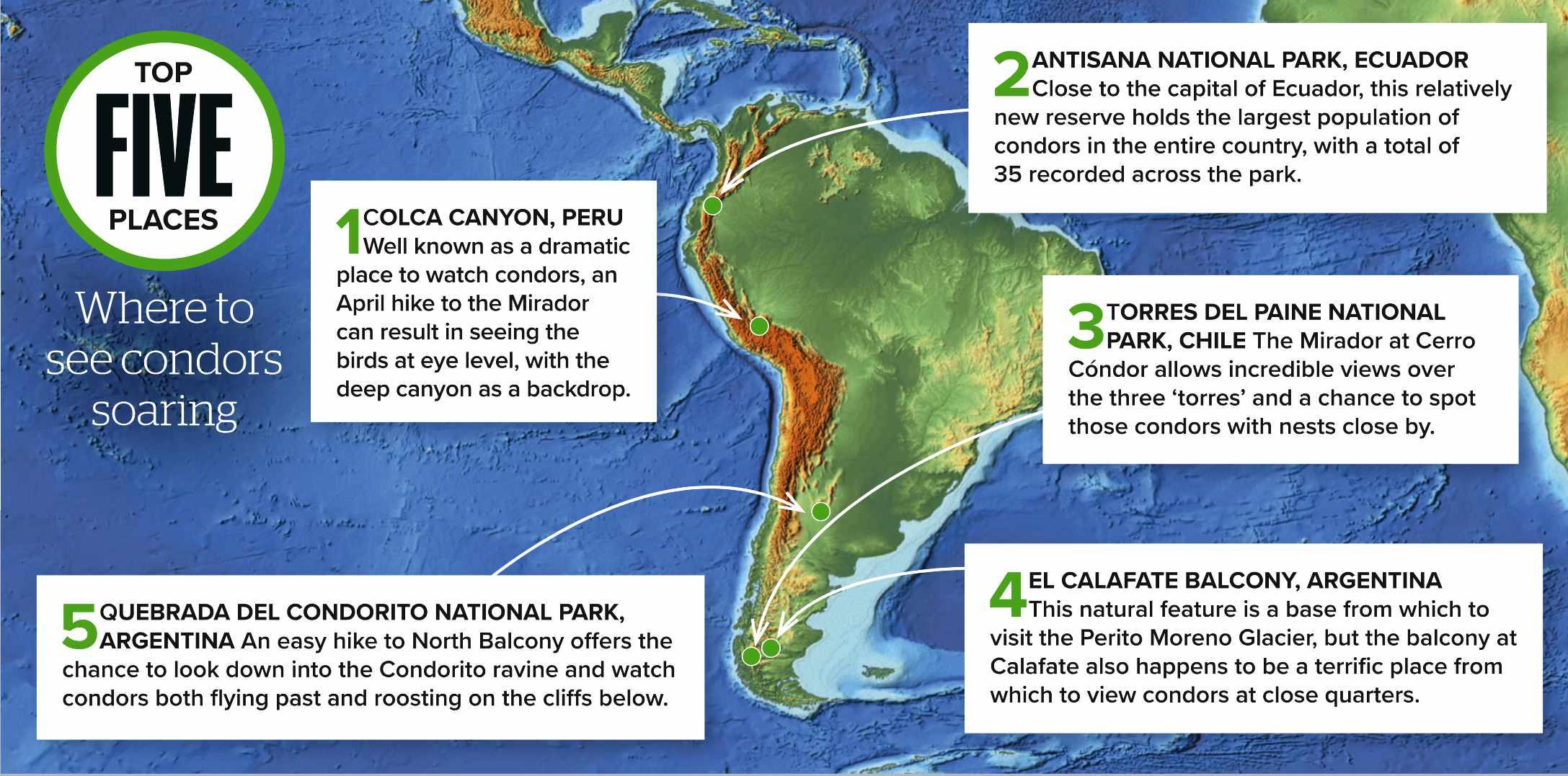
technique that equipment recently strapped to condors in Patagonia revealed that only one per cent of the birds’ time aloft is spent flapping their wings – with this mostly occurring during take-off.
Searching far and wide for food, condors use their razor-sharp eyesight to find a meal directly, or to locate large congregations of smaller raptors and scavengers, which invariably indicate a carcass. They most commonly feed on large carrion, with their food of choice historically being llamas, guanacos and rheas, but as these species have been displaced by farm animals, attention has shifted to cows, horses, sheep and goats.
bills to rip open the carcass. They must also realise that once the ‘big boys’ have had their fill, there will still be plenty to go round.
As carrion-feeders, condors and their scavenging cadre also play a key role as nature’s clean-up crew. This ‘recycling’ process both reduces the risk of dead and decaying animals becoming vectors of disease and helps to speed up the biodegradation process by microbes waiting in the wings.
“In South America the condor has been a cultural symbol for thousands of years”
Even if the condors are late to the party, they use and abuse their size to ensure they are first to tuck in, favouring the internal organs and muscles. Smaller scavengers may be shoved aside, yet they nonetheless rely upon the condors’ strength and hooked

Condors tend to roost communally, favouring remote caves, cliff ledges and rocky outcrops that are out of reach of ground predators. Usually covered in whitewash from the birds’ droppings, these roosting spots can stand out from a distance.
Despite a lifespan of up to 50 years in the wild, the condor’s slow reproductive rate (one chick every two to three years) and delayed maturity leave it remarkably susceptible to persecution. Illegal poisoning of carcasses remains a huge issue, with 34 birds killed in one incident in Argentina in 2018. Many farmers and ranchers perhaps see condors as little more than a pest species harassing their livestock, resulting in severe declines.
However, hope exists for the bird in the form of a reintroduction project currently taking place in Patagonia National Park. Environmental education programmes are also helping young South Americans renew their appreciation of a bird that has been a cultural symbol for thousands of years – just like the Incas, who honoured this supreme species in the 15th century with their Temple of the Condor at Machu Picchu.
The Andean condor is so revered across its range that it features on the national shields of four different countries: Bolivia, Chile, Colombia and Ecuador. Ecuador has gone a step further, placing the coat of arms on its flag. Here the condor, with its outstretched wings, is thought to symbolise power, greatness and strength.
By the time the single juvenile condor fledges from its home on a remote cliff ledge, its plumage will be smoky brown. Young birds then undergo a long, continual moult as their plumage darkens, but they still need an astonishing eight years before graduating to their parents’ black and white.
Adult condors have been observed defecating on their legs, which turn white. Either this helps to cool legs when temperatures rise during the day, or the guano, which contains traces of the bird’s digestive juices, operates as an antiseptic whenever the bird is thigh-deep in a rotting carcass. LOOK
Forever young, or so it seems
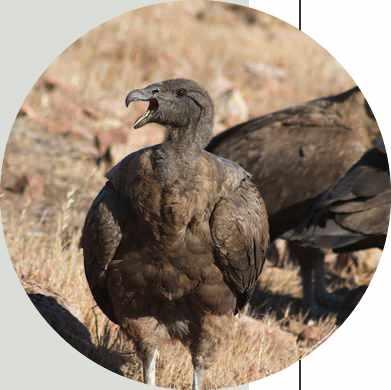

Mike checks out the dance moves of mating flamingos
Discover how
photograph animals and why photographing them matters to us and

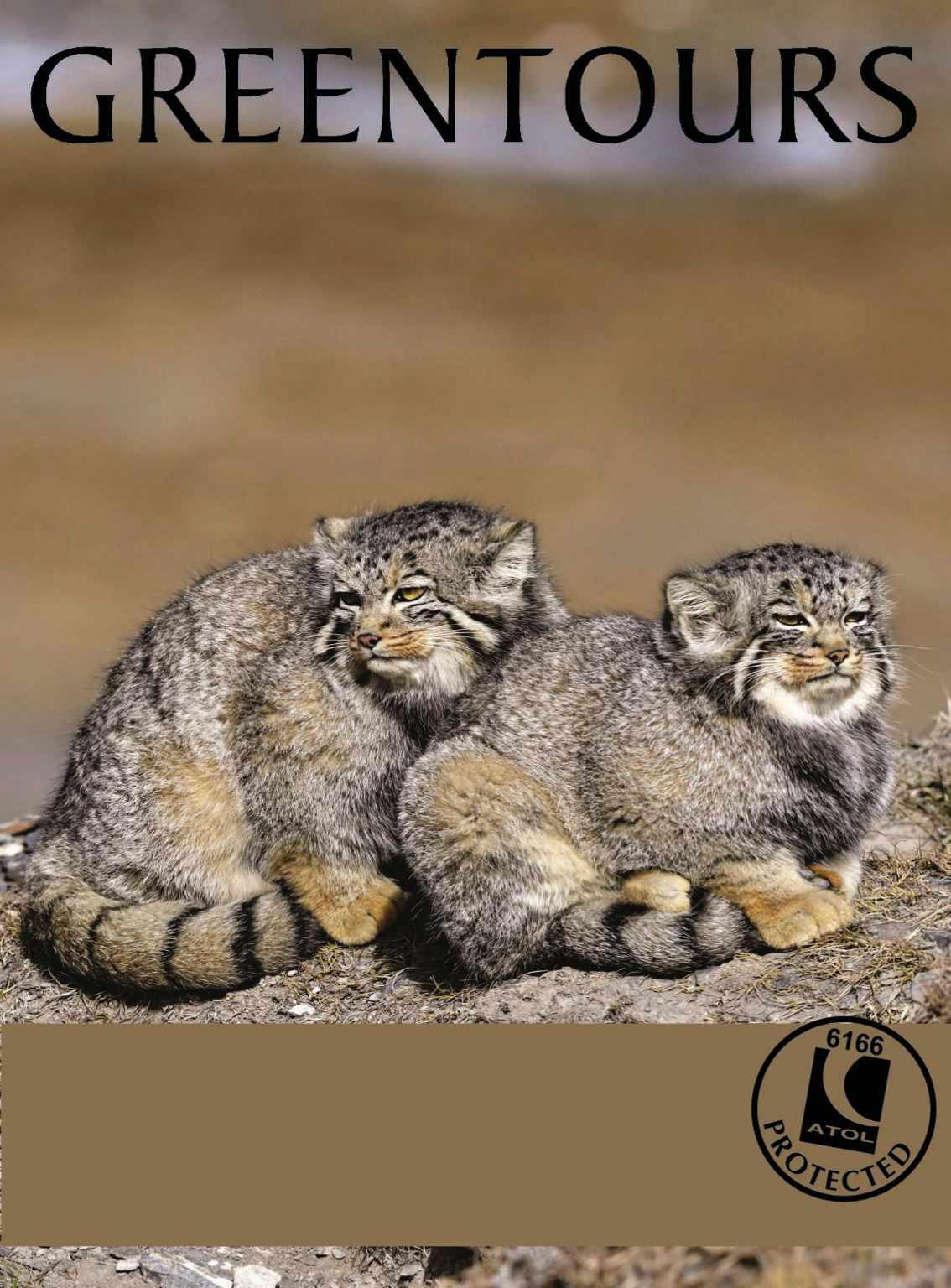

NO
Family safaris No single supplement safaris Birding safaris
Walking safaris Conservation safaris Photographic safaris
Ladies-only safaris Canoe safaris Safari honeymoons and weddings Horse and camelback safaris Green season safaris
Tailormade
Chad, Congo, Ethiopia, India, Indian Ocean, Kenya, Madagascar, Malawi, Mozambique, Namibia, Rwanda, South Africa, Sri Lanka, Tanzania, Uganda, Zambia, Zanzibar and Zimbabwe

WWW.TRACKSSAFARIS.CO.UK



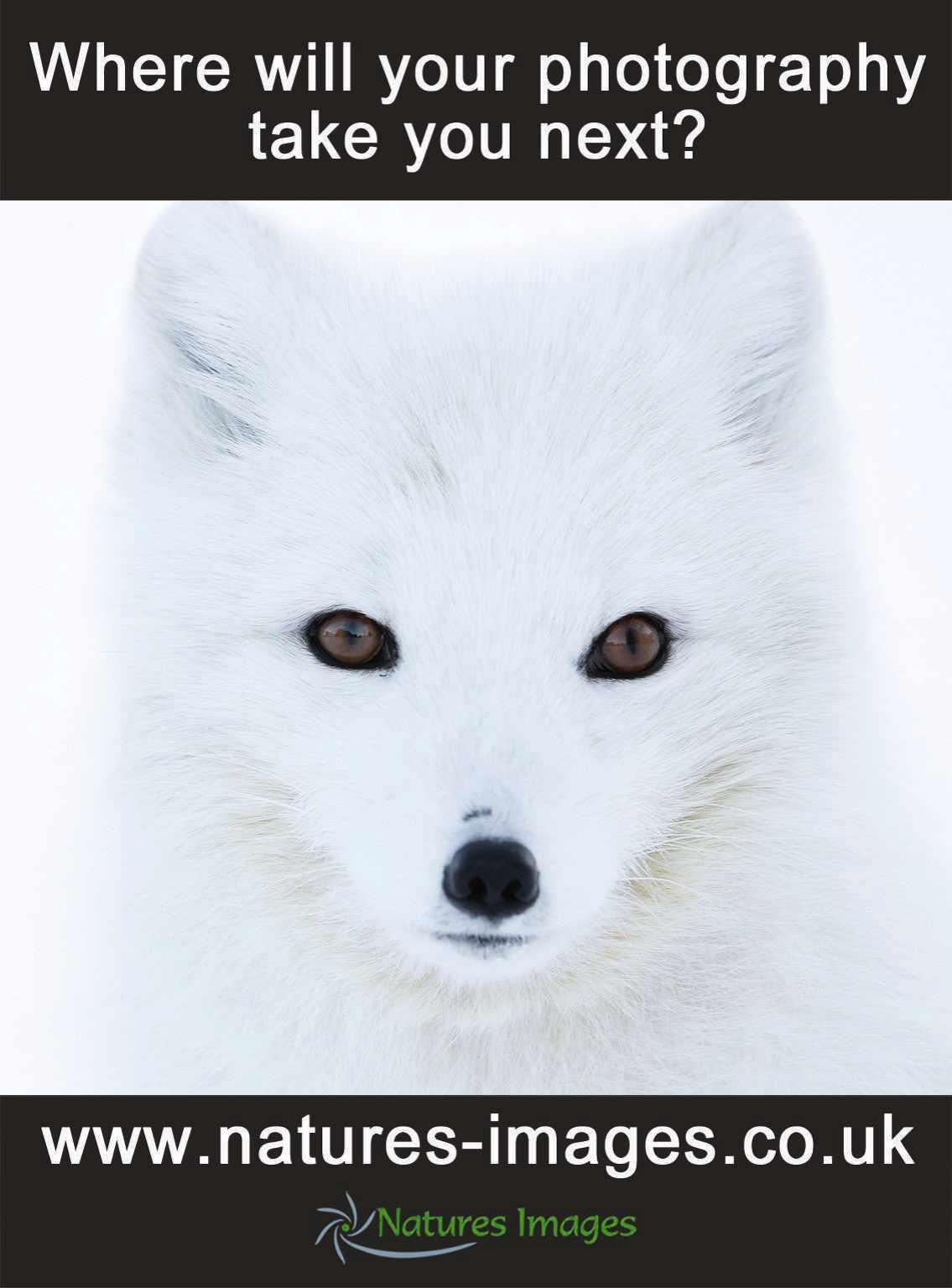

The popular naturalist, author and TV presenter reveals a secret realm of overlooked wildlife
Plop! A lizard leapt from the verdant foliage fringing a tropical stream and into the dappled pools below. It was a common occurrence as I traced my path along the banks, and sometimes I caught a glimpse. All skinny and scaled, these lizards were sometimes basilisk lizards, but more often they were even daintier anole lizards. I wondered what happened after they dipped below the surface, and if I had followed my curiosity, I may have noticed something quite amazing.
Anoles are an extremely successful family of lizards, with more than 400 species. They are found throughout the warmer regions of the Americas, almost anywhere you care to look. From urban shrubberies and gardens to wild, tangled, tropical forest, you will find an anole somewhere, hunting insects or sipping nectar from flowers.
These small lizards are easily overlooked. Many are brown or green, with bands and spangles of contrasting markings, and they are on the slim side, too – twiggy lizards in a world of twigs. The only time they catch the eye is when
the males of some species flash a brightly coloured chin flap, called a dewlap, at each other and potential mates.
Several species are closely associated with fresh water. The water anole (Anolis aquaticus) – whose name says it all – is one of these, never straying far from forest streams. Here, it makes an understated living, skittering after insects among a tangle of riparian roots, stems, leaves and rocks. Never reaching more than 7cm (excluding the tail), water anoles find themselves on the menu for birds, snakes and mammals – I’ve even found them tangled in the webs of orb spiders.
Other than lightning agility and exceptional camouflage, it turns out that these marvellous little lizards have yet another cunning way of evading capture that has only recently come to light. Dropping into the water is a common strategy in nature; many frogs do it, green iguanas do it, even pythons and nestling hoatzin birds do it. What sets the anole apart is that it can extend its subaquatic stay by more than a quarter of an hour by breathing underwater – or more accurately, re-breathing.

“Its air pocket allows the water anole to recycle missed oxygen”

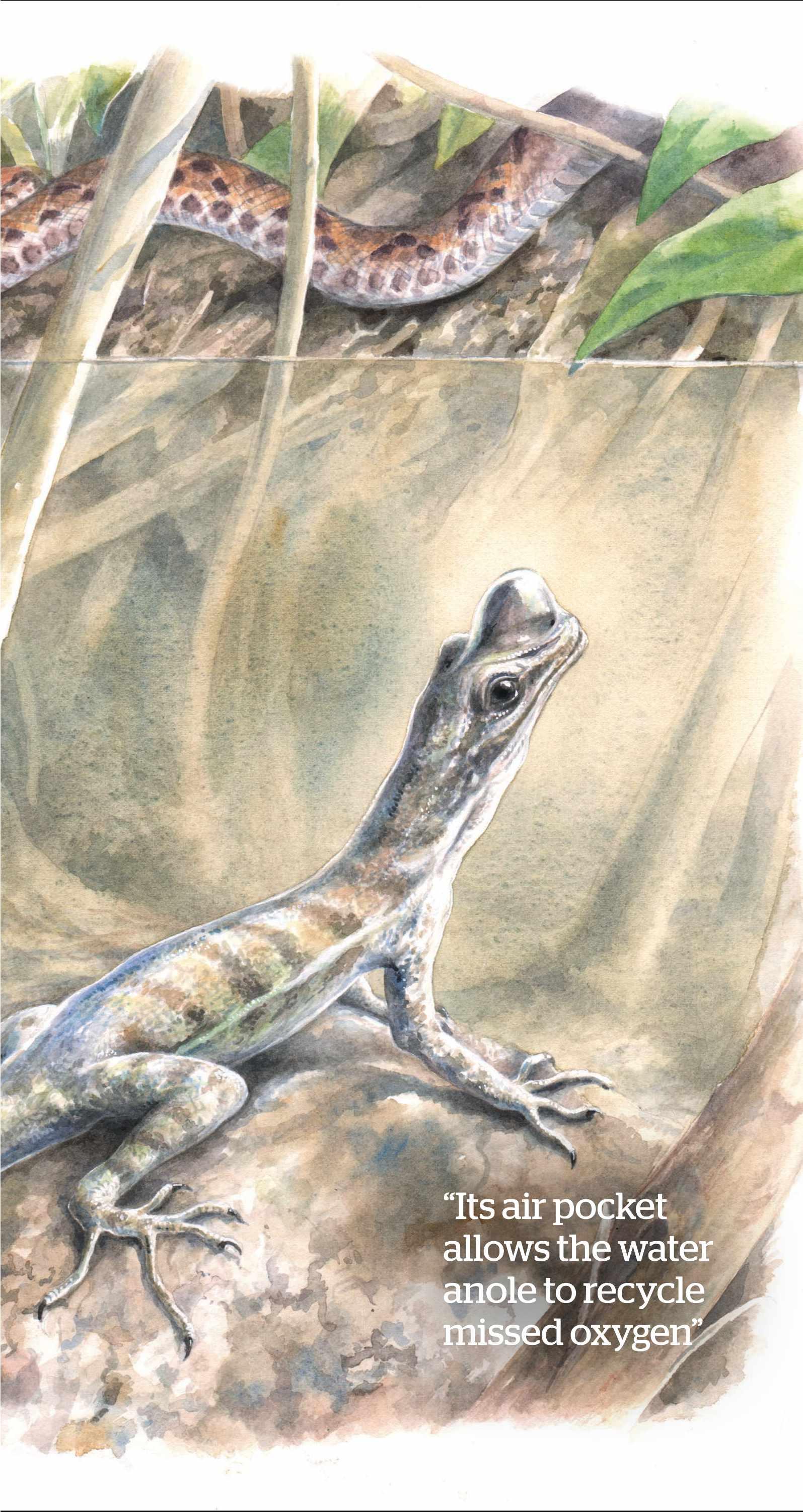
The moment the water anole submerges, it transforms into a mercurial lizard, enshrouded in a thin layer of air due to the rough texture and waterproof nature of its scaled skin. But it’s what happens next that is the really surprising bit. A bubble appears at the top of the head, over the snout. It expands, stretches, connects with the rest of the air pocket surrounding its body, and is then sucked back into the anole’s nostrils. Not one bubble escapes to the surface.
When a living creature inhales, oxygen enters the body and carbon dioxide, the waste product of our metabolism, is exhaled. However, not all the oxygen is extracted in each breath, so some remains in the exhalation. The water anole’s air pocket allows it to recycle this ‘missed’ oxygen. Some anoles will do this dozens of times in a single dive, recycling the air in the pocket and using the oxygen within.
It is also likely that due to the highly soluble nature of carbon dioxide and, to an extent, oxygen in water, the large surface area of the thin layer of air surrounding the anole also acts as a ‘plastron’ or physical gill, with carbon dioxide leaving the system and dissolving in the surrounding water, and oxygen the reverse. All of which enables the anole to sit it out at the bottom of the stream for a short spell until the threatening predator has moved on.
Anoles have a hierarchy with older, larger dominant males perching higher and nearer to the water than smaller juveniles.

The water boatman is able to dive
Taking the air
Several invertebrate animals also utilise a ‘plastron’ to extend their stay underwater. Well-known examples are pond beetles and water boatmen. Though they are aquatic insects, they don’t have gills. Instead they breathe in oxygen via air holes called tracheae along the sides of their bodies, and must replenish the oxygen in their plastron by coming back up to the surface.
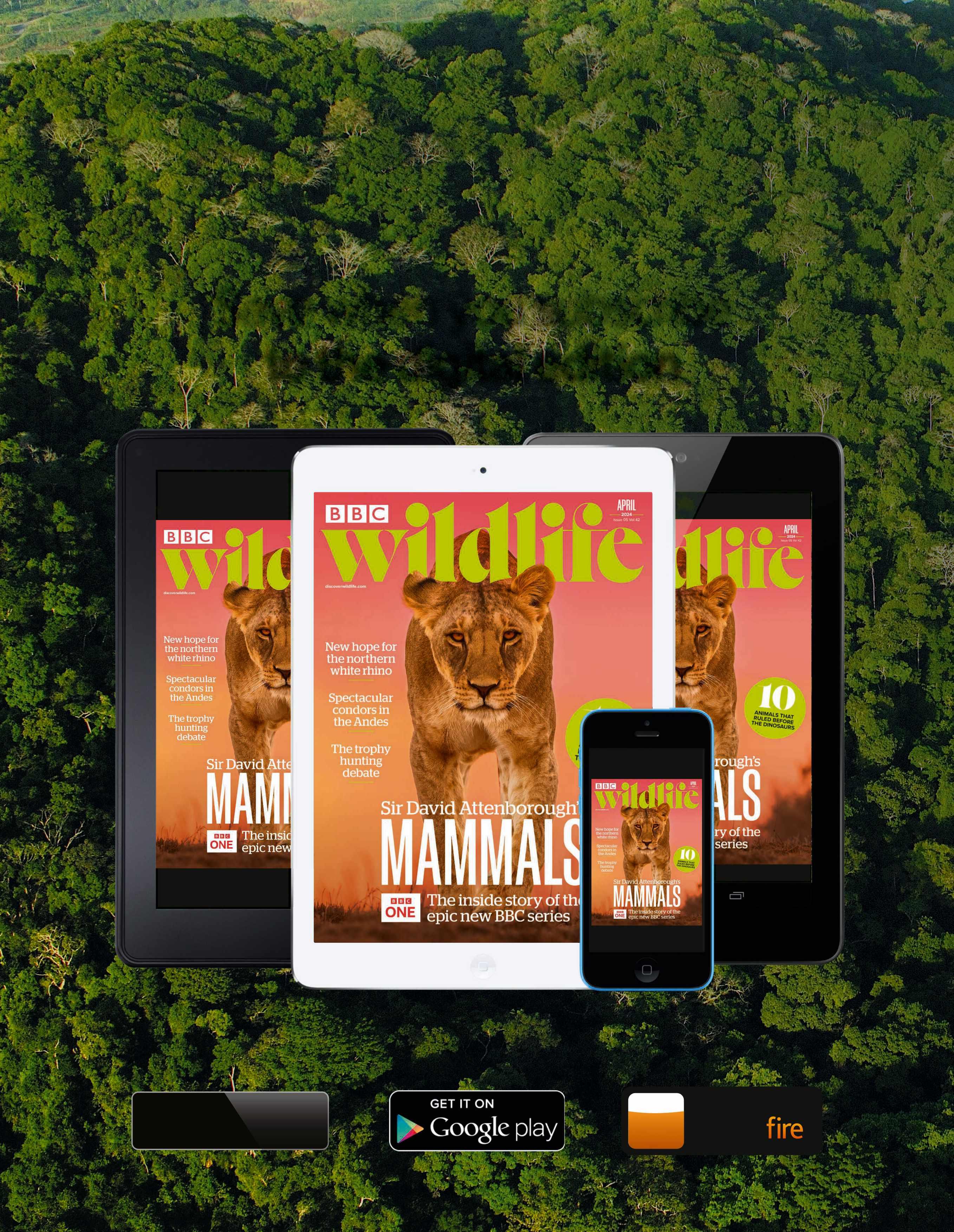



Mammals

The first episode of Mammals aired on 31st March. Catch up on iPlayer.
With the BBC series Mammals airing this spring, the series producer reveals how the crew captured some of our favourite animals in a whole new light
By SCOTT ALEXANDER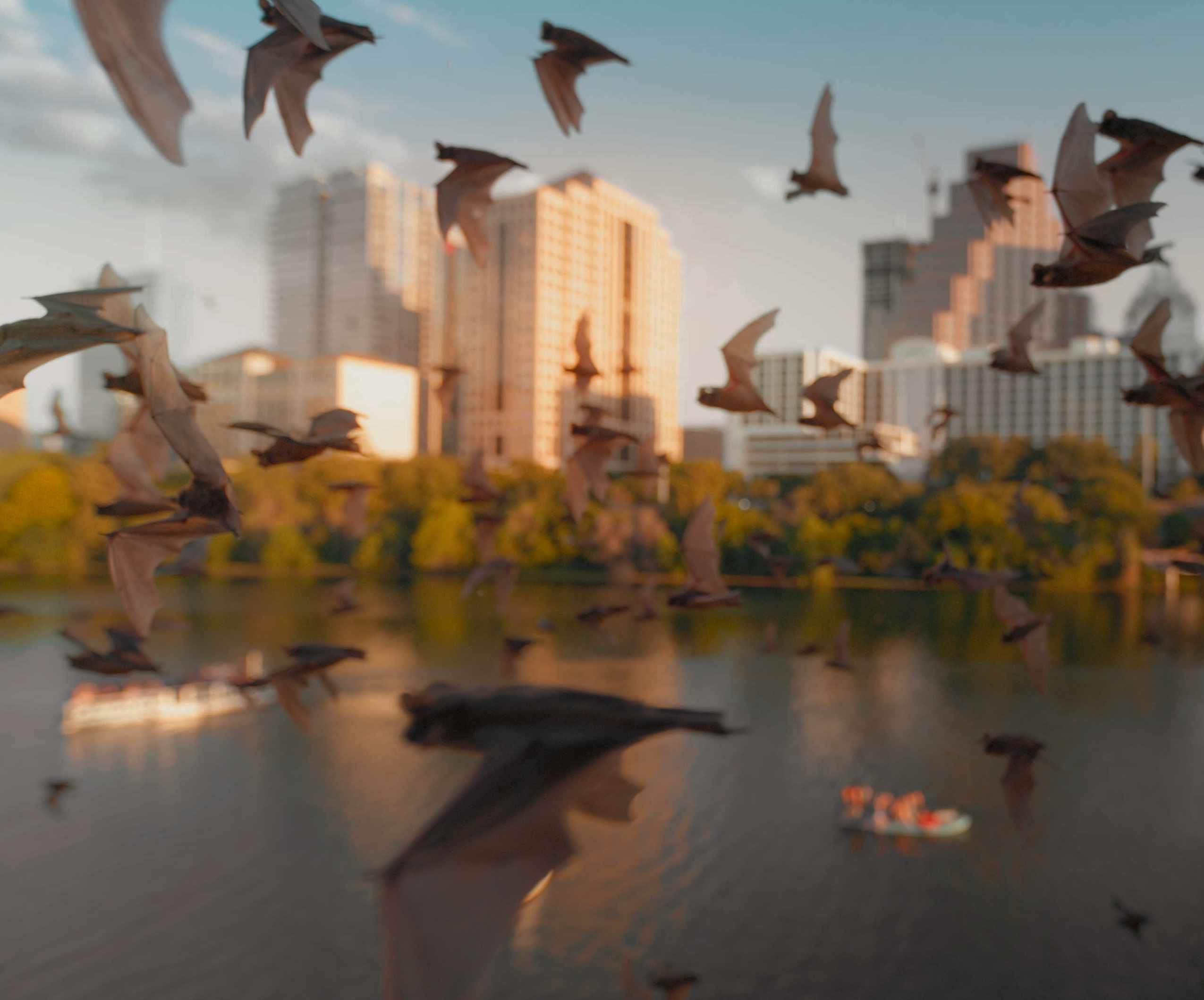
Ask anyone what their favourite animal is and chances are it will be a mammal. Lions, whales, dolphins, tigers, chimps, bears – they are all iconic. So being asked to make a new six-part BBC series about this extraordinary group of animals was a complete gift, and it’s fantastic to have Sir David Attenborough on board as the narrator. It’s been 20 years since he made Life of Mammals and the world has changed greatly since then.
In the city of Austin, Texas, more than one million Mexican free-tailed bats take to the

Of course, the fact that mammals are so popular means they have featured in many natural history series in the interim. Our challenge – and it was a big one – was to find new and interesting stories that could surprise and entertain an audience that might think they have seen it all. And the fantastically talented Mammals team always came up trumps. Whether it involved spending weeks shivering in a hide, riding out ferocious ocean storms, getting sandblasted in the desert or being robbed by South American bandits, they pulled out all the stops to capture never-before-seen footage and bring fresh characters to our television screens.
Take the wolverine. For many, it’s a creature of myth, a Marvel Comics character with superpowers; for others it’s a gnarly and ferocious mustelid. But Mammals reveals the reality of the species and the rarely seen caring side of parents raising a kit. It

While the city sleeps, Chicago’s 4,000 coyotes get to work
With heightened senses verging on superpowers, more than two-thirds of mammal species are creatures of the night. In the Kalahari Desert, Damaraland mole rats live underground in permanent darkness. Elsewhere, in America, coyotes have started hunting at night in the country’s busiest and biggest cities.

Today, the planet is changing faster than ever, and mammals must adapt if they are to survive in the new wild. An abandoned minefield provides Indian wolves with a sanctuary, out of reach of humans, while American buffalo have been given a helping hand: vast managed herds fill their ancestral plains once again.

turns out there was a good reason no-one had attempted to film a wolverine sequence before, though. They are notoriously elusive creatures and live in the coldest, harshest landscapes, such as the remote Alaskan tundra. I must admit, when producer Will Lawson suggested the idea, I wondered if he had lost his senses. But I also knew that this was exactly the type of challenge we should be taking on, despite the high risk of failure.
It took two shoots, more than 40 days in the field, multiple blizzards, many miles covered on snowmobiles, frozen equipment (and fingers) and endless days spent alone in a tiny hide before cameraman Neil Anderson at last managed to film the behaviour we were seeking –a male wolverine delivering pieces of caribou carcass to its young kit.
But we still hadn’t got the key shot we needed

“The hardest, most dangerous – and strangest – of all the shoots involved Indian wolves living in a minefield”
to complete the sequence. Having run out of time in the field, we were forced to leave our notoriously unreliable remote cameras behind in a last roll of the dice. Six weeks later, the camera cards arrived back at the Natural History Unit in Bristol. We had filmed – for the very first time – a mother wolverine leaving her snow den, followed closely by her adorable youngster.

On other occasions, we were able to capture not just the rarely seen nature of a wild mammal, but stunning new behaviour. Off the coast of Western Australia, the number of humpback whales giving birth has risen from a few hundred to tens of thousands, and it’s a phenomenon
that hasn’t gone unnoticed by the orcas that feed on their young. But their strategy – one orca distracts a mother humpback while others attempt to drown her calf – is not without risk. The huge, thrashing tail fin and large flukes of the defensive female can easily injure an orca. So, one small group has developed a new approach. They kidnap the calf, leading it away from its mother as quickly as possible, and only then do they attack. It’s a poignant moment in the series and a reminder of how tough nature can be.
One question I’m often asked is what’s the hardest or most dangerous thing to film? My usual answer is anything underwater, at night, in the dark or in extreme cold – so that covers just about everything in the

Cold, Water and Dark episodes of Mammals!
There was one hairy moment when a team managed to get their open-sided camera car stuck in warthog burrow and were swiftly surrounded by a pride of hungry lions. But the hardest, most dangerous – and strangest – of all the shoots involved Indian wolves living in an abandoned minefield from a war between Israel and Syria.
Even before we were on location, producer Lydia Baines and researcher Amy Downes had to complete a week-long ‘hostile environment’ training course. These are normally reserved for journalists entering war zones, and cover topics such as catastrophic bleeds and how to recognise minefields and avoid hostile crowds. Only once everyone was happy that we’d done everything we could to mitigate all the risks was the shoot signed off, and the crew departed to spend three weeks treading very carefully. As for the wolves, their keen sense of smell and ability to avoid the mines means that this unlikely landscape offers them a safe space to raise their young, away from the persecution that so many wolves still face around the world.
There are plenty of lighter, funny moments too. An amorous hairy armadillo seeking romance in an old milking parlour
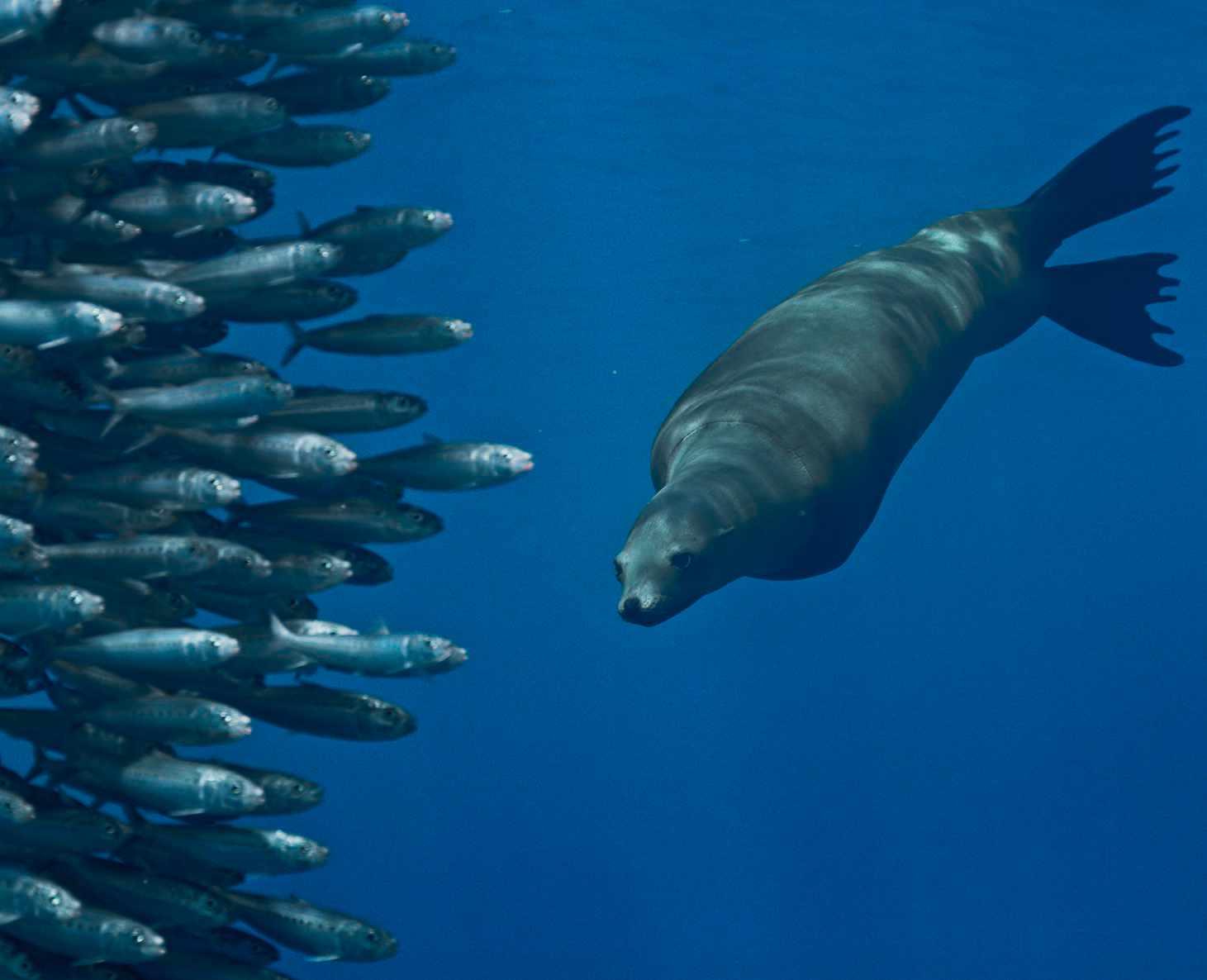
3
A Californian sealion pursues a sardine baitball off Mexico
From freshwater jungle ponds to the depths of the open ocean, mammals have found ways to overcome the many challenges of life in water. Follow a sperm whale as it chases its prey into depths far beyond that of any other air-breathing mammal and hungry Californian sealions pursuing huge shoals of sardines.
A wolverine kit takes its first steps outside the den with its mother

From ice-covered seas to snow-capped mountains, mammals have conquered the cold, living in the most inhospitable places on Earth. In Alaska, the mysterious wolverine tenderly raises its young, and on the Arctic islands of Svalbard, a polar bear leaves the coast in pursuit of reindeer.
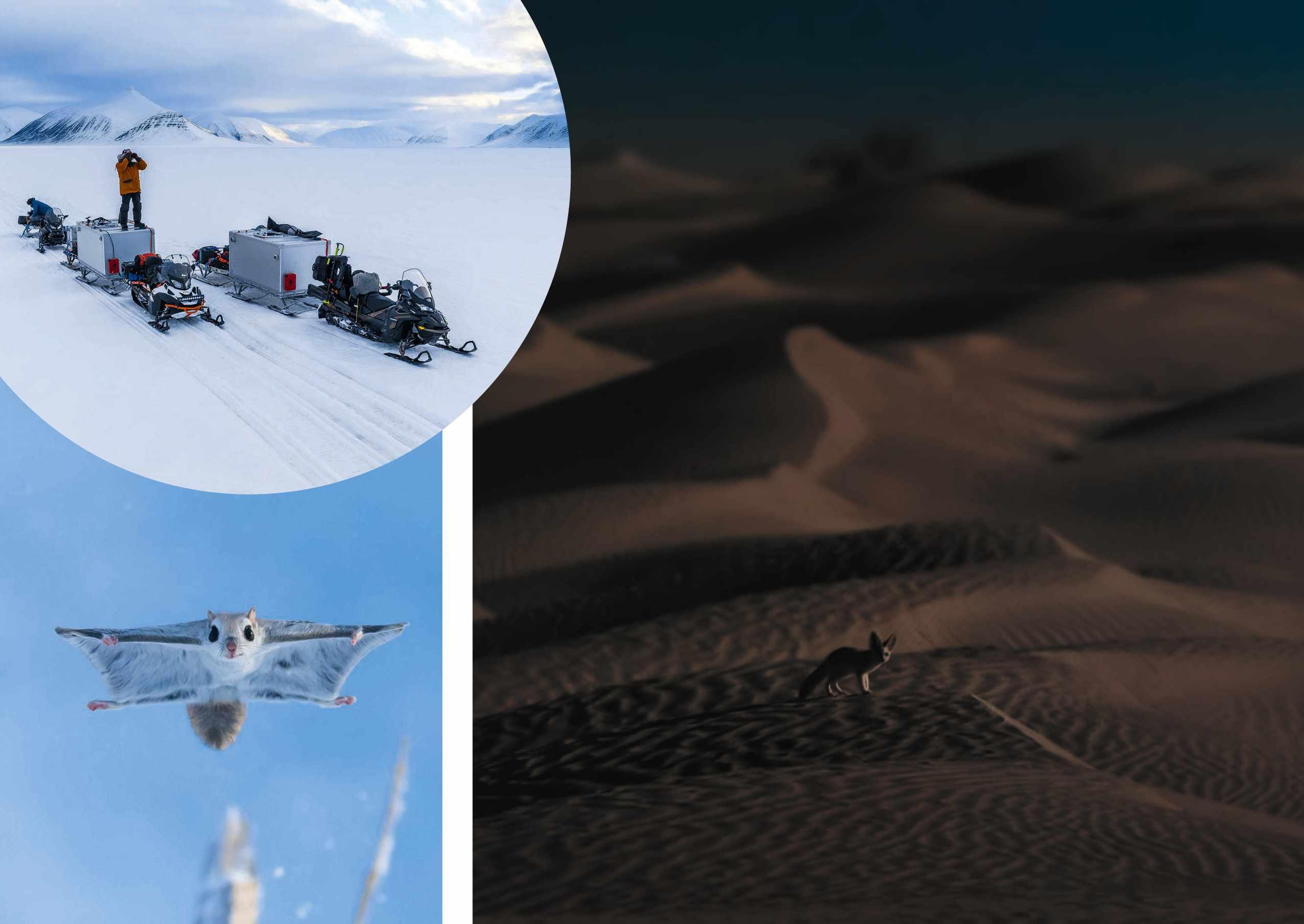
is one; echidnas blowing snot bubbles in an unusual way of cooling down is another. Perhaps my favourite scene from the series is when we witness a young chimpanzee hoping to get a taste of a real jungle treat – honey. The look of disappointment when the troop leader doesn’t share is one I’ve seen in my own children, and a reminder of how closely related we are to these wonderful animals.
Yet the series cannot shy away from the fact that since the arrival of humans, many mammals have become extinct – some directly at our hands, others indirectly as a result of pollution, global warming and habitat loss. Primates, including the great apes, are among the most seriously threatened, and we can’t ignore their stories. But some of those stories might not be quite what you expect.
When I heard of pig-tailed macaques in Malaysia learning to hunt rats in palmoil plantations, I knew we had to try and capture this never-before-filmed behaviour. We soon found ourselves in a hot, sticky, leech-ridden plantation dressed in brightorange, long-sleeved tops. The reason behind this strange uniform was that we hoped by wearing the same outfits as the researchers,
the macaques wouldn’t be too suspicious. It worked, because we soon witnessed them searching the base of palm fronds at the top of a tree, then flushing out their quarry, which they skilfully caught. The alpha male waited patiently on the ground below for any rats making a desperate leap for freedom, devouring his unfortunate victims headfirst.
Once thought of as a nuisance by the plantation owners, the macaques are now seen as a possible biological control, with one group catching around 3,000 rats a year. Without the dedication of local experts, scientists and research teams, we wouldn’t be able to find fantastic new stories like this.
Wild mammals are increasingly living in close proximity to humans, and a cheetah hunt from the series epitomises this dynamic. I have filmed cheetah hunts on many occasions, but not like this. At one
point, we saw around 70 tourist vehicles surrounding the kill, which can have a devastating impact on cub survival rates. Millions of people visit Africa’s national parks every year, bringing much-needed revenue that supports wildlife, but we are at risk of losing the very animals we’ve come to see. Such scenes aren’t often shown in glossy wildlife shows, but I wanted to have this unfiltered approach, without pointing fingers or lecturing the viewer.
Some of the most enduring images from the series are from sequences where mammals and humans co-exist. Dark features one of the most beautiful wildlife spectacles on Earth, as more than a million Mexican free-tailed bats fly out from under the Congress Avenue Bridge in Austin, Texas.
“We filmed bold sealions strolling around fish markets and otters frolicking in fountains”


There are more bats than people living in the city and they draw an appreciative crowd. Elsewhere, we filmed wily coyotes moving back into urban areas under cover of darkness, bold sealions strolling around the fish markets of Chile and otters frolicking in the fountains of downtown Singapore.
The adaptability of mammals has made them arguably the most successful animals on the planet, but today their lives lie in the hands of just one – us. By showing just how remarkable they are, I hope we can learn to appreciate them and find that delicate balance that lets us share this incredible planet with its incredible diversity of life.

Scott Alexander is BBC Studios’ Natural History Unit series producer on Mammals. He has worked on series such as Big Cat Live and Seven Worlds, One Planet with Sir David Attenborough.
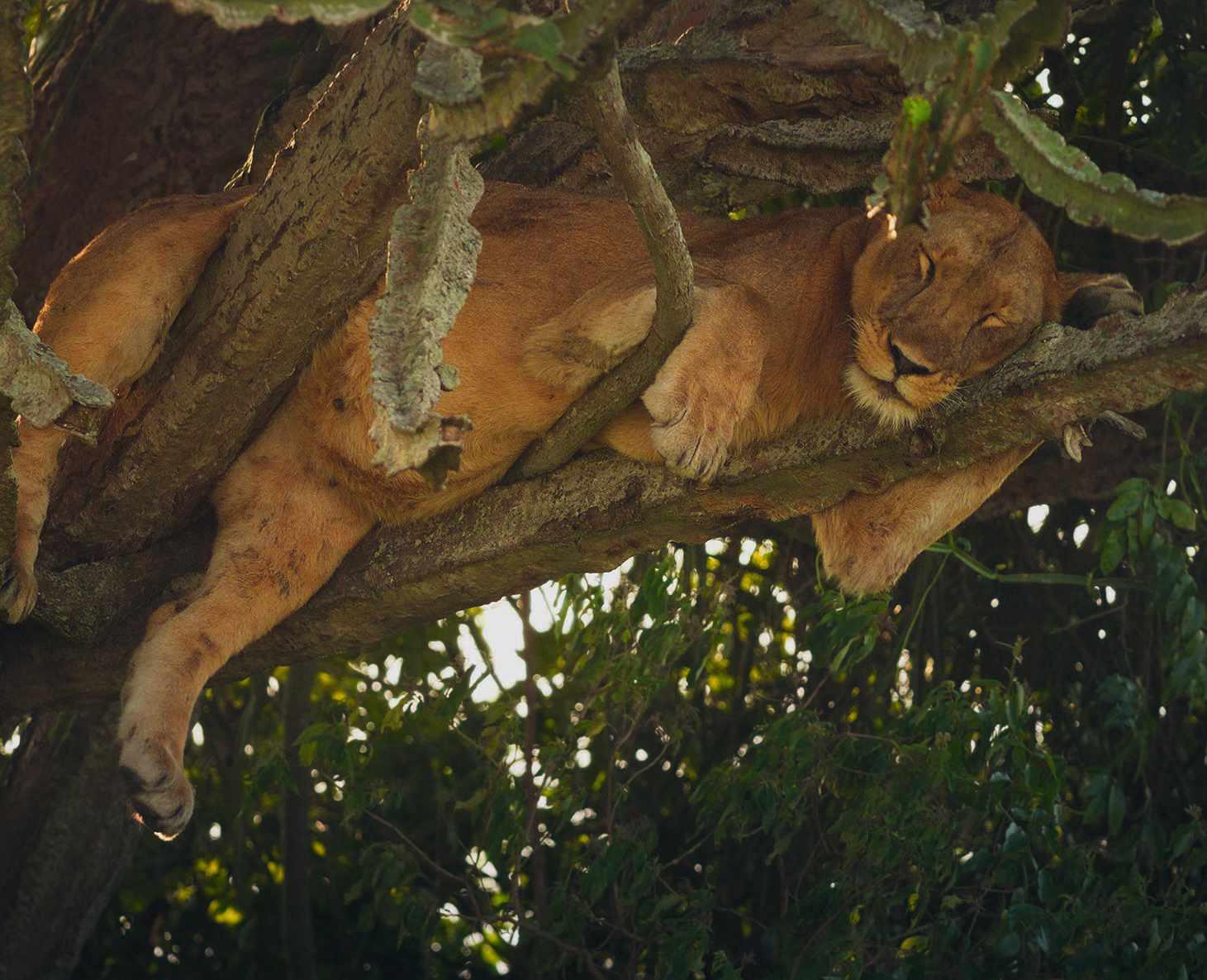

IVF is providing one last chance to save the northern white rhino from extinction
Photos by JON A JUÁREZ
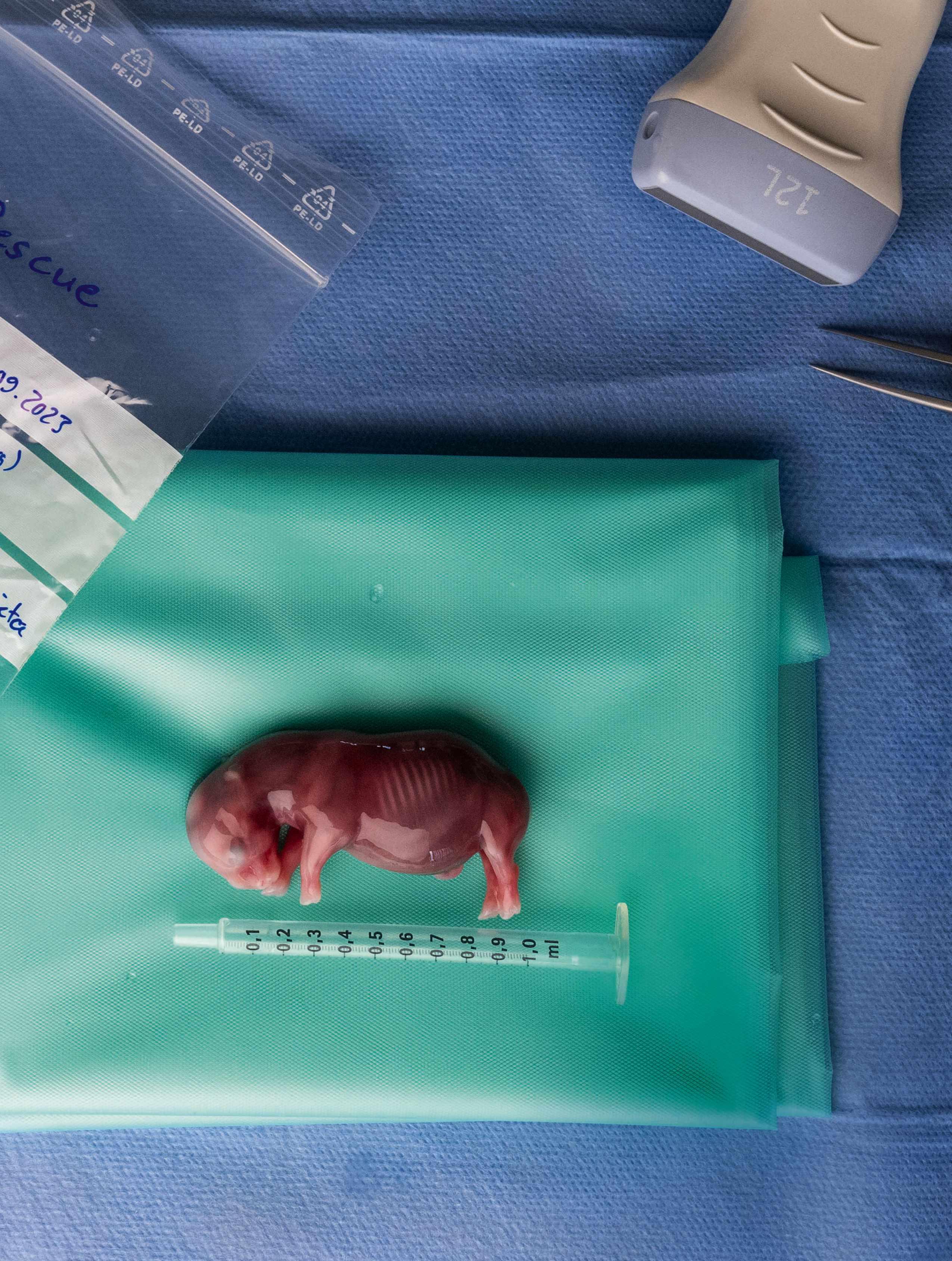
Though it died at just 70 days old, this tiny southern white rhino foetus offers hope. The baby was the result of the first successful attempt to perform IVF on a rhino, carried out by scientists from the BioRescue project in September 2023. The unborn calf had been developing well, but its mother, Curra, died from an unrelated bacterial infection. Now that the procedure has been proven to work, it can be applied to the northern white rhino, potentially helping to save this subspecies from extinction.
The northern white rhino population has been decimated by poaching. Only two individuals remain, a female called Najin (age 34, above), and her daughter, Fatu (age 23). The pair live in Kenya's Ol Pejeta Reserve under constant guard. For reasons of age and health, neither can carry a pregnancy to term, so any IVF procedure will use Fatu's eggs and a female southern white rhino as a surrogate.
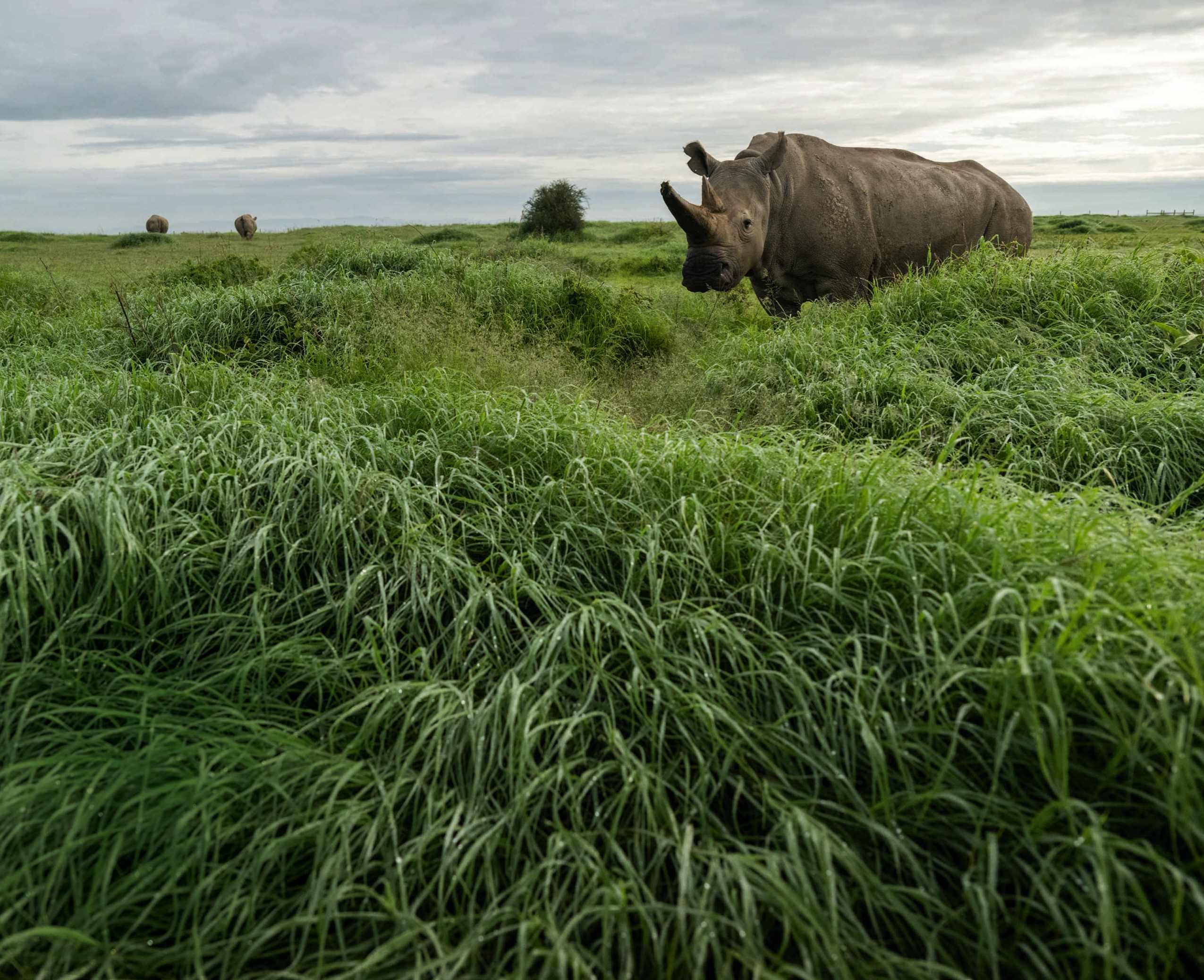

IVF, though well established in humans and domestic animals, is incredibly complex in wild species, particularly large animals such as rhinos. As such, ethical risk assessments are implemented for every step of the procedure. Curra's successful implantation was the lucky 13th attempt at IVF in southern whites.
Jon A Juárez is a photographer with a degree in biology and a keen interest in conservation. He is a member of the German Society for Nature Photography. See more of his work at highwaysandbyways. de; jonjuarez.photo.


The last northern white males, Suni and Sudan, died in 2014 and 2018 respectively. This memorial at Ol Pejeta is dedicated to them, and to all rhinos killed by poaching.
A male southern white rhino called Ouwan, the ‘teaser bull’ for Curra's implantation, undergoes a health check. A teaser bull is a sterilised male that detects when a female is fertile, thus signalling the best time for her to be artificially inseminated. Ouwan died in November 2023, three days before Curra. Both fell victim to serious infection after heavy rain reportedly released bacteria from the soil in their enclosure.
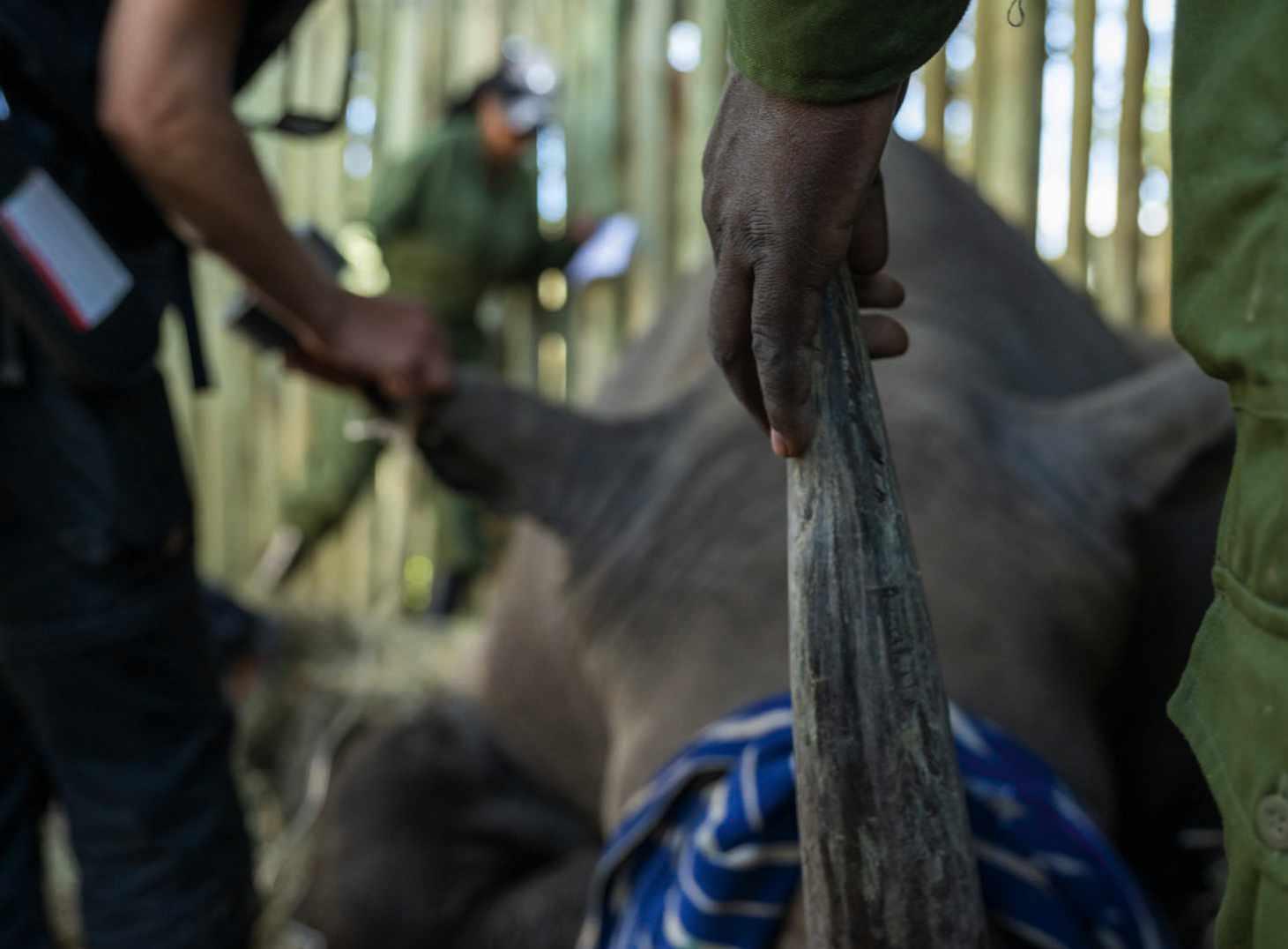

Curra receiving a health check from Thomas Hildebrandt, head of BioRescue, which determined that she was ready to receive the embryo. The sperm originated from a male called Athos from Salzburg Zoo in Austria; the egg from a female called Elenore from Pairi Daiza Zoo in Belgium.
Scientists from BioRescue study egg cells harvested from Fatu. The science of rhino IVF is entirely new ground – all the veterinary and scientific procedures, from sperm injection to storage to use of liquid nitrogen, and all protocols, methods and equipment have had to be developed from scratch. It has taken years of research to get to this point.

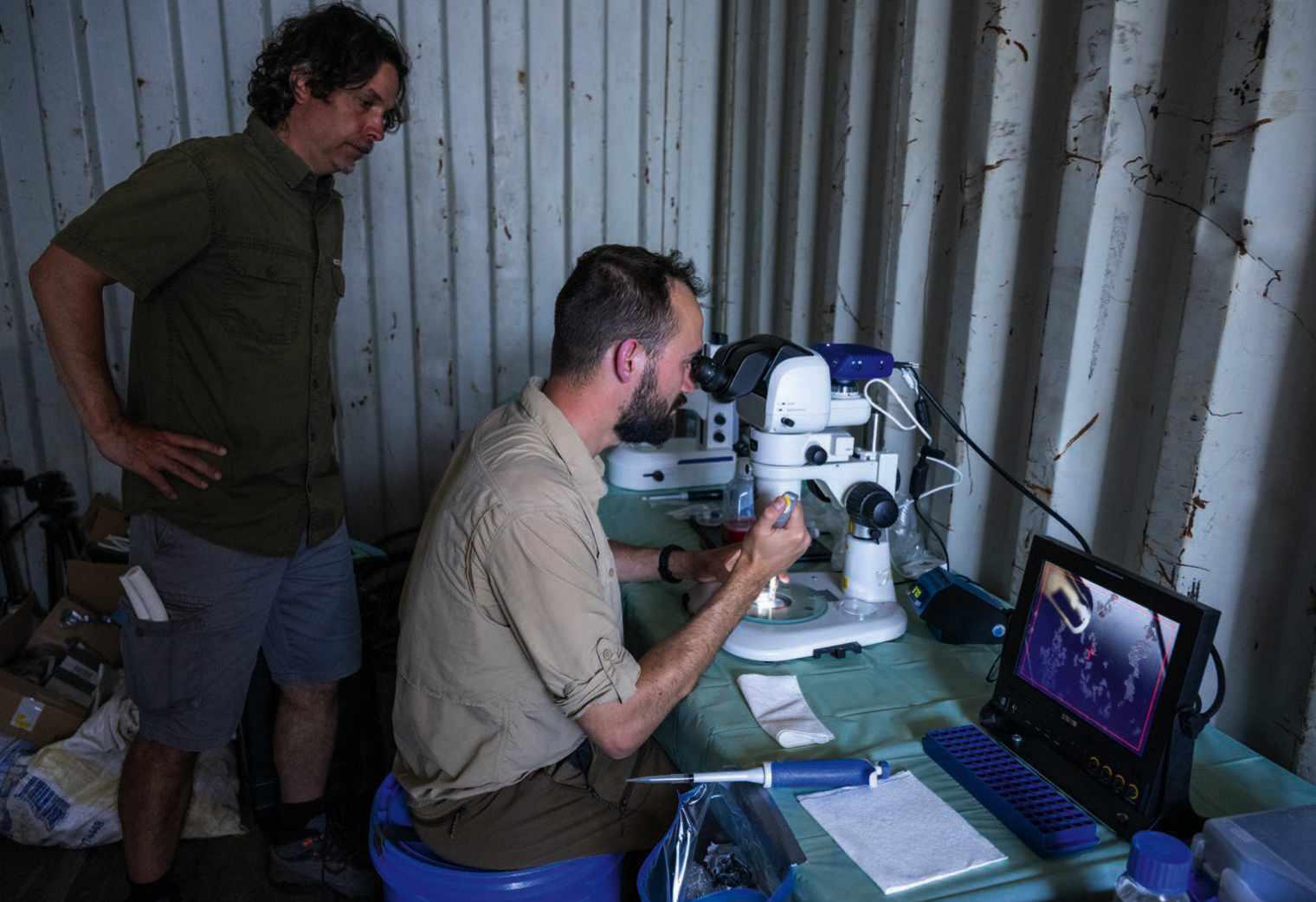

Najin undergoes a standing sedation procedure during a regular health check. As an experienced female, she will play an important role in transferring knowledge to any northern white rhino calves born through IVF.
Twelve previous attempts had been made at southern white rhino IVF over the years. One took place in January 2021 at a zoo in Germany. The surrogate was a female called Clara, who is here being sedated before receiving the embryo transfer.
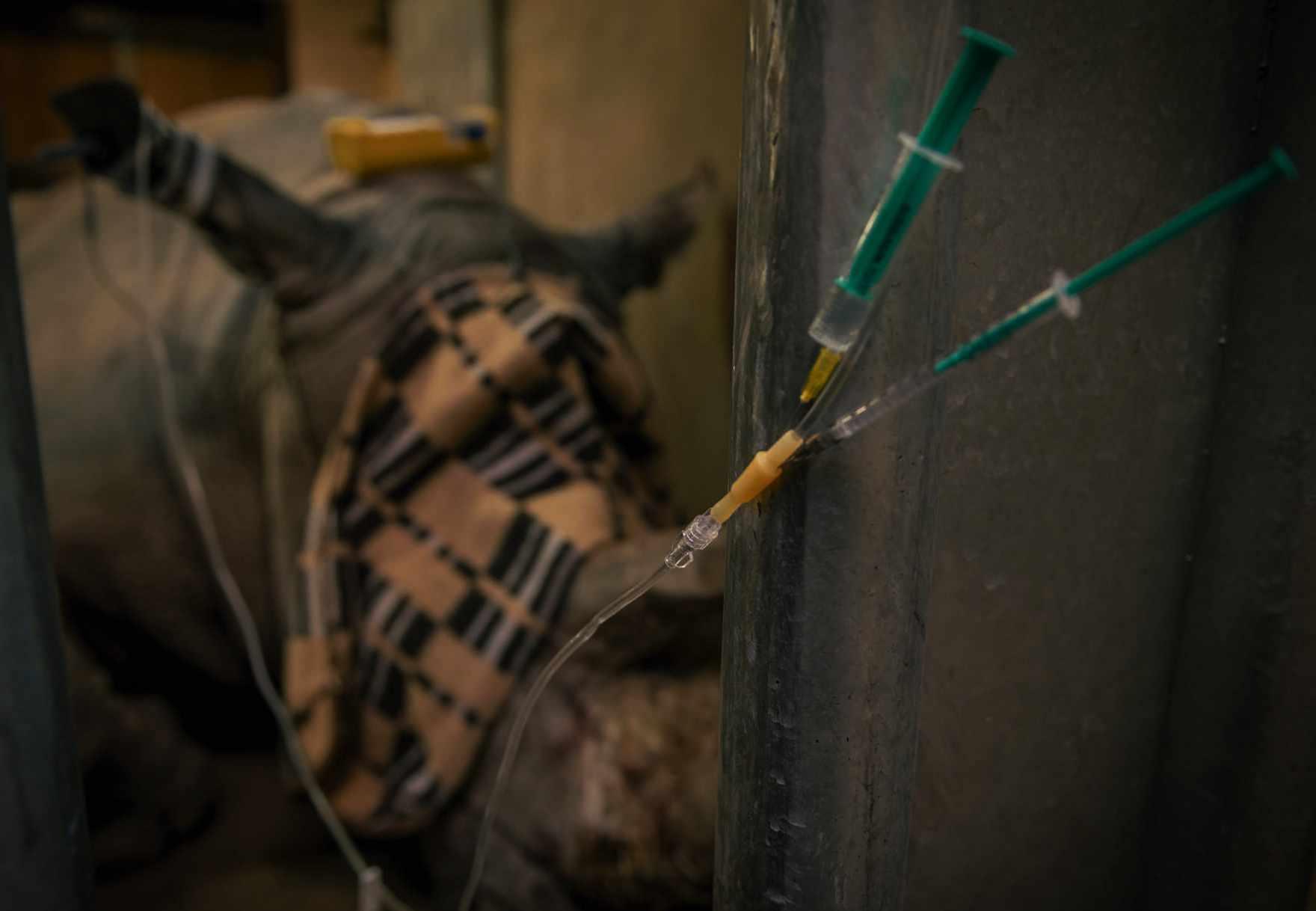
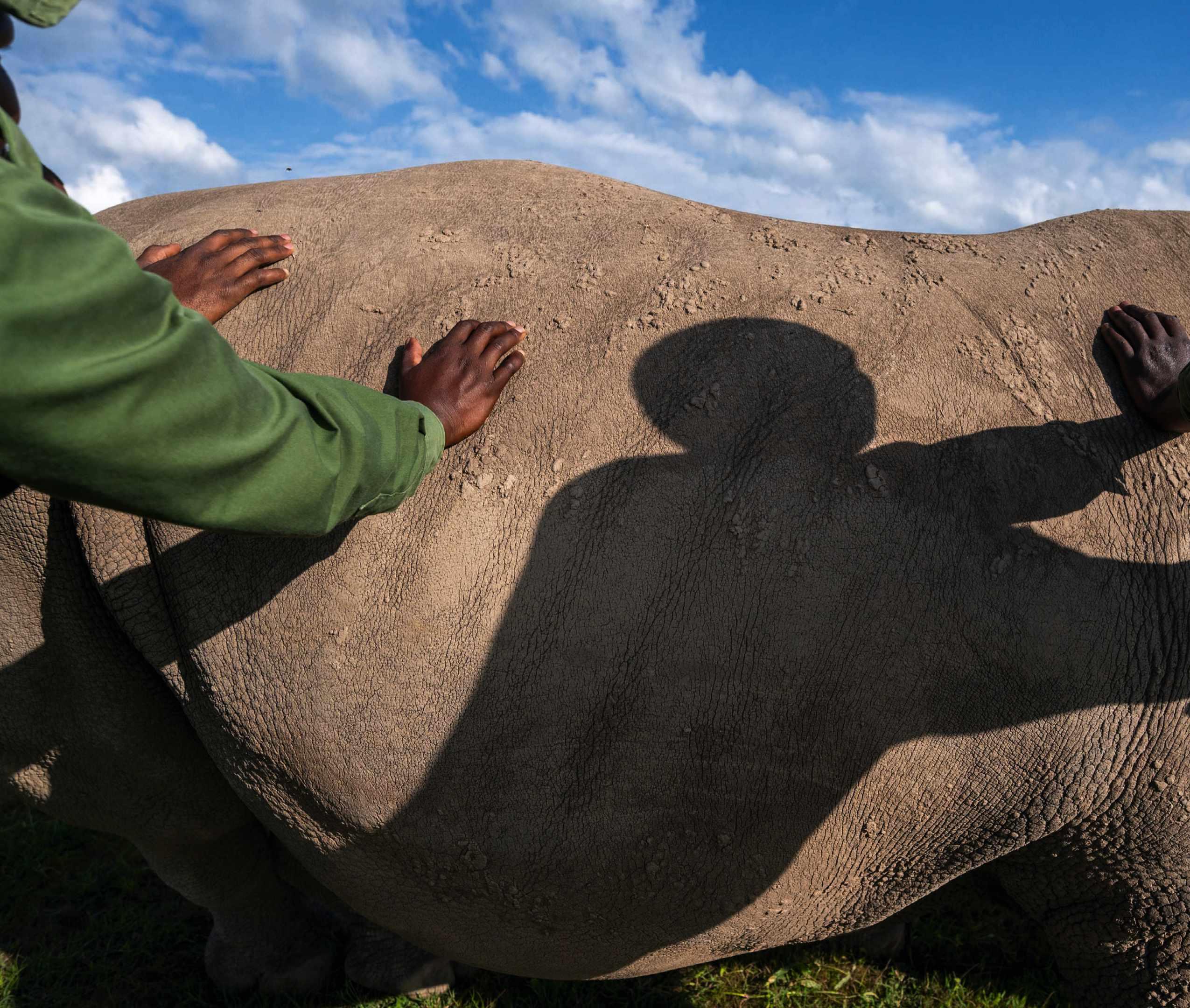
Fatu undergoes a health check. She must be kept in good condition while the BioRescue team prepares for the first attempt at IVF in a northern white rhino. Next steps are to identify a suitable surrogate mother and a teaser male, a process that could well take several months.
There are currently 30 northern white rhino embryos in storage (alongside cells from 12 other individuals) preserved in liquid nitrogen at -196˚C. These were created using Fatu's eggs and sperm from Suni and another male called Angalifu, who lived in San Diego Zoo and died in 2014. Lack of genetic variety is a limitation, and scientists are trying to counter this using stem-cell technology. Museum samples could also assist in genetic enrichment.
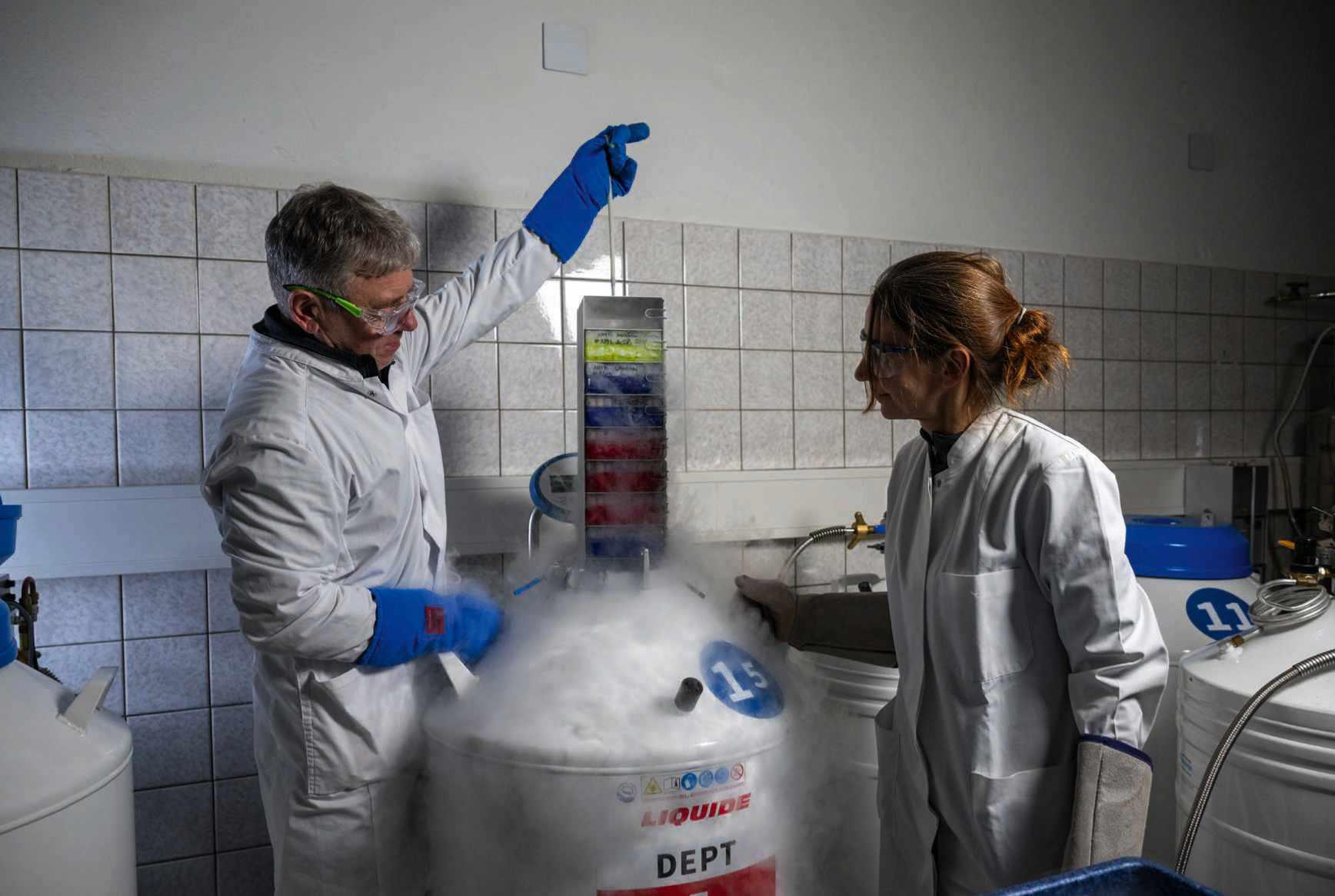
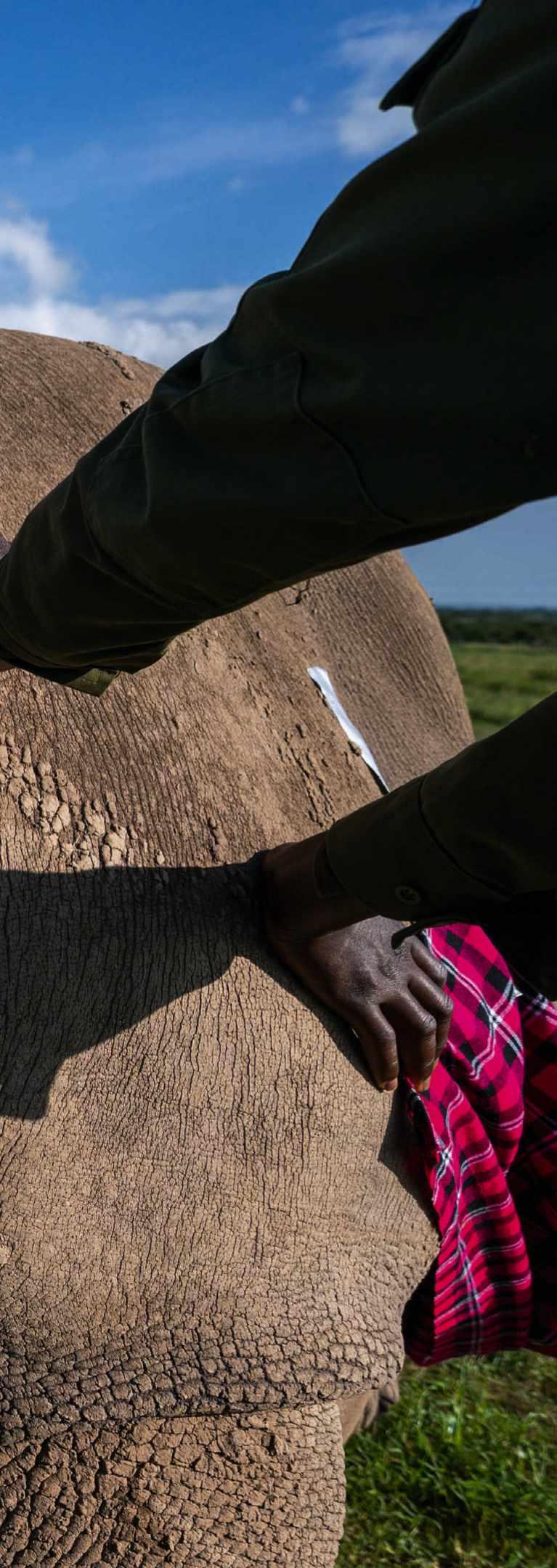
Ouwan receiving a sedation dart before a routine examination. Teaser bulls are vital to the IVF process, as they can detect female reproductive pheromones naturally and quickly – scientists cannot do this without performing intrusive procedures. As a teaser bull actually mates with the surrogate female, he must be sterilised to ensure he doesn't impregnate her himself.


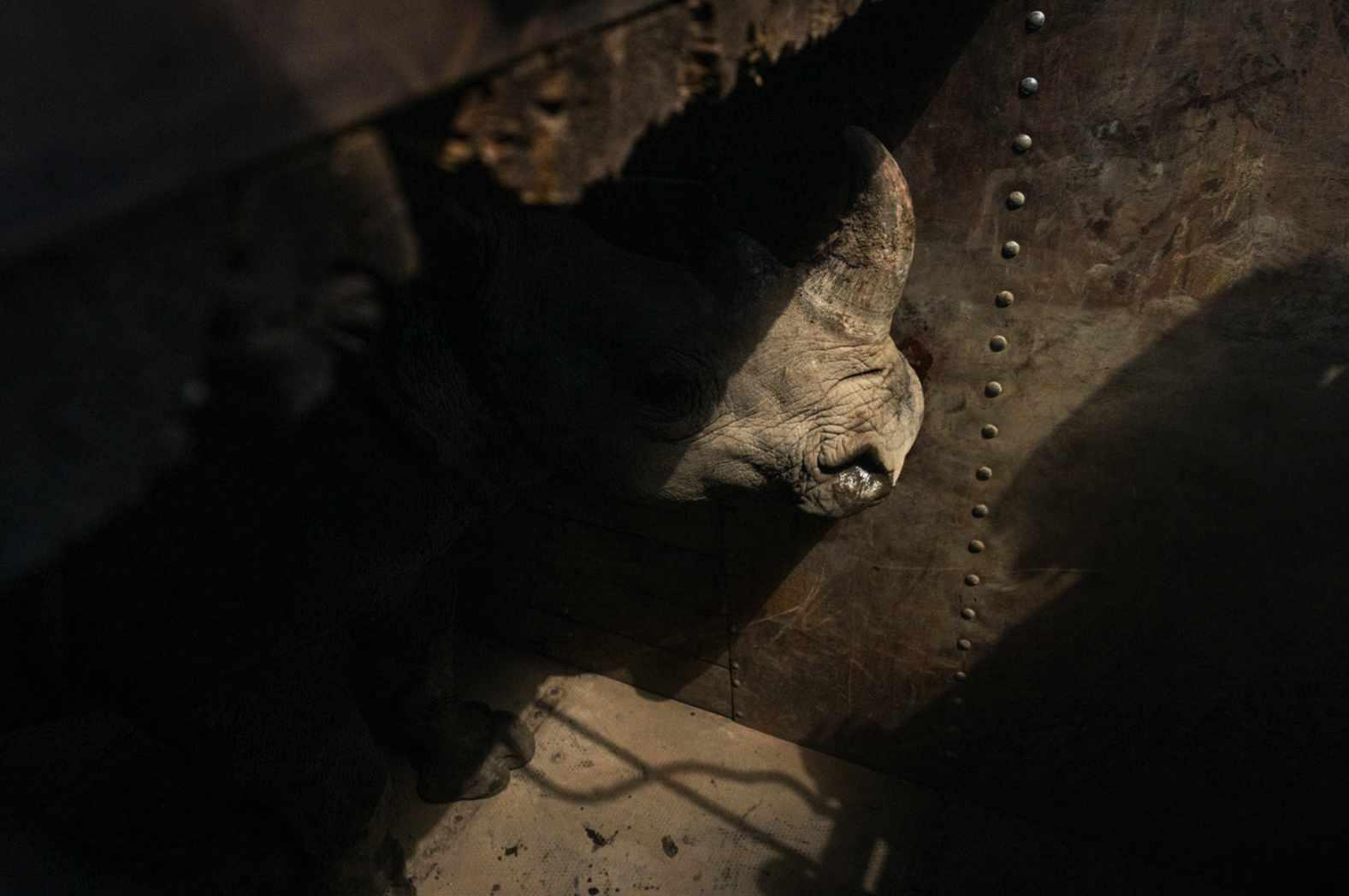
(Above and left) Darling, a young southern white female who will one day be a surrogate, is translocated to a spacious compound at Ol Pejeta. Darling was sharing an enclosure with Ouwan and Curra, but her lesser dominance kept her away from them – and from the bacteria that caused their untimely deaths.
Zacharia Mutai is head caretaker at Ol Pejeta. He knows Najin and Fatu extremely well, having looked after them since they arrived at the conservancy in 2009. With hope, in the not too distant future, his two charges will become three.

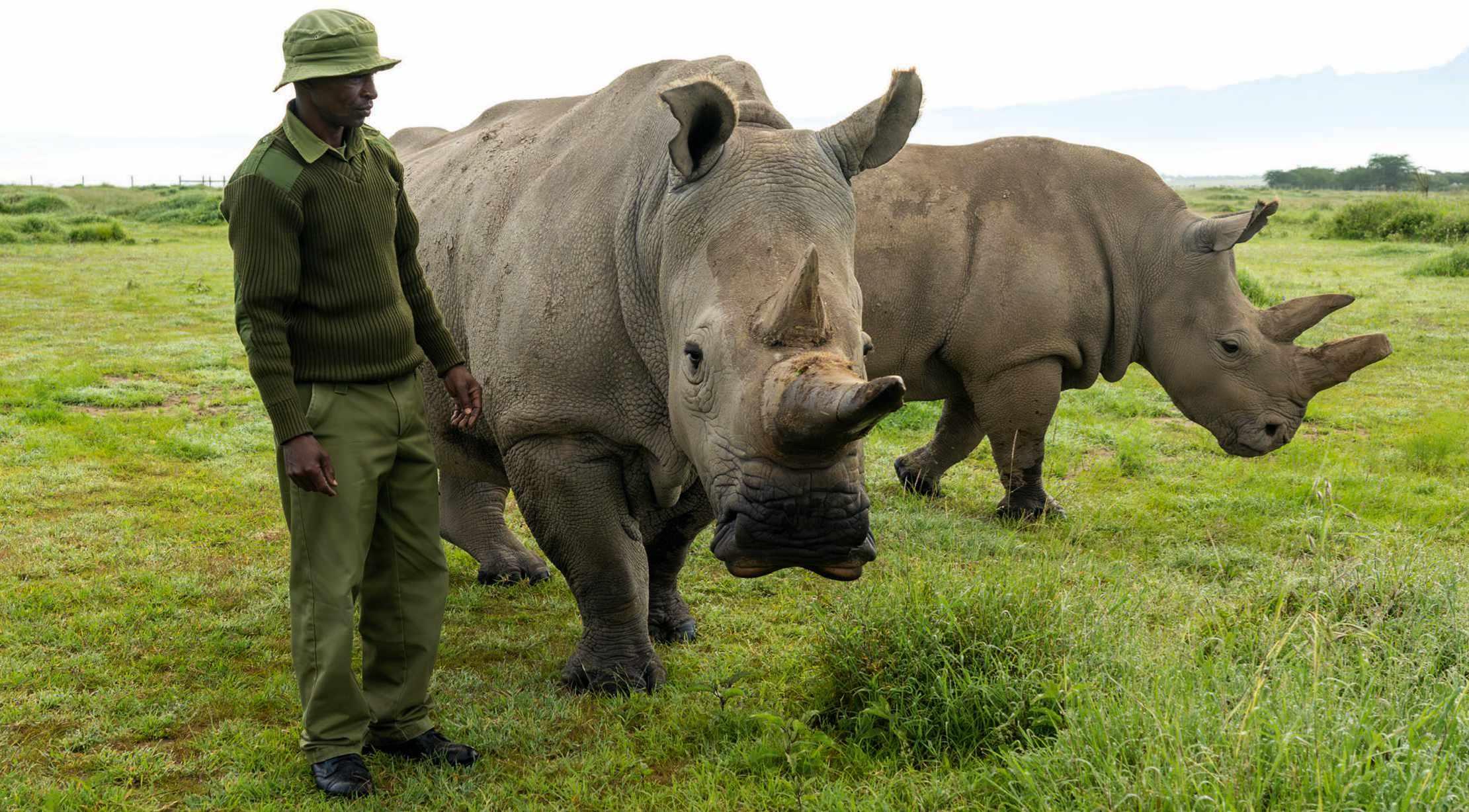
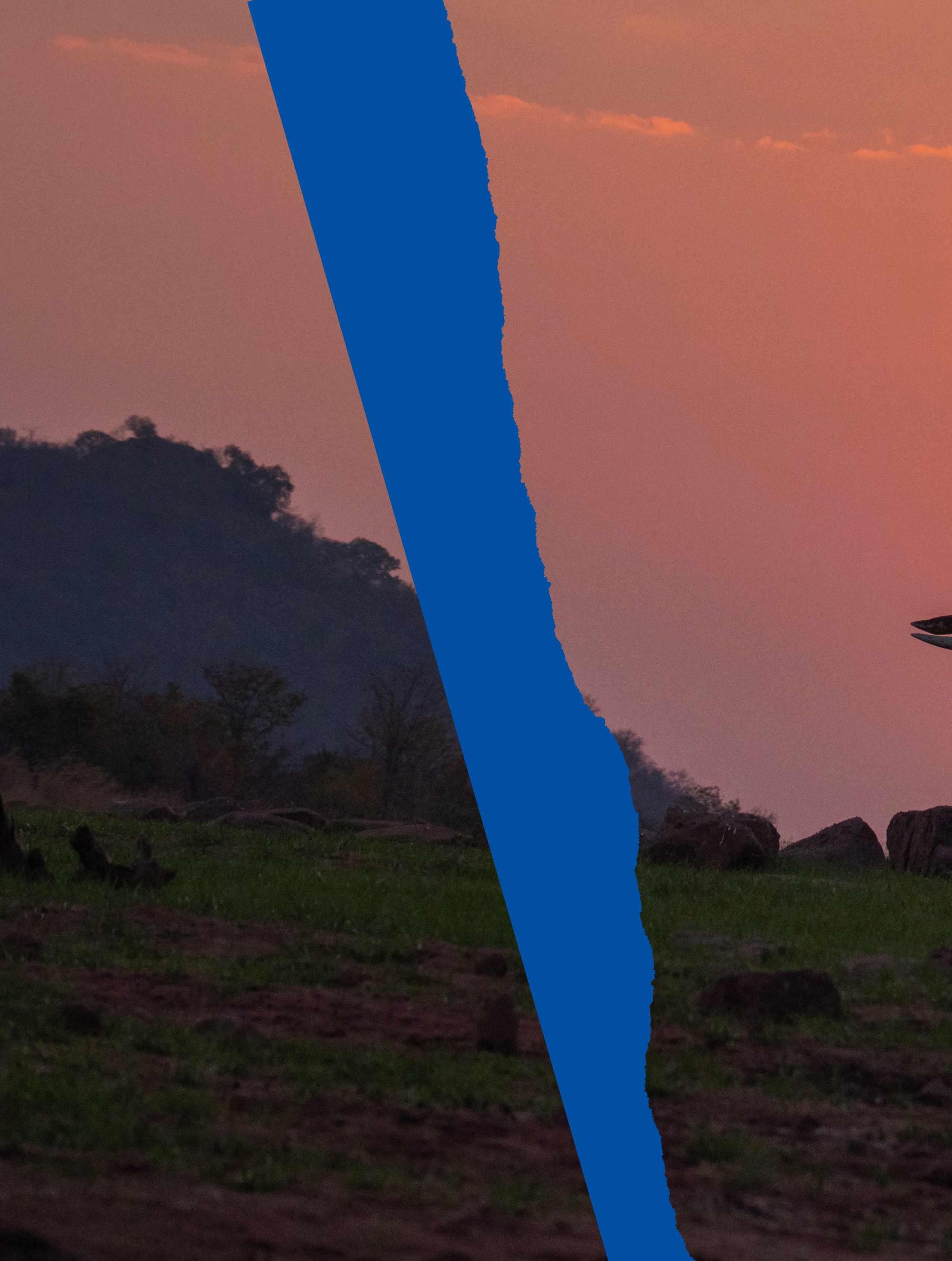
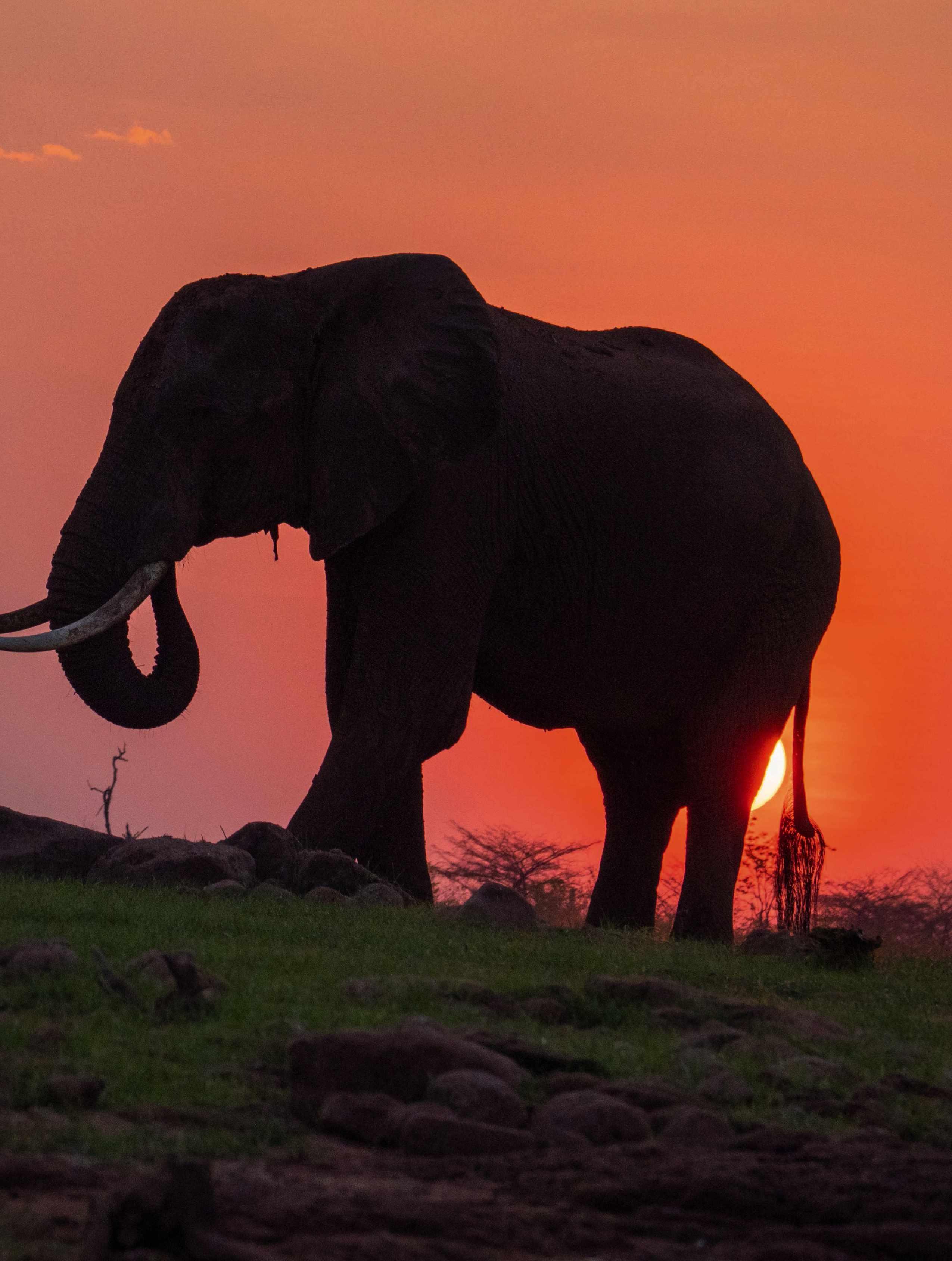
Elephants are one of the ‘Big Five’ animals that can be trophy-hunted in Africa for eye-watering sums
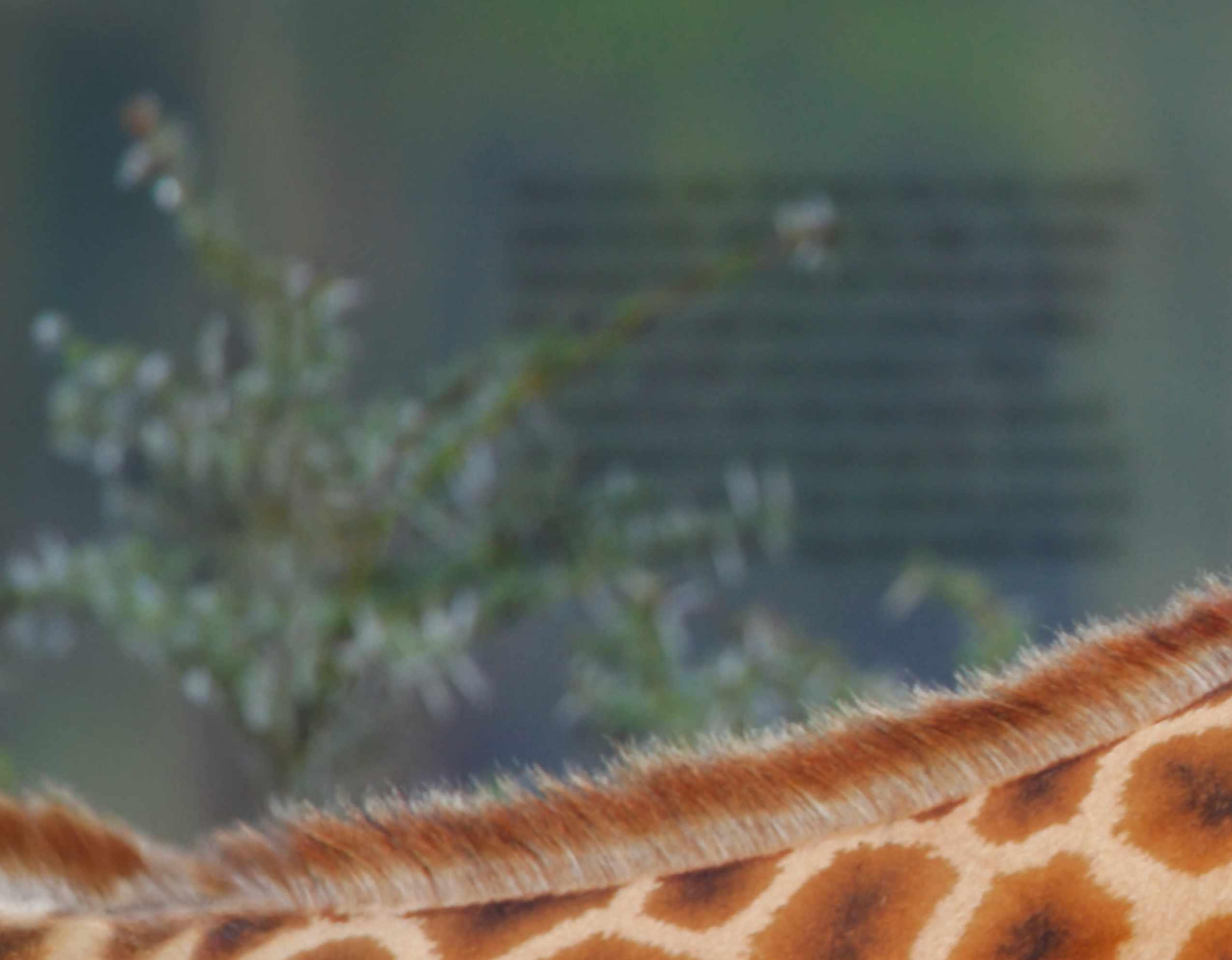
She’s wept in her tent over countless nights. She’s posted photos of her grisly discoveries online, if you have the stomach for them.
Dickman, director of WildCRU, a top conservation research unit based at the University of Oxford, says these killings were mainly carried out by local people trying to protect their cattle and goats. Lions threaten both their livelihoods – and their lives.
As a scientist who’s had a lifelong passion for wildlife, you might assume that Dickman would also oppose trophy hunting, where large charismatic mammals are shot by wealthy tourists at vast expense – killed so that the hunter can return home with

James Fair is a wildlife journalist with a specialism in controversial issues. He spent 18 years as a writer and commissioning editor at BBC Wildlife. Read more at jamesfairwildlife.co.uk.
ince 2009, Amy Dickman has come across some horrific sights on the edge of Ruaha National Park in Central Tanzania where she studies, and tries to resolve, conflict between people and predators. They included lion cubs that had been speared and dumped in the bush and the carcasses of six lions, and 70 rare vultures, poisoned and left to endure long and painful deaths.
Praveen Moman, Volcanoes Safaris
“Unlike some forms of activity that use an animal once, the beauty of the mountain gorilla is that it has been producing tourism resources since the early 1980s. We are onto the third or fourth generation of gorillas, and they are still there and producing wealth for the future.”
a tale of derring-do and a head or set of horns to adorn a living-room wall with a malingering, eerie presence.
But she doesn’t. Instead, Dickman has become increasingly vocal about the probable impacts of blanket bans on trophy hunting that could lead to more animals being killed. If lions and other species generate revenue through trophy hunting, she argues, they and their habitat are more likely to be conserved.
The maths is hard to ignore. Around three villages outside of Ruaha, Dickman and her colleagues documented the killing of
35 large carnivores in one 18-month period. “This included 25 lions killed in one year in an area of much less than 500km²,” she says. In contrast, in areas managed for trophy hunting, the recommended quota is 0.5 lions per 1,000km².
In short, the level of killing where lions have no economic value was at least 100 times higher than is – or should be –permitted under trophy hunting.
On a broader scale, the area of land managed for trophy hunting in Africa is greater than all of its national parks combined – 1.4 million km², roughly equivalent to France, Germany and the UK combined. “On a personal level, I can’t
It is legal to hunt giraffes in some African countries

imagine trophy hunting,” says Dickman. “I’m an animal lover, I’m a vegetarian, I don’t understand it. But understanding it personally is very different from understanding the evidence around it.”
According to Tim Davenport, Africa director for the conservation group Re:wild, in Tanzania alone between 1,000 and 2,000 lions – or 4-8 per cent of the entire global population – are dependent on land managed for trophy hunting. “By stopping trophy hunting [in Tanzania] without alternative financing in place, game reserves will be turned into maize fields and cattle ranches within a few months or years,” he says. “I’ve seen it happen dozens of times.”
Not all scientists agree with Dickman and Davenport, though. Hans Bauer, who also works at WildCRU, says that trophy hunting doesn’t deliver for
“If we stopped trophy hunting here, local people would cut down the trees and make charcoal out of them. They would kill the wildlife to feed their family or for the bushmeat trade. In a matter of two or three years, you will have no trees, no bushes and no animals”
either people or wildlife in the way that it’s claimed. Hunting ‘blocks’ in many African countries are being abandoned because they don’t make money. “Across Africa, in the vast majority of cases, trophy hunting
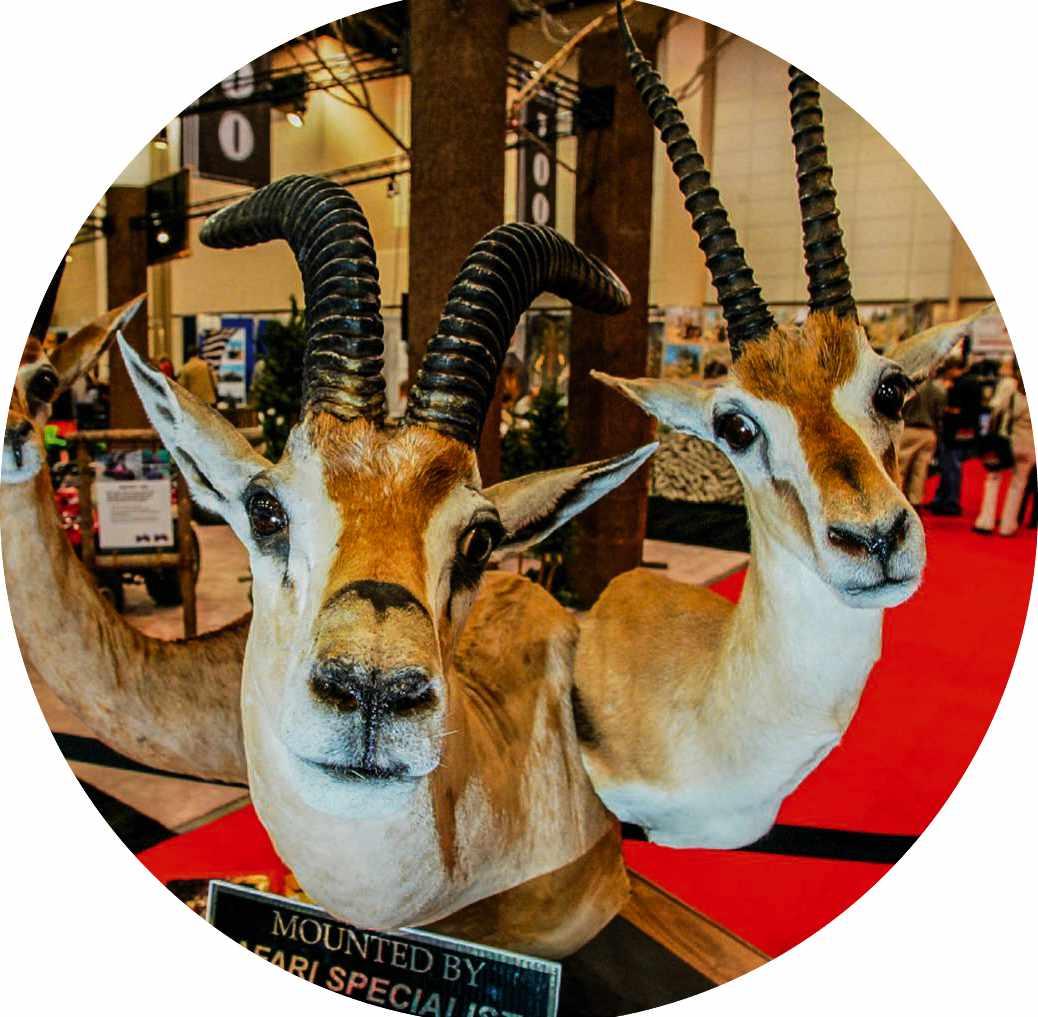
has not delivered more lions – whether because of financial imbalances, increased terrorism, land mismanagement or increased livestock mobility (or a combination of these factors),” he wrote in an article for The Conservation. But let’s step back for a moment. What is trophy hunting, where does it happen, and why are we talking about it? First of all, it’s legal and involves the killing of charismatic wildlife according to quotas set as part of a broader management programme. It is not canned hunting, which is the practice of killing animals in small, fenced enclosures.
Many countries around the world permit trophy hunting. Visit the website Book Your Hunt, and you’ll see there are numerous hunting opportunities in North America, Eastern Europe, Southern Africa and Central Asia, far fewer in South
Taxidermied ‘trophies’ at a hunting convention in Nevada – heads are one of many sought-after bodyparts

America and South-East Asia. Neither India nor Kenya permit it.
Prices vary wildly. On Exmoor, you can shoot red or roe deer for as little as £150. You can hunt goats on Mallorca for £4,000 or non-native camels and wild boar in Australia for £10,000. In Zimbabwe, you won’t see any change out of £30,000 for the right to stalk and kill a leopard.
According to Adam Hart, professor of science communication at the University of Gloucester, who has co-written a comprehensive book about trophy hunting (simply called Trophy Hunting), eight out of the top ten countries ranked for their record in conserving large mammals permit trophy hunting. They include Botswana (1st), Tanzania (3rd) and Canada (8th).
Few people paid trophy hunting much attention until a lion nicknamed Cecil was killed by US dentist Walter Palmer just outside Hwange National Park in Zimbabwe in July 2015, but supporters and opponents have been debating its rights and wrongs, with increasing vehemency, ever since. Some people have mocked up images of Amy Dickman killing animals and posted them online, and she has received threatening letters. Celebrities such as Ricky Gervais
and Joanna Lumley have also joined in the conversation, voicing their objections to trophy hunting via social media.
This year, MPs tried to pass a law that would have banned British hunters from bringing back trophies from species protected under CITES. The bill passed easily through the House of Commons, but – controversially – fell foul of filibustering by peers in the Lords.
This wasn’t the only controversy stirred up by the bill. According to analysis by
“Everybody thinks that a lion is worth far more alive than dead, and yes that’s true in the more popular places, but not in remoter areas where tourism isn’t viable. And even if it is viable, you need 50 tourists for every hunter, so think of all those long flights and extra carbon emissions, think of the water demands.”
Hart, 75 per cent of statements made in support of the bill in the Commons were misleading or incorrect. They included the claim that lions could go extinct by 2050, something for which there is no evidence. Tim Davenport says that many people who object to trophy hunting don’t understand the realities of conservation in Africa. “What you’ve got is people discussing what they think is conservation, but it isn’t – it’s animal welfare,” he says.

But opposition to trophy hunting encompasses multiple strands. One complaint is that it perpetuates a colonial trope of rich white westerners exploiting the continent’s resources, which also keeps local people in poverty and prevents other ways of funding conservation taking root. Another is that permitted quotas can be too high, resulting in declining populations. And it’s cruel – tourist hunters are unlikely to be as skilled as their professional guides and can choose to use bows and arrows instead of guns to kill their quarry. Cecil, it’s claimed, took 40 hours to die.
Mucha Mkono, a lecturer in sustainable tourism at the University of Queensland, has looked at attitudes among African social media users to trophy hunting. She examined responses to news stories about the Cecil killing and found frequent references to the neo-colonial nature of the activity.
Shooting lions at a concession in Namibia, Africa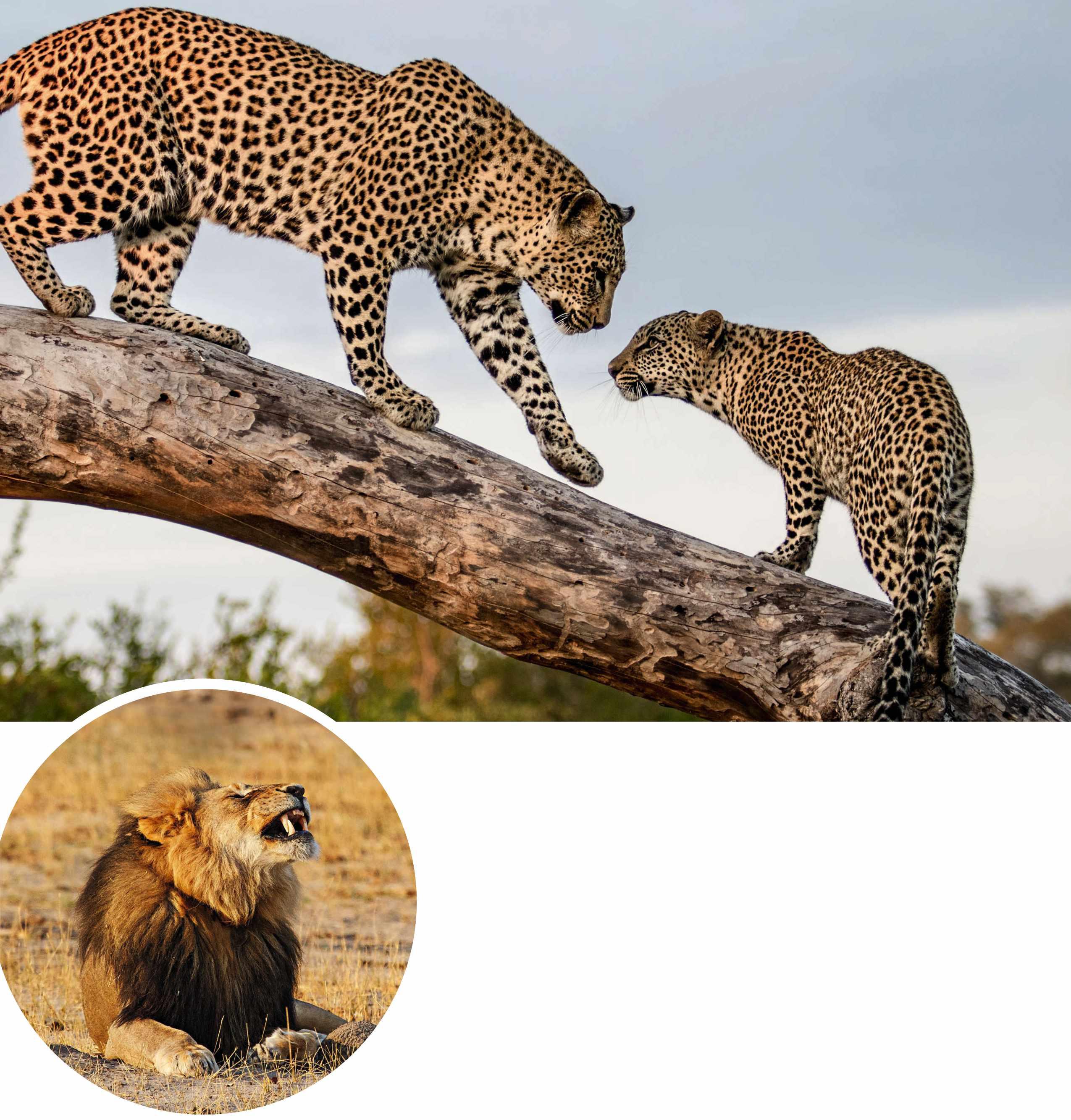
Mkono – who is Zimbabwean – says many people in Africa are uneasy with the idea of rich, white people flying in to shoot their wildlife. “Black people are economically precluded from participation in trophy hunting,” she points out, “and if they try to hunt wildlife for themselves, they can be penalised for poaching.”
Many African leaders accuse those trying to bring an end to trophy hunting of being
equally neo-colonial. It is not up to the UK or USA to tell Africans how to manage their environment, they argue – if they want to make money out of rich westerners hunting their wildlife, that’s up to them.
An equally contentious issue is what replaces trophy hunting were it to disappear. Even opponents concede that something has to. A lobbying document supported by groups that included the Born Free Foundation argues that the benefits to local communities are “often greatly exaggerated” and that – as a funding model – it’s on the decline. But it adds that the UK government should “provide additional resources for those countries” whose wildlife management model relies on revenue from trophy hunting should a ban be implemented. No funding pledge was given.
More tourism is not the answer. A lot of trophy hunting takes place in areas that are either too remote, not sufficiently scenic, or plagued by tsetse flies, making them unviable for westerners who like their home comforts.
But there are other alternatives, if only we were able to implement them. Ecologist
Leopards are hunted, despite being listed as Vulnerable
Mark Jones, Born Free
“Cecil the lion was shot with a bow and arrow, which is not designed to minimise suffering. In addition, trophy hunters will try to avoid damaging the parts of the animal that will become the trophy – typically the head – and consequently, there’s a high chance of a prolonged and painful death for the animal.”
and conservationist Ian Redmond, who has worked in Africa throughout his career, is a co-founder of Rebalance Earth, a new initiative that aims to help developing nations monetise their biodiversity.
Animals such as elephants, Redmond says, have enormous value while alive in terms of the ecosystem services they provide. It’s calculated that a single forest elephant helps trees store an estimated 9,500 tonnes of CO2 per km² by weeding out smaller trees, allowing those that survive to grow larger.
“The carbon value of a single forest elephant is $1.75 million,” Ralph Chami, another co-founder of Rebalance Earth, told a conference organised by Born Free in
The increase in white rhino numbers since trophy hunting was introduced in 1968 500
The number of lions found in Bubye Valley Conservancy in Zimbabwe today, a 40-fold increase since 1999 when it was first managed for trophy hunting
700,000
The number of trophies imported into the USA from 2016 to 2020. It is illegal to do so in France, the Netherlands and Australia.
The year Kenya banned all trophy hunting. Costa Rica and India are two other high profile examples.
$56M
The income generated by trophy hunting in Tanzania in 2008 – of this, $1.6m was spent on community development and just over $6m on wages (excluding professional hunters and managers).
“Sport hunting is in desperate need of reform. It has been demonstrably successful in protecting wildlife in the community conservancies of Namibia and wildlife reserves in South Africa and Zimbabwe, but in Mozambique, Tanzania and Zambia, the governmentrun hunting blocks have been poorly managed, and between one sixth and one half remain unclaimed.” 10X
December 2022. The forests of Gabon alone could be worth £950 million a year, he said.
But these are only notional figures. Who’s actually going to pay for these services? Chami suggested that global corporations such as Microsoft will want to showcase their eco-credentials to both their consumers and investors by buying into such a market.

But not everyone is convinced. Adam Hart says the problem is that this model is effectively wealthy countries giving money to poorer ones. “That means they can stop at any point,” he points out. “If they don’t like the government of Zambia or there’s a coup somewhere, suddenly it’s ‘What, we’re paying these people?’”
What about the argument that trophy hunting doesn’t really benefit local

communities? This is perhaps the most disputed of all the claims and counter-claims. Namibia is often cited as the best example of community-run conservancies in which most of the income from the fees ends up in the hands of local people.
In fact, there is a better example – Pakistan. WildCRU researcher Bilal Mustafa has in-depth knowledge of trophy hunting in his home country – mainly species such as mountain goats called markhor (renowned for their huge, corkscrew horns), ibex and blue sheep. Hunters are willing to pay $100,000 and more for the right to shoot one of these animals, and annual incomes for a single province can be in the millions of dollars –and, crucially, 80 per cent of all income is returned to the local community.
This money is spent on schools, community centres and roads. Literacy rates
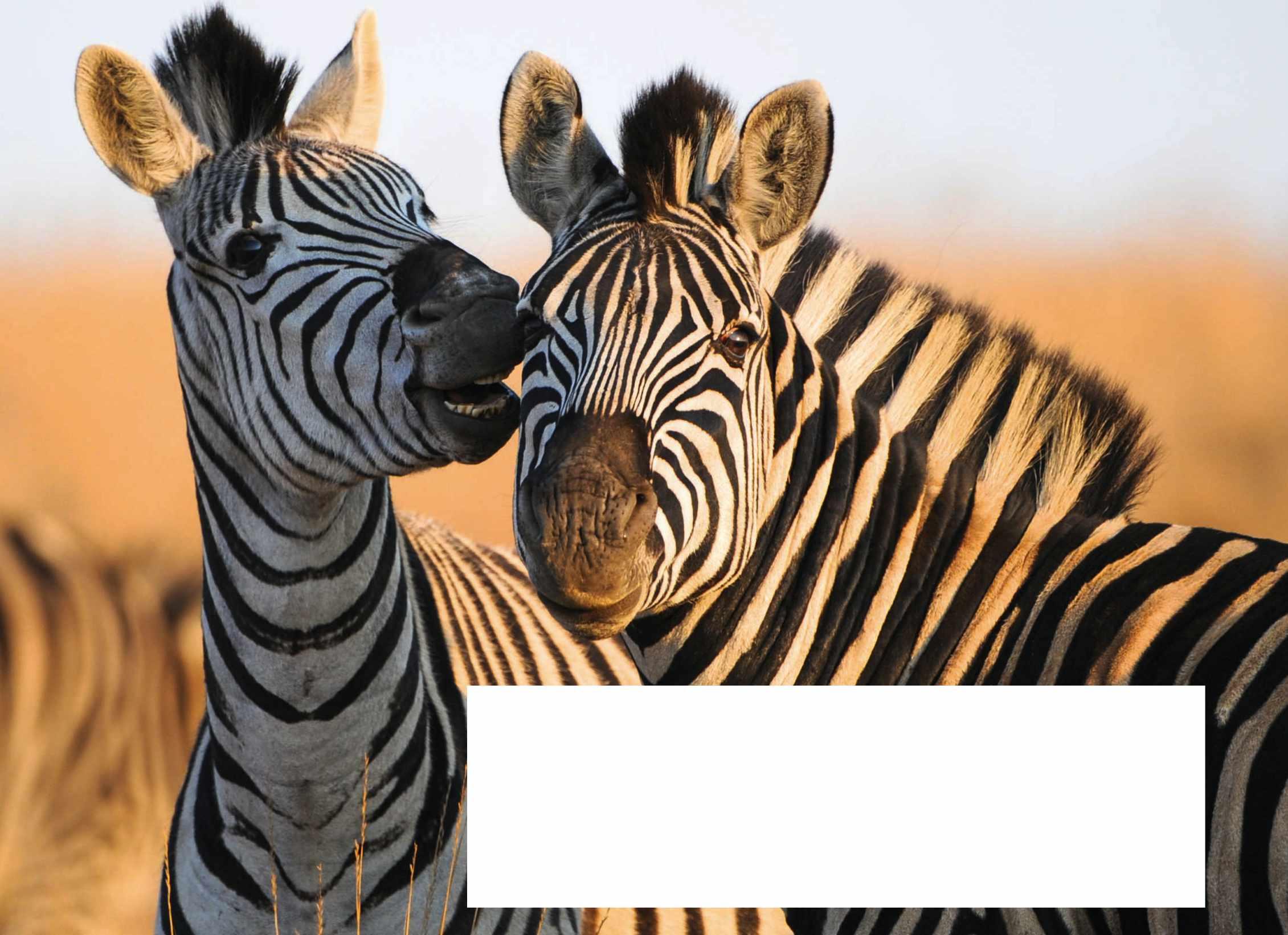
in trophy hunting regions have increased from 10 to 70 per cent of the population, with girls especially benefitting. “The early marriage of girls has been reduced because of an increase in the literacy rate of girls up to 90 per cent, and most of them are also now going to university,” Mustafa says.
Wildlife populations have increased. Markhor numbers in the province Gilgit Baltistan rose more than five-fold to nearly 3,000 between 2000 and 2016, and money from trophy hunting is also used to compensate those farmers who lose livestock to predators such as snow leopards.
You might argue, as Adam Cruise –interim chief executive of the Campaign to Ban Trophy Hunting (CBTH) – does that one of the problems in Africa is the economic model in which often foreign- (and white-) owned businesses get the lion’s share of the profits. “Conservation and community uplift benefits are the two pillars to justify trophy hunting as a necessary evil,” he says. “It sounds really good, and if it were true, I’d back it.”
But by the time the hunting operators and governments have taken their share of the money, there’s only a few scraps left to divide up among local communities. In
Killing a zebra could cost you $1,200 or more
Patience Gandiwa, Zimbabwe Parks & Wildlife
“Zimbabwe incurred significant costs after 2014 when the US government enforced stricter measures on the importation of sport-hunted trophies of lions and elephants – revenue decreased from $5 million to $2 million, and yet the cost of conservation is actually increasing as a result of human-wildlife conflict and trans-national organised crime.”
fact, it’s worse than that, Cruise argues –land in countries such as South Africa and Zimbabwe is set aside for wildlife at the expense of local people.
What the future holds is unclear. Labour has committed to bringing back the trophy hunting bill should it form the next government, though it’s hard to imagine it will be a priority. The USA – which accounts for 70 per cent of the global trophy hunting market – requires hunters to demonstrate that the money they paid for their kill contributes towards species conservation if they want to come back with a trophy, something which many conservation scientists say we could do here in the UK.
It’s perhaps not surprising so many people find this issue grotesque. Photographs of gun-toting, khaki-clad sport hunters gurning at the camera beside the body of a lion or giraffe is far from a universally popular look. But whatever you think about it – and whether anything you have read here has changed your mind or not – here are two thoughts to take away.
First, there is no species that is at risk from going extinct because of trophy hunting. That’s just a fact.
And second, the amount of money raised by trophy hunting – whether it goes to local communities or not – is relatively small beer. For southern Africa, you see figures of anywhere between $200 to just over $400 million a year. In contrast, the USA alone provides around $6 billion – 15 times that figure – in aid to the continent a year. The global conservation group WWF brought in £888 million in 2022 through charitable giving, grants and other fundraising.
But then again, the cost of safeguarding lions in Africa’s protected areas alone is estimated to be between $1.2 to $2.4 billion a year, but they receive less than $400 million. Even with trophy hunting, there is a chasm between what’s needed and what comes in.
If we in the west want to see an end to trophy hunting of lions and leopards by banning imports, then you could argue we need to stump up the lost cash. The question is whether a consensus could be reached on where this money comes from and who it goes to. With trophy hunting, it’s easy to ask difficult questions – but much harder to find the answers.
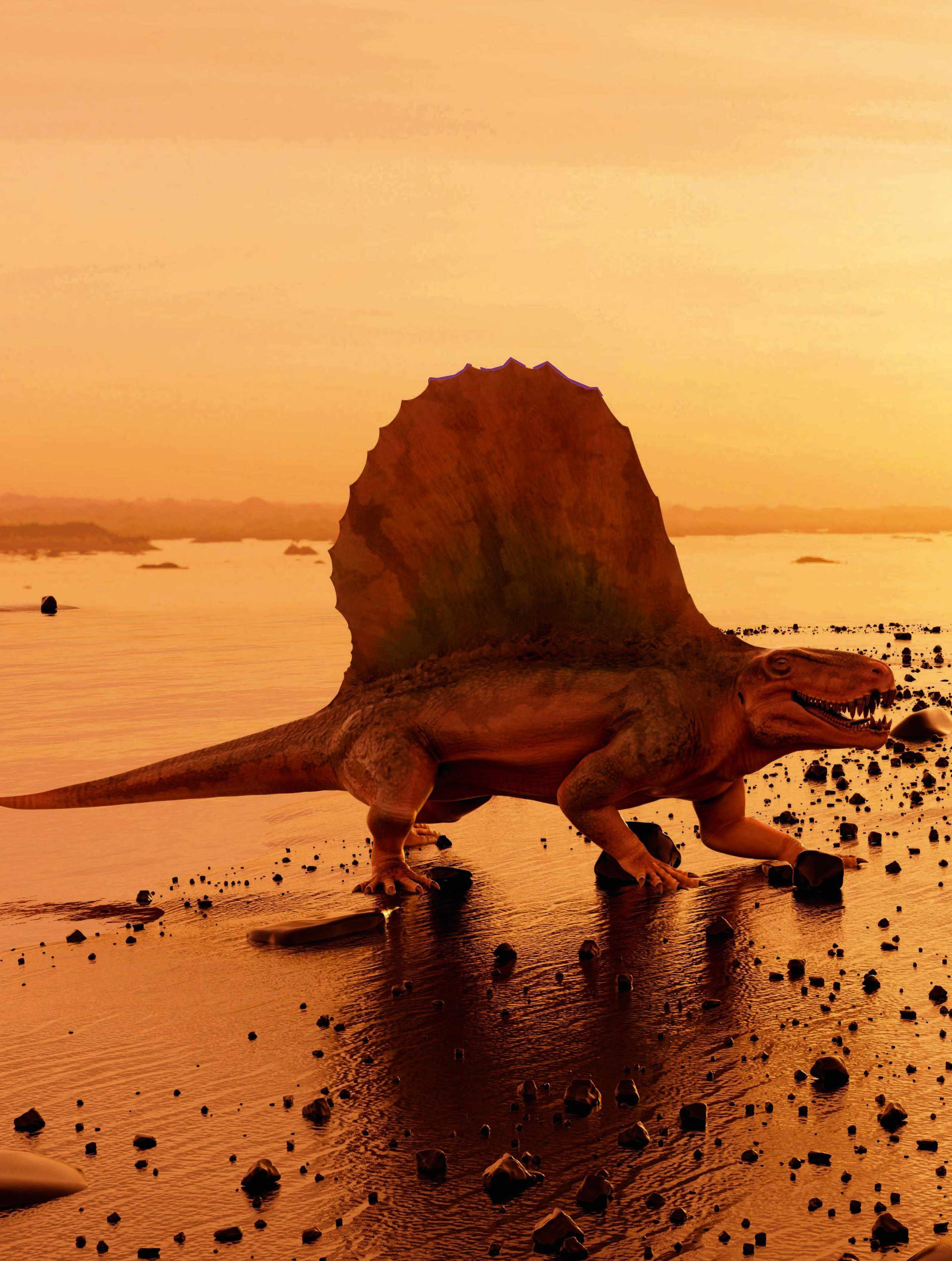




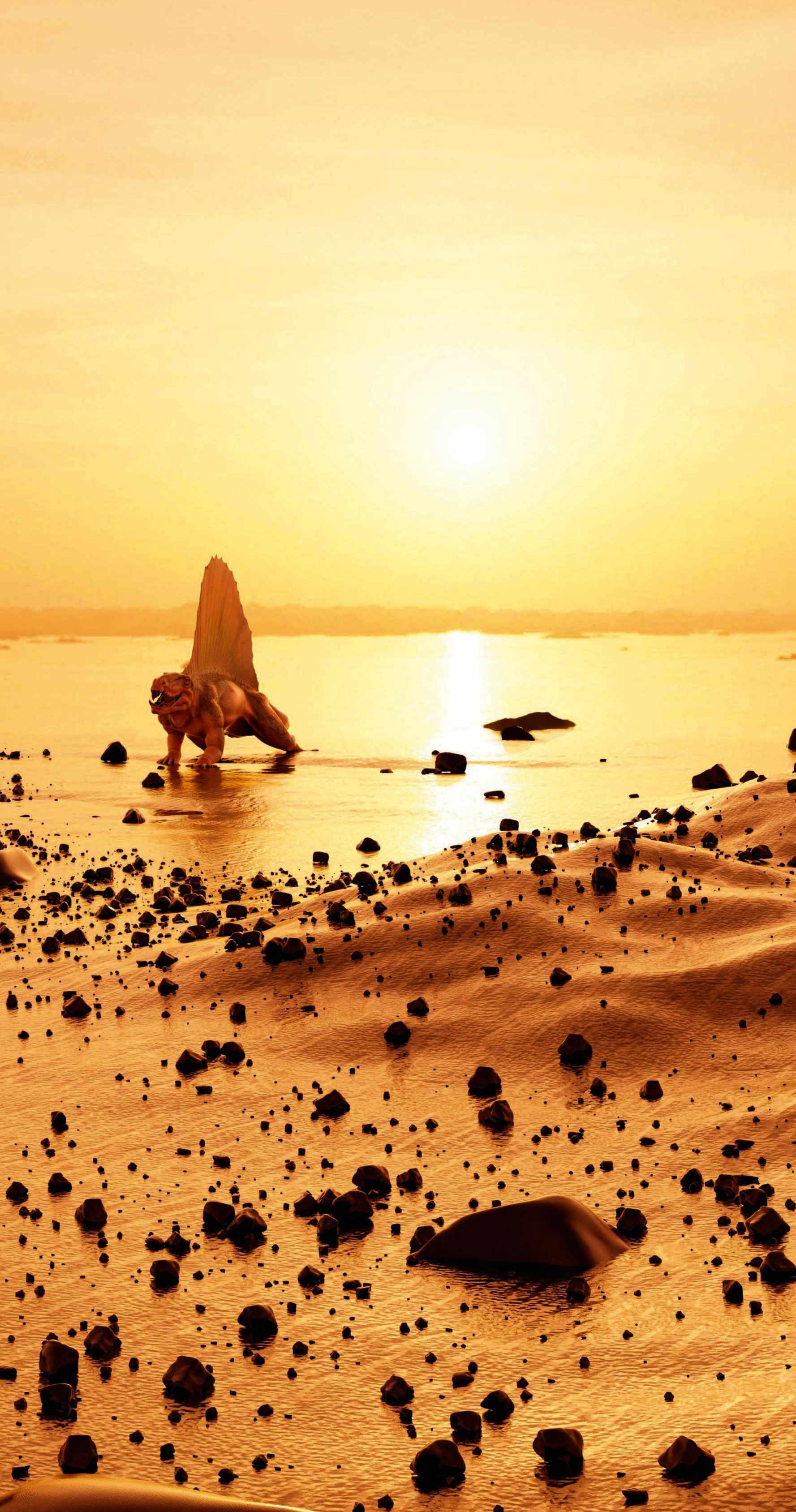
Dinosaurs dominated life on Earth for 180 million years, between the Triassic and the Cretaceous periods. But the animals that came before them paved the way for species that still exist today.
After the emergence of the first true animals around 700 million years ago, evolution ran amok, creating countless bizarre groups before the dinosaurs finally arrived 450 million years later. These pre-dinosaur animals evolved in a very different world to the one we know. This was a world without grass, without flowers; a world that was, for a time, dominated by a single supercontinent surrounded by a vast ocean. From car-sized millipedes to fish that walked on four fleshy fins, here are ten of the wackiest, weirdest and most wonderful animals that lived during this period of Earth’s history.

Will Newton is a palaeontology graduate from the University of Edinburgh and a lover of all things prehistoric.
Each of its eyes comprised more than 16,700 lenses
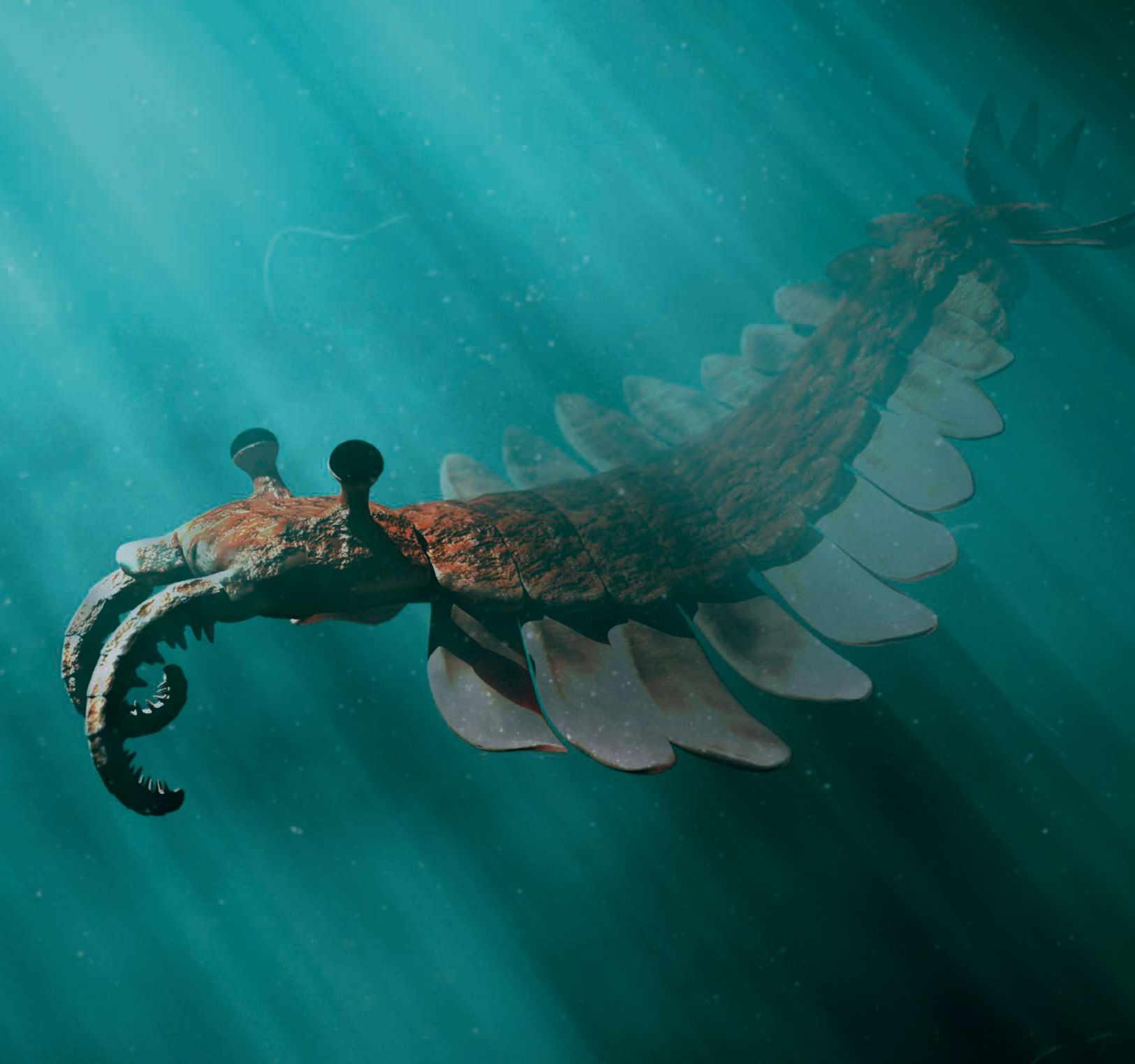
Lived 345-290 m.y.a
Before vertebrates established their dynasty on land, the arthropods – a huge group that includes insects, spiders and crustaceans –ruled unchallenged. Largest among them was Arthropleura, a 2.6m-long, mulch-eating millipede that roamed the beaches and forests of ancient England.
This giant creepy-crawly lived during the Carboniferous period, a time when sprawling rainforests acted as the Earth’s ‘lungs’, drawing in carbon dioxide and breathing out masses of oxygen. It’s thought there was 5-10 per cent more oxygen in the air during this time, which is one reason why Arthropleura grew so large. Another was lack of competition. It took another 40 million years and a worldwide rainforest collapse before distant ancestors of Tiktaalik (see page 68) began to outcompete arthropods.
Lived 520-499 m.y.a
More than half a billion years ago, the world’s oceans were stalked by a soft-bodied predator that looked unlike anything alive today. This bizarre-looking animal was Anomalocaris, or ‘unusual shrimp’, and is widely regarded as the world’s first apex predator – the killer whale of its day.
Anomalocaris was the largest hunter of the Cambrian period, measuring up to a metre in length from its grasping, frontal appendages to the tips of its tail fans. The appendages are thought to have been used to catch and crush prey.
For a long time, hard-shelled marine arthropods known as trilobites were assumed to have been Anomalocaris’s favourite snack, but new research has suggested that this predator was more of a weakling, incapable of cracking tough trilobite armour. It’s now believed Anomalocaris was a hunter that relied on speed, agility and superior sight rather than strength. It probably targeted other fast, soft-bodied animals that lived in open water.

The super-sized millipede relied on rainforests

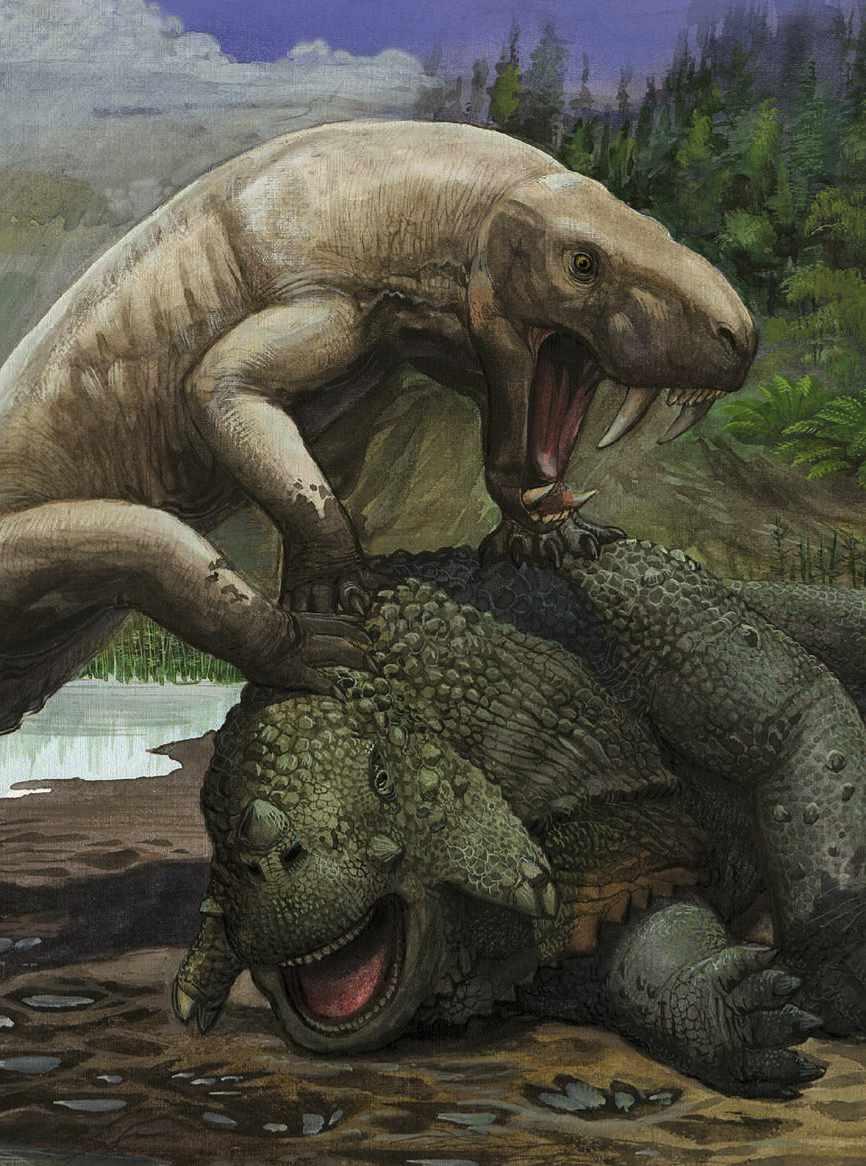
Lived 259-251.9 m.y.a
Cross a polar bear with a sabre-tooth cat, and you’d get something resembling Inostrancevia. It was a protomammal, an ancient ancestor of today’s modern mammals, like Dimetrodon (see page 69), but looked very different – less like a reptile and more like a big cat. It also had longer legs than Dimetrodon, which suggests it was a runner – and a fast one at that.
Inostrancevia had sabre-shaped canines that could land killer blows on the necks of megaherbivores such as Scutosaurus (see right). As a protomammal, its jaws were packed with other kinds of teeth, too, but these weren’t used for chewing. Instead, Inostrancevia used a ‘puncture-pull’ strategy, tearing away huge chunks of meat.
It’s unknown whether Inostrancevia was covered in scale-like skin, like its ancestors, or fur, like its mammalian descendants. That said, researchers have found some clues in coprolites (fossilised faeces) that may have been left by them or some close relatives. It’s thought that hair-like structures contained within the coprolites came from smaller members of the same clade, therapsids, that Inostrancevia likely preyed upon. If smaller therapsids had ‘hair’, then Inostrancevia probably did too.
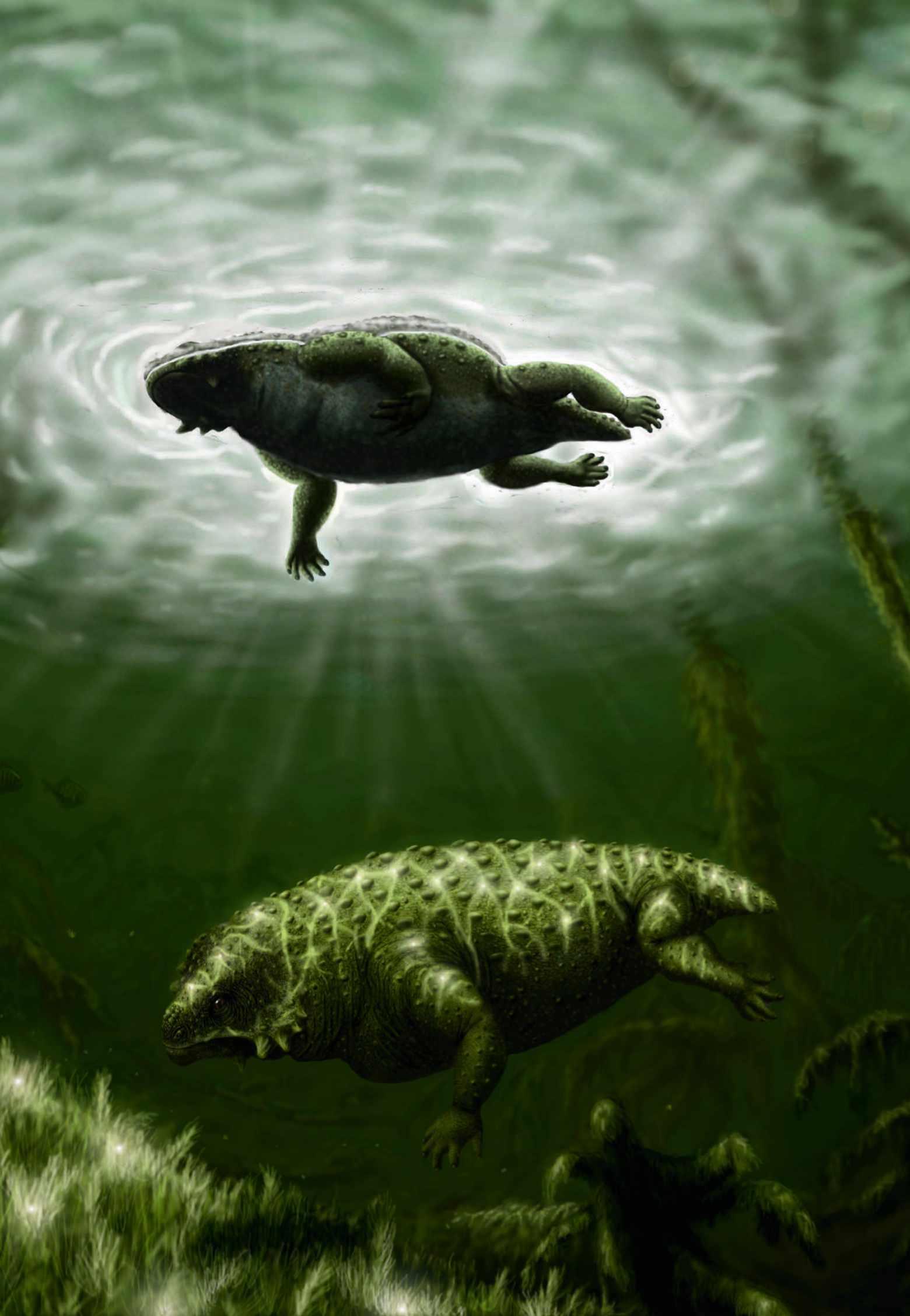
It’s thought that these early reptiles could swim
The
Lived 259-251.9 m.y.a
There weren’t many animals bigger than Scutosaurus during the Late Permian, particularly in the ‘cold deserts’ of ancient Russia. These forklift-sized reptiles weren’t just long, at around 3m from head to tail, but heavy too, breaking the scales at a whopping 1,100kg –equivalent to a black rhino.
A lot of Scutosaurus’s weight was from a thick layer of rough plates, or
osteoderms, that covered almost its entire body. It wasn’t particularly fast or agile, so this bony armour was its main defence against its arch-rival Inostrancevia (see left). To maintain its huge size, Scutosaurus had to eat constantly.
Scutosaurus and other large members of the pareiasaur family were among the first megaherbivores to walk the Earth. They were pioneers in a niche that would later be dominated by dinosaurs such as Stegosaurus, Triceratops and Ankylosaurus.
Scutosaurus looked a lot like these dinosaurs, but was as distantly related from them as we are from whales and dolphins. Interestingly, Scutosaurus’s closest living relative is another armoured reptile with a similar reputation as a slowcoach: the tortoise.
A fast runner with a killer blow ANOMALOCARIS: ALAMY; ARTHROPLEURA: WALTER MYERS/ SCIENCE PHOTO LIBRARY; THIS PAGE: GETTY A sabre-toothed ancestor of modern mammalsTiktaalik was welladapted for life in the shallows
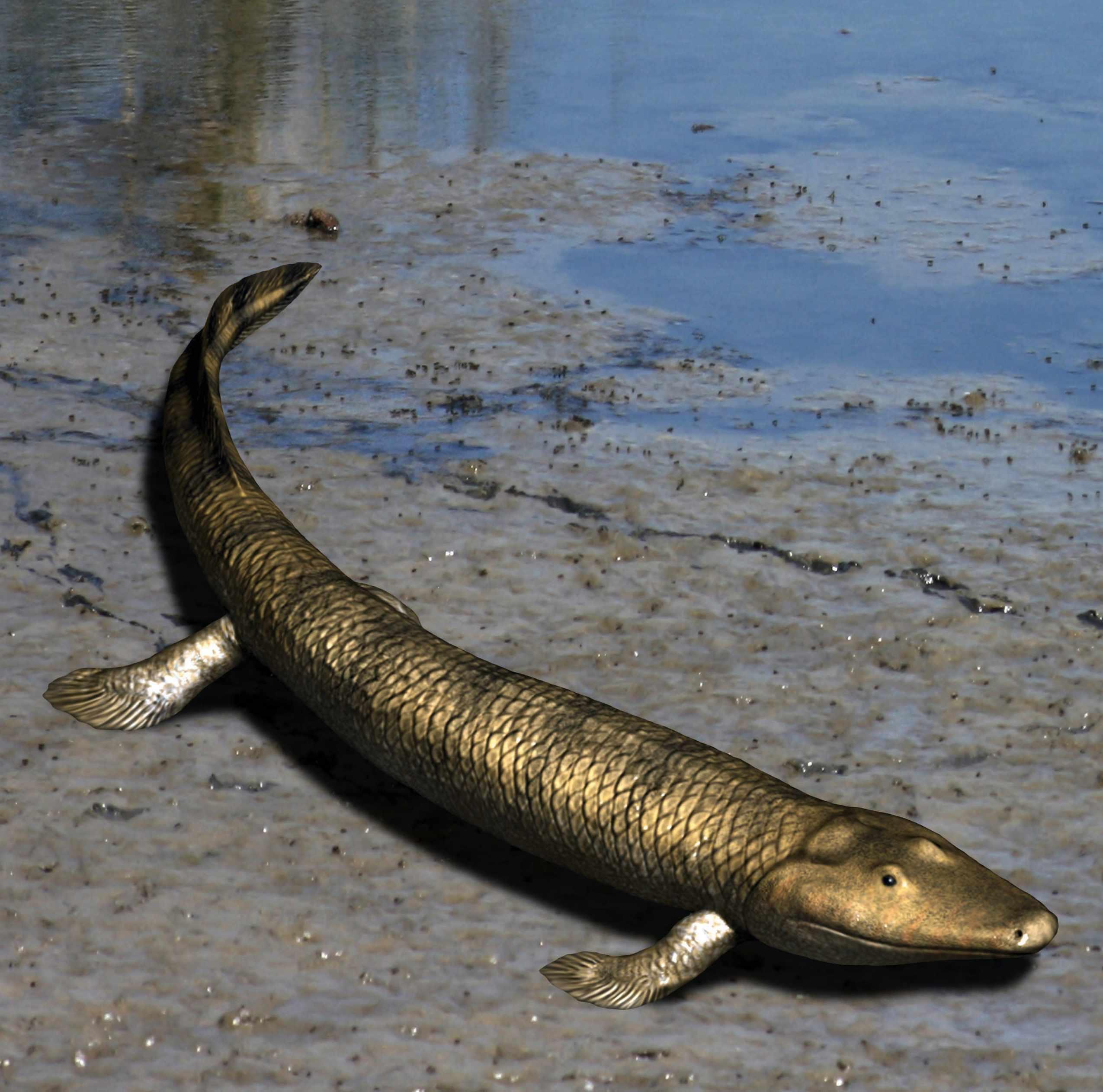
Lived 375 m.y.a
Fish aren’t typically known for their ability to walk on land, but Tiktaalik wasn’t your typical fish. It was, by definition, a fish, but sporting primitive, air-breathing lungs (as well
as gills) and four fleshy appendages that resembled limbs, it was well on its way to becoming a fully fledged, terrestrial tetrapod.
From fossils found in Arctic Canada, it’s estimated that Tiktaalik grew to lengths of 3m. This huge size, combined with large jaws full of needle-like teeth, a mobile neck and eyes on the top of its head, suggests it was a predator specially adapted for hunting fish in the shallows. Some think it may have even preyed on other, smaller ‘fishapods’ that lived on the margins between land and water.
In pursuit of prey, Tiktaalik relied not only on what it had up top, but underneath
too. Unlike most other fish, Tiktaalik had robust fins that could support its weight outside of the water, attached to highly mobile joints. It’s this combination that allowed Tiktaalik and others of its kin to experiment with a life on land.
Where Tiktaalik falls on the vertebrate family tree is debated, but there’s no denying that it lived during an important time in the evolution of four-limbed animals. From Tiktaalik and its close cousins a new dynasty spawned – one that would give rise to reptiles, dinosaurs, birds, mammals and, eventually, humans.
The fish that led a revolution on land
Lived 295-270 m.y.a
Just one look at Dimetrodon and your eyes are immediately drawn to the huge sail on its back – a feature shared by the iconic dinosaur Spinosaurus. This scaly, tiger-sized beast wasn’t a dinosaur though. In fact it’s more closely related to us than Spinosaurus.
Dimetrodon was a protomammal and had a few features that set it apart from dinosaurs, most of which were found in its skull. Behind its eyes it had a a temporal fenestra, a small hole where lower jaw muscles attach to the skull. Dimetrodon and other protomammals had just one of these; dinosaurs and their ancestors had two. It also had different teeth for different functions, which is where its name Dimetrodon, or ‘two-measure tooth’, comes from. In contrast, dinosaurs and their ancestors were equipped with rows of identical teeth.
Its most iconic feature, though, was that sail. For a long time, researchers thought its function was to regulate body temperature across a range of habitats. It’s now thought the sail was used as a giant billboard to display sexual readiness and scare off rivals.
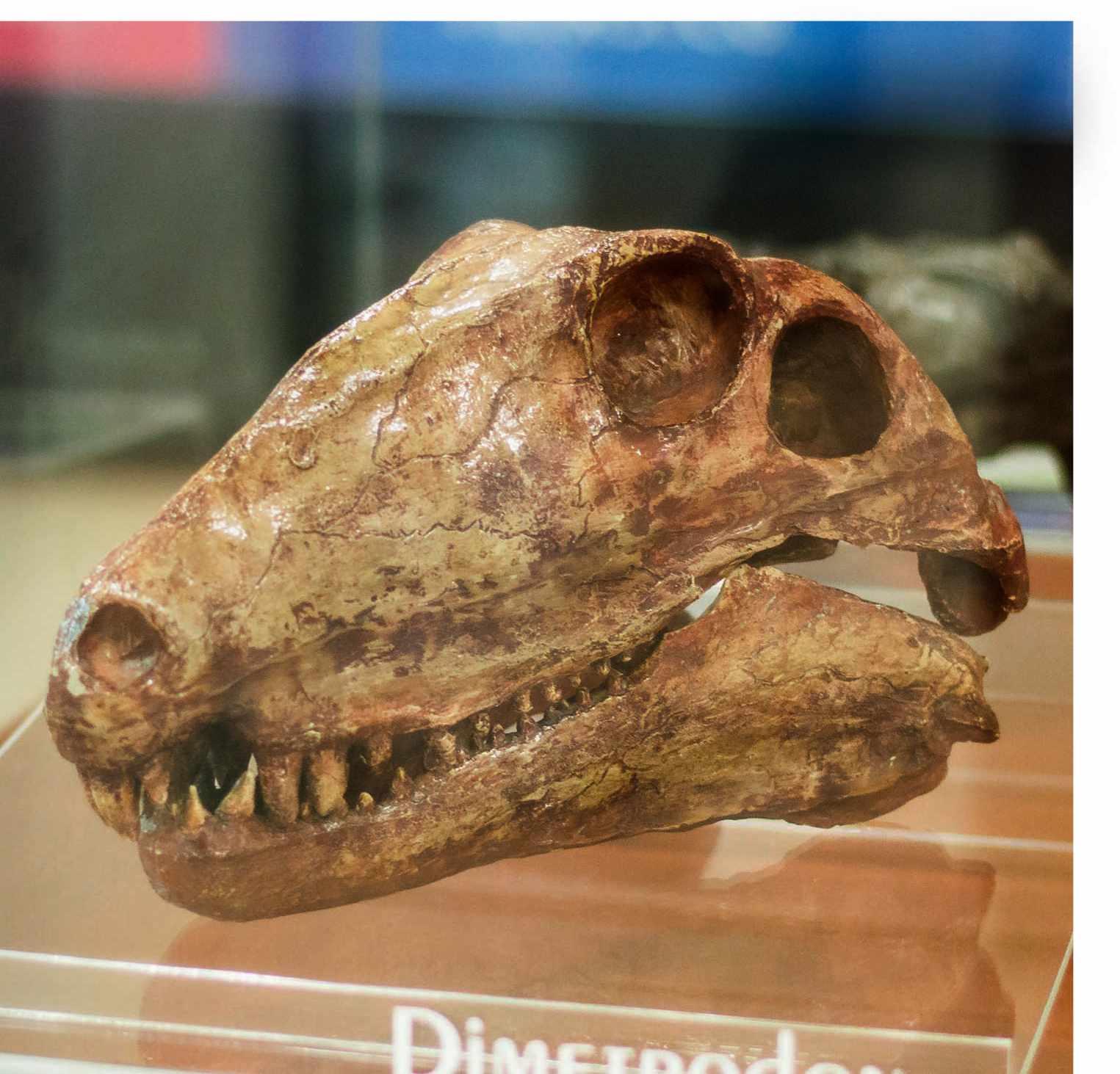 Sharp teeth enabled it to dismember fish, reptiles, amphibians and other protomammals
A Dimetrodon skull with the temporal fenestra clearly visible behind the eye socket
TIKTAALIK: GETTY; DIMETRODON: ALAMY
Sharp teeth enabled it to dismember fish, reptiles, amphibians and other protomammals
A Dimetrodon skull with the temporal fenestra clearly visible behind the eye socket
TIKTAALIK: GETTY; DIMETRODON: ALAMY
The ‘extinct’ fish that was rediscovered in the 1930s
Lived 420 m.y.a to the present day
This elusive fish still inhabits some deep parts of the Indian Ocean, but up until the mid-20th century it was thought to be longextinct. Then, in 1938, a strange-looking, 1.5m-long fish was caught off the coast of South Africa. After intense deliberation, expert ichthyologist JLB Smith declared it to be a Coelacanth.
Coelacanth is a not-too-distant cousin of Tiktaalik (see page 68). It also has four fleshy fins that resemble limbs, but never made the transition to life on land. Instead, it’s thought Coelacanth adapted to life in the deep, sheltering in caves during the day and only venturing out at night to hunt. It’s probably this adaptation that saved Coelacanth from annihilation during four of Earth’s ‘Big Five’ mass extinctions.


Lived 305-299 m.y.a
With a wingspan measuring more than 70cm, six spindly, spiny legs and huge compound eyes, Meganeura was terrifying enough to scare even the most ardent insect-lover. This four-winged monster is widely regarded as the largest flying insect ever, dwarfing its extant dragonfly relatives. Like many of today’s dragonfly species, though, Meganeura lived in open habitats close to ponds and slow-moving streams. It was likely the apex predator in these clearings, using the spines on its legs as a ‘flying trap’ to ensnare prey ranging from other flying insects to amphibians and even lizard-like vertebrates.
Fossils of Meganeura were first discovered in some coal-bearing rocks in France in 1880. These specimens were exceptionally preserved, displaying detailed networks of wing veins, which inspired the name Meganeura, or ‘large-nerve’.
Like Arthropleura (page 66), Meganeura is thought to have benefitted from a lack of competition from vertebrates and heightened levels of oxygen during the Carboniferous.
Fossils of the giant insect have been found in Derbyshire A prehistoric Coelacanth found off the Comoro Islands undergoes tests
Lived 247-208 m.y.a
Amass extinction known as the Great Dying took place 251.9 million years ago, wiping out more than 90 per cent of Earth’s species and leaving a lot of empty niches in its wake. Many of the survivors that evolved to fill these niches ended up looking like failed lab experiments, none more so than Tanystropheus – a 6m-long reptile with a neck longer than its tail and body combined.
Tanystropheus was initially misdescribed as a dinosaur, but it was a protorosaur and lived in the Middle Triassic, just before the first dinosaurs. It was long thought to have been too top-heavy to be terrestrial. But more recent studies argue that most of its weight was centred around its body, making it more than capable of walking on land.
Special jaws were used to eat hardshelled ammonites
It likely stalked the water’s edge, using its long neck to fish

Lived 382-358 m.y.a
It’s hard to imagine that an animal affectionately known as The Dunk was ever a fearsome predator, but Dunkleosteus was exactly that. For nearly 30 million years it ruled the northern hemisphere’s oceans with an iron first – or rather, an iron bite.
This 4m-long armoured fish had a bite force that would have rivalled some of the strongest biters today. At the very tip of its bony fangs, it’s estimated that Dunkleosteus may have been able to bite down at a force of 80,000 psi – enough to crush some of the strongest steel.
Special jaw muscles meant Dunkleosteus was able to open its mouth in less than a 50th of a second, creating a small vacuum that could suck in prey. It outcompeted many early sharks and for a long time dominated the niches that we now associate with sharks such as the great white.
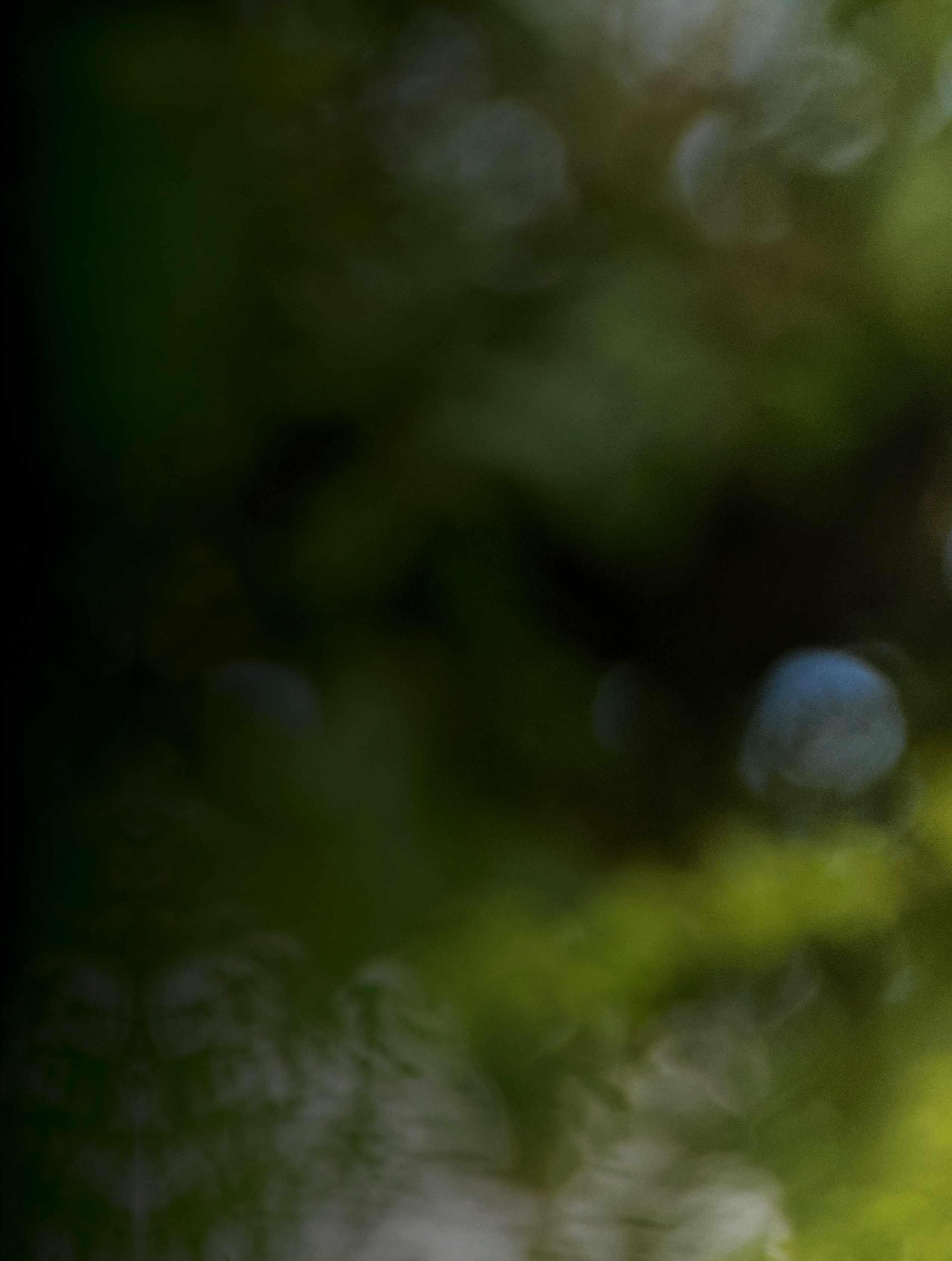
A glimpse into the secret life of the mandarin duck – a shy but beautiful bird that has made itself at home in the UK
Words and photos by NICK UPTON
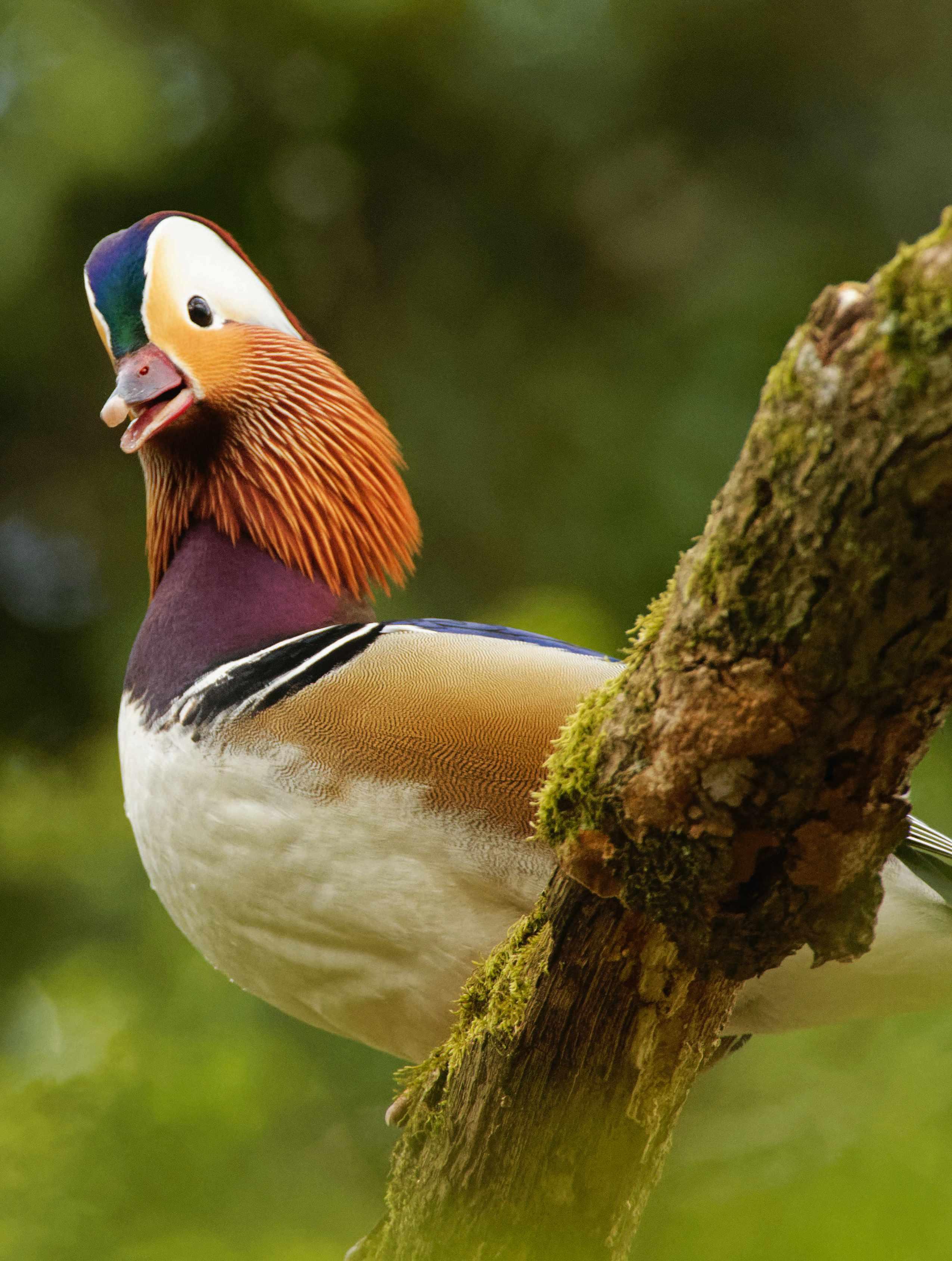
Native to the Far East, the mandarin duck became naturalised in the UK in the 1900s
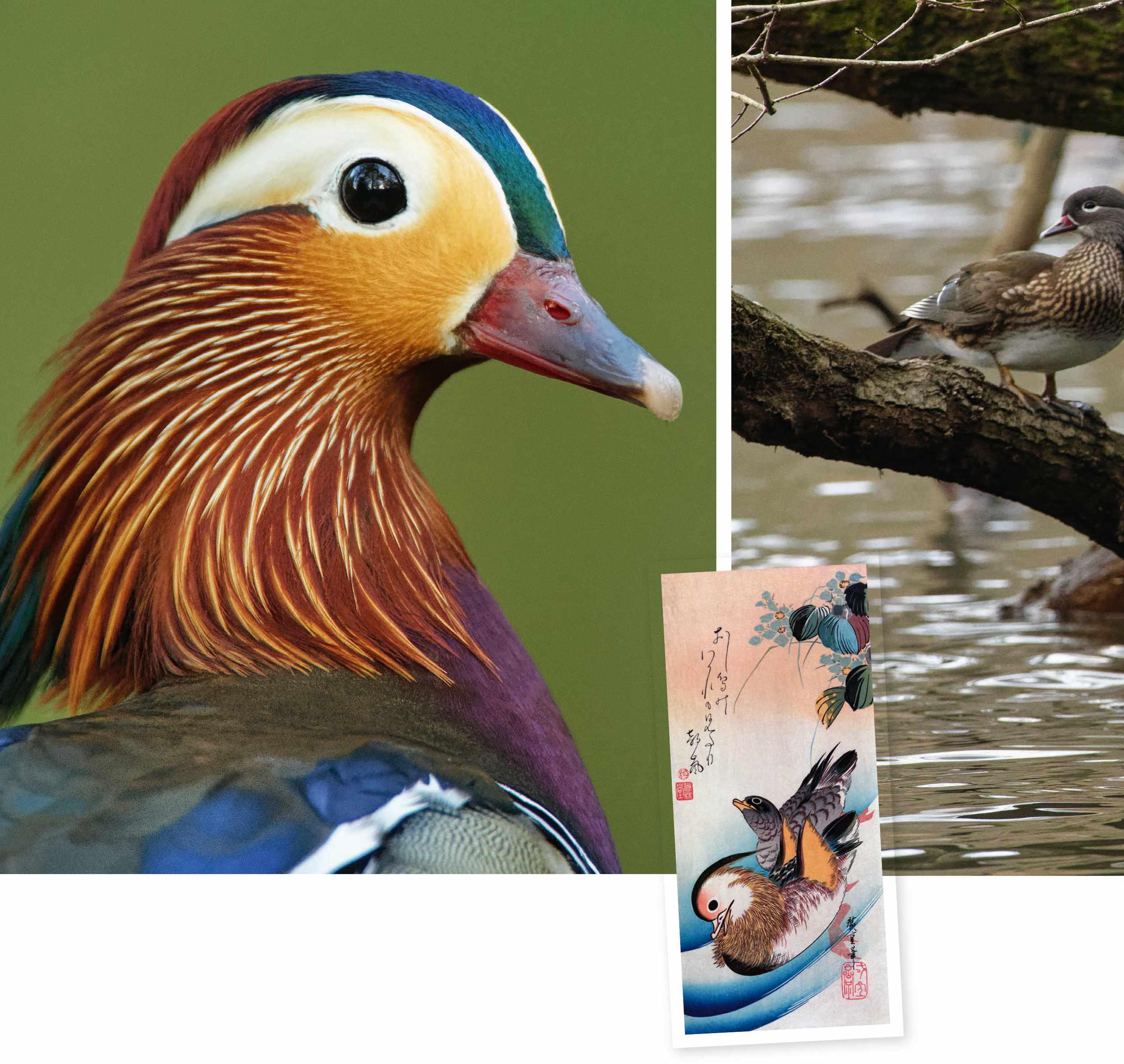
If I watch long enough, I might see some intriguing animal behaviour that’s never been recorded before. It is this thought that has long driven me as a biologist, filmmaker and photographer to wait – and wait – for special moments, and still does.
Perhaps never more so than during the past year, which I’ve spent obsessively photographing stunning, mercurial mandarin ducks in a magical ancient woodland: the Forest of Dean.
The chance to document the rather secret life of arguably the world’s most beautiful duck arose in autumn 2022, when I was canoeing down the scenic River Wye, on England’s border with Wales. As the forest thickened below the imposing crags of Symond’s Yat, I spotted the unmistakeably flamboyant purple, green and orange feathers of three mandarin drakes, huddled together beside a smartly patterned brown and grey female, on a branch overhanging the water. What were these exotic-looking birds doing here in this unlikely spot?

These ‘perching’ wood ducks, which grip branches with long-clawed toes, are native to the Far East. I’d encountered a pair 20 years ago on a mountain lake in Taiwan while directing a film for the BBC. We secured some distant swimming shots, but didn’t go as far as seeking their nests, which are made in tree-holes deep in the forest up to a mile from water. Mandarin ducks are revered in eastern cultures for their beauty, and symbolise wedded bliss due to the drakes’ attentiveness. They feature in oriental poems, on prints, paintings, porcelain and textiles, but few Taiwanese ever see these scarce, shy birds.
In the UK, we’ve long been able to observe mandarin ducks as part of wildfowl collections. A drake was sketched in a

Nick Upton is a behavioural biologist. He spent 25 years in natural-history filmmaking and is now a wildlife photographer. His images often feature in BBC Wildlife.
“Mandarin ducks symbolise wedded bliss in eastern cultures, due to the drakes’ attentiveness”
It is in Gloucestershire, bounded by the River Severn to the east and the River Wye to the west.
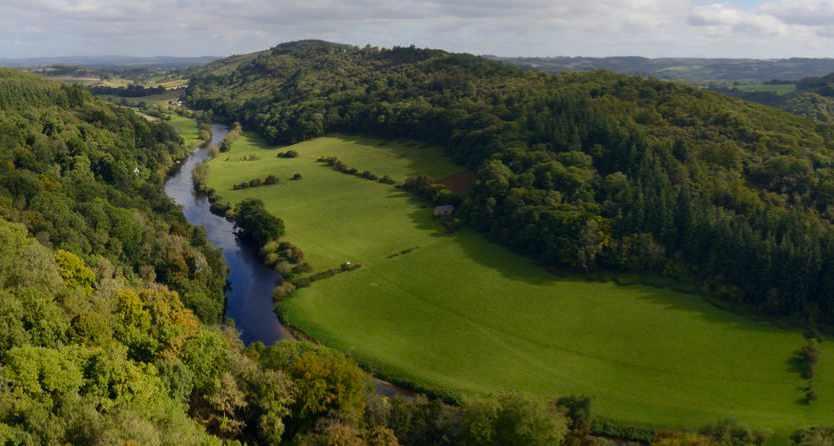


“The UK population is thought to have doubled in the past 20 years to some 15,000”
Richmond estate in 1745, the first breeding pair was recorded in London Zoo in 1834, and many were kept in menageries from the early 1900s. But the birds soon broke free of their ornamental confines. Escapees and released individuals founded breeding colonies on wooded country estates in Bedfordshire, Surrey and Shropshire, and have been quietly living in the wild here ever since, expanding their range across England and into parts of Scotland and Wales.
Gloucestershire’s Forest of Dean has become a major stronghold, with more than 250 mandarins now present since the ducks first bred here in 1983. Though it’s hard to count such elusive birds, the UK population is thought to have doubled in the past 20 years to some 15,000, a significant proportion of the world’s population of around 65,000. Globally, the species is
currently declining as many of its native woodland haunts have been felled in China and are threatened elsewhere.
Ilove a challenge, so After my first sighting of these lovely ducks, I made it my mission to capture some rare behavioural photos of mandarins in a wild setting. Suddenly, I found myself spending a great deal of time around the Forest of Dean’s many ponds, small lakes and streams.
Finding the ducks wasn’t difficult. I never failed to see some, but getting clear views in dense woodland with enough light was a major challenge. Initially I observed them from a distance of about 80m, before photographing interesting behaviour from closer, hidden vantage points, or waiting for them to move nearer to me.
Most of the mandarins I found were in areas where ancient oaks overhung water. They were sometimes close to much-used footpaths, but were well-hidden among the autumnal leaves, resting and preening on low branches in pairs and small groups. Gusts of wind triggered cascades of acorns to plop into the water, while the mandarins produced subtle choruses of low nasal grunts and high whistles when people approached, often sliding into water to swim away or taking to the air, usually returning once they felt safe.
Late in the day, they would often dabble for food or waddle ashore to seek acorns among the leaf litter. Mandarin ducks are mainly active at night, dawn and dusk, but they’re actually ‘cathemeral’, engaging in bursts of activity at any time of day. Such unpredictability needs a lot of patience to work around, but I was nonetheless hooked
Courting drakes raise their ‘sail’ feathers to



by these pretty, quirky ducks and encouraged by early successes with my long lens.
As early winter rolled in and courtship season unfolded, the mandarin numbers grew on their favourite ponds. Courtship is a group activity that begins in late autumn, once the males have grown colourful new feathers after their summer moult. It continues at intervals throughout the winter,
with increasing intensity as more pairs form. I learned to listen for the high, reedy whistles of drakes flying in overhead and whiffling down to land on the water. Sharp, coot-like ‘eeek’ calls of females triggered bursts of display, with rafts of drakes raising distinctive orange ‘sail’ feathers, pursuing females and chasing off rivals. A few skirmishes escalated to brief aerial chases, before both drakes plummeted into the water, squared up to one another and sent spray flying with beating wings.
During a snowy cold snap in December, I found only the deeper parts of one large pond unfrozen. More than 100 mandarins shared the crowded space with a mix of other ducks and swans. I lay quietly by the shadowed pond margin, capturing brief bursts of animated behaviour amid long periods of uneventful rest. Their winter courtship mostly involved
females assessing males performing elaborate false drinking (dipping the beak in water and raising the head without actually drinking), preening, rearing up and head-throwing displays accompanied by sneezy whistles.
I spent two productive – if brutally cold –January days among bushes by another mostly frozen pond. I’d never seen mandarins feeding so busily, albeit intermittently. Perhaps they needed more calories during a freeze. They were often too distant or hidden by reeds for decent shots, but they paddled closer at intervals, peering down intently before diving and surfacing with acorns they could – just –swallow whole. Wild mandarins are known to rely on acorns, chestnuts and beechmast in autumn and winter, but are said to dive rarely. I’ve found just two clear reports of them finding food – including acorns – underwater, yet I observed this behaviour many times.
Five more special birds that can be spotted in the Forest of Dean
The charming dipper lives up to its name, bobbing up and down on the water-lapped boulders of fast-flowing streams, before plunging in for up to 30 seconds to literally walk underwater as it hunts aquatic insects. It can be seen throughout the year.

This colourful little bird busily seeks invertebrate prey in trees and bushes, and matches the far more common goldcrest in the UK’s smallest bird stakes. Its head and shoulder markings are bolder, but its tell-tale high-pitched song is more monotonous.
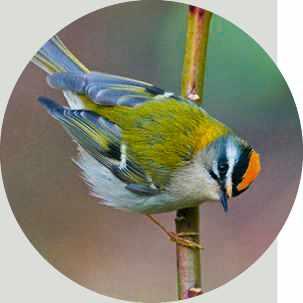
The rare ‘phantom of the forest’ is sometimes glimpsed dashing after prey through dense woodland like an outsized sparrowhawk, but its soaring spring display-flights are more easily watched from impressive forest overviews at Symond’s Yat Rock and New Fancy.
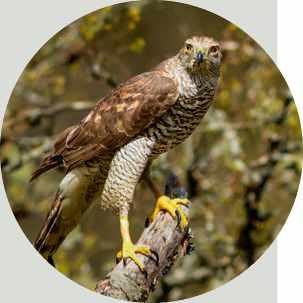
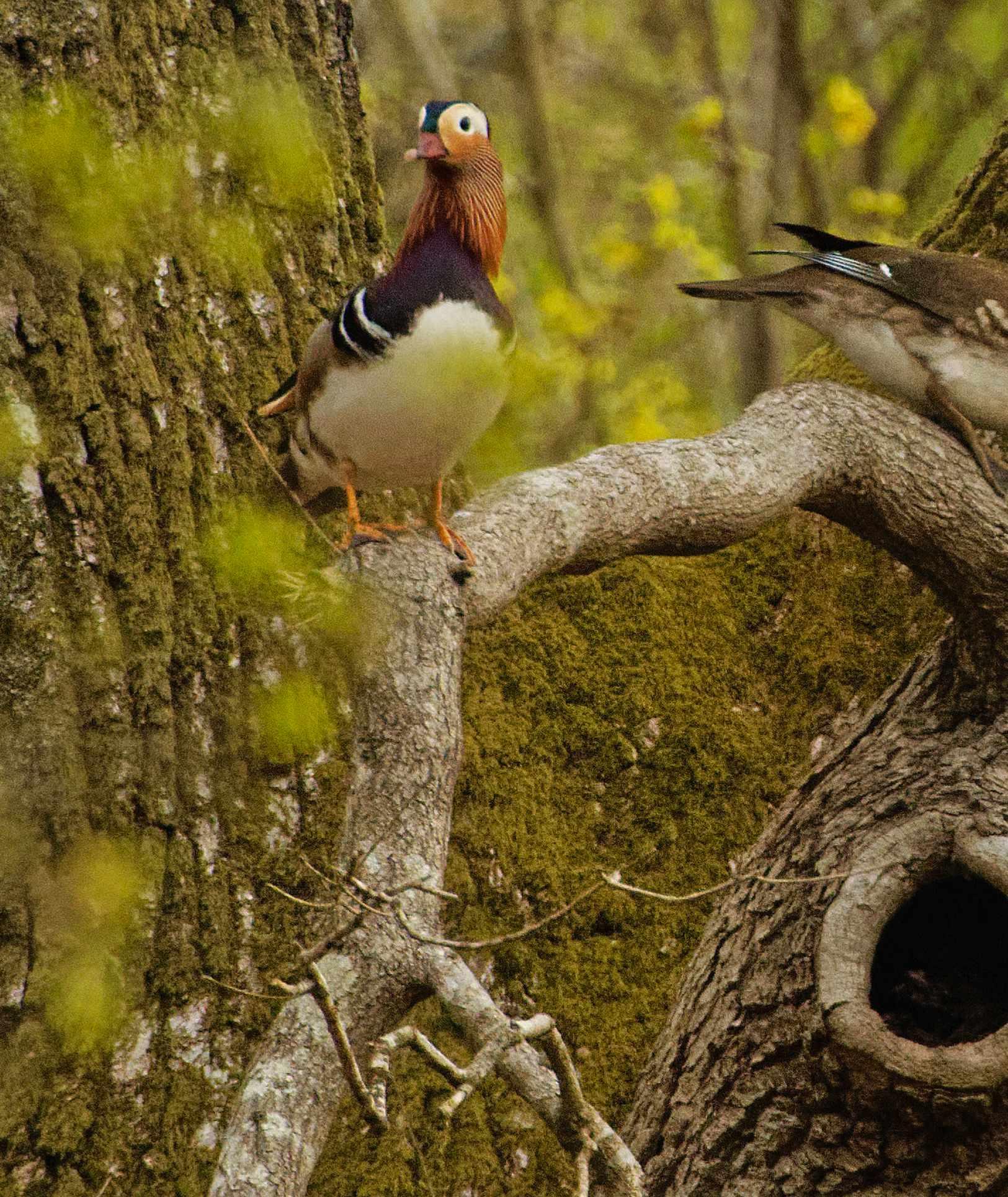
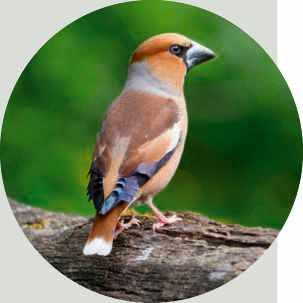
Spotting this large, colourful finch with a huge beak is tough in summer tree canopies, but it’s more easily seen in cooler months foraging on the ground for fallen nuts and seeds, and for berries in yew trees. In recent years, their breeding areas have declined and they are now red-listed.
Listening for the churrings of this nocturnal bird on open heathland and clearfelled forest sites is a magical experience, potentially heightened by seeing hawk-like silhouettes gliding across sunset skies.

Courtship intensified in February, with many distinct pairs forming, feeding together and preening each other’s heads. In early March, the birds seemed to disappear, busy, I assumed, setting up homes in natural tree holes or cavities drilled by nesting woodpeckers. Keen to document some nesting behaviour, I trudged many miles over the next two months through atmospheric groves of ancient oaks, listening for calls and scanning for drakes, which reportedly stay close to their mates hidden in tree holes.
Ihad no luck finding definite mandarin nest-sites, which was frustrating, but other sights buoyed my spirits: a water shrew diving for prey; a long-eared bat fluttering around by day and landing to devour an insect; stripy wild boar piglets rotavating woodland soil for food. And, in what I believe is a new record, crafty crows catching spawning toads, stripping the hind legs of their toxic skin and gulping the limbs down whole. Wild woods are full of surprises.
The few mandarins I did see were usually grazing on fresh grass near pond margins,
seeking sprouting acorns within the leaf litter, or nibbling unfurling oak leaves and moss on branches. I often encountered one particular pair resting and preening in one corner of a shady woodland pond. They accepted me sitting quietly nearby, a little closer each day, and in early May I saw them mating briefly. The female had swum towards her mate, her head stretched low to show her receptiveness.
I hoped they would let me photograph them nesting – and I got tantalisingly close. One early May evening I saw them fly across the pond and land by a small dead tree beside a footpath. The female jumped up to enter a gaping crevice just half a metre off the ground while the male waited below. Surely she wouldn’t nest so low, right beside a path?
No. She re-emerged and they flew into an old oak not far from where I was sitting. My hopes rose as I photographed the birds peering into two tree holes about 6m up, but they soon moved on. I watched the female enter another cavity a few days later, but never saw her visit the same hole twice.
Studies in China and Surrey have shown that around half of mandarin clutches include eggs sneaked in by others, so perhaps she was

“Arriving females flew teasingly close over my head, probably from nests in trees not far behind me”
actually seeking active nests in which to dump her eggs for other females to incubate!
The few other individuals I saw at ponds in the early summer were drakes, mostly bachelors, but some clearly had mates nesting nearby. I learned to listen for the distinctive ‘ack-ack-ack’ ‘inciting’ calls of a female flying in to feed near her swimming mate at dusk. He’d stick close to her as she foraged, driving off other drakes while she pecked down and sideways to signal her lack of interest. Arriving females sometimes flew teasingly close over my head, probably from nests in trees not far behind me. I spent several dusk periods watching individual tree-holes, hoping to photograph their occupants coming and going. I never succeeded fully, but it was fun watching the
light, agile mandarins jinking through the canopy and virtually hovering as they came into land on branches.
I’ve yet to see the magic moment of 12 or more tiny, downy ducklings leaping 7-8m down from a nest, urged on by mum calling from below, which occurs soon after all the eggs have hatched. Nevertheless, I did twice photograph recently emerged broods that had just waddled to a pond. They part-ran, part-paddled furiously over the water after their mother before disappearing into dense marshland to feed on invertebrates. I didn’t see any of them again for another six weeks, at which point the now fluffy, full-grown young mandarins were appearing at ponds and lounging on fallen trees. By now, their fathers, who’d left their mates to rear the
I often saw mandarin ducks surfacing with acorns despite all sources I came across saying that they rarely dive. The only detailed study of wild-living mandarins I could find was conducted more than 70 years ago in Windsor Park, where the birds often fed on crop leftovers. But perhaps diving for nuts is a regular occurrence in their ideal habitat of deciduous woodland surrounding small ponds.
hatchings, were barely recognisable, having shed the fancy plumes of courtship. Only their reddish bills separated them from the females.
Mandarin ducks, with their unique lifestyle, don’t appear to impact native species negatively, but may compete for tree holes. Raised nestboxes can increase their breeding success. Yet there is a remote possibility that they are not an introduced species, but are simply making a comeback. Fossil remains of a smallish duck have been excavated from 600,000-year-old marshy woodland deposits in Norfolk. These were initially identified as mandarin duck bones in 1979, with a former range across Eurasia postulated, though a recent review has cast doubt on the accuracy of the identification.
Whatever the mandarin’s history, it’s clearly found a perfect home-from-home in our ancient woodlands. It’s been a real privilege to spend so much time learning some of its secrets, and to watch so much other woodland life unfold in the fabulous Forest of Dean.

NORTHUMBERLAND
Luxury Bed & Breakfast in Northumberland. Chatton Park House is an award-winning luxury Northumberland estate, offering 5-star adults-only B&B accommodation in the main house and a separate private detached 5-star lodge in its own grounds. Nearby there are wonderful beaches, countryside, castles and cosy pubs. Please quote “nature 10” on booking to receive a free bottle of wine.
chattonpark@gmail.com | chattonpark.com

SOMERSET
Tucked away in 20 acres of tranquil Somerset landscapes, Homewood stands as the ultimate countryside staycation. Picture a mix of quirky, lavish, and just a tad eccentric – envision a majestic Georgian country house surrounded by artistic masterpieces and modern luxuries, boasting a spa and a heated outdoor swimming pool. Homewood, Abbey Lane, Freshford, BA2 7TB
01225 580439 | homewoodbath.co.uk

Darwin Forest is an award-winning lodge holiday park in the Derbyshire Peak District. It combines luxury accommodation with fantastic facilities, all located in a tranquil forest setting. It is the perfect place to stay for visiting local attractions such as Chatsworth House or as a base for exploring the miles of picturesque Derbyshire footpaths. It is pet-friendly too.
01629 732428 | darwinforest.co.uk

GLAMORGAN
Sitting in the heart of the stunning Afan Valley in South Wales, the 15-bedroomed Afan Lodge provides the perfect retreat for those seeking peace, nature, wildlife, gentle walks and cycle trails. The hotel offers comfortable twin, king size, family and accessible rooms, many with beautiful valley views, plus outstanding food and first-class service. Dogs are also welcome. Secure cycle storage is available.
01639 852500 | stay@afanlodge.wales | afanlodge.wales

CO. DURHAM
Burnhopeside Hall is a Grade II* listed building of historical interest, having been the home of 19th century engineer William Hedley. The country house provides a beautiful setting for a peaceful and relaxing stay for business or holiday travellers. It is surrounded by 475 acres of gardens, woodland and farmland, with walking routes into the surrounding countryside.
01207 520222 | burnhopeside-hall.co.uk
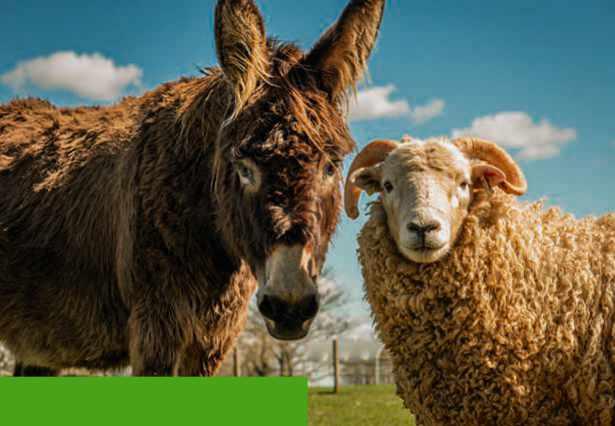
With deposits from £30, you can enjoy unlimited free entry to the Farm Park throughout your stay at Cotswold Farm Park Holidays. Discover a range of affordable holiday options, from luxury lodges, safari tents and camping pods to pitches for tents and caravans, all set in the beautiful Cotswolds countryside. Cotswold Farm Park, Guiting Power, Cheltenham, Glos. GL54 5FL
01451 850307 | cotswoldfarmpark.co.uk/holidays
The Bees are buzzing and the buds are blooming. Take a look at these ideas to help you grab a stunning spring break and make the most of the British countryside

With the world famous spring gardens, a magnificent castle and stunning beaches, Caerhays really is a magical place to stay on the south coast of Cornwall. Ranging from a wing of the castle to a contemporary barn conversion, whether in rural seclusion or the sea crashing at your bedroom window, at Caerhays Holidays we offer a unique opportunity to stay in a choice of twelve diverse properties.
01872 500026 | caerhaysholidays.co.uk

Discover the beauty of Exmoor at Exmoor Camping Barn. Set on a 25-acre farm with stunning views of the valley. Steeped in history, explore 600 miles of trails and stargaze in Europe’s first Dark Sky Reserve. A 170-yearold, self-catering barn that sleeps 10, strikingly restored for the perfect rural escape.
enquiries@exmoorcampingbarn.co.uk exmoorcampingbarn.co.uk

Marley House, an idyllic Retreat in Dorset. Voted ‘Best Luxurious B&B in Dorset ’ (SME News’ Southern Enterprise Awards 2023), Marley House bed and breakfast is two miles from the iconic Durdle Door and the Jurassic Coast. We offer personalized services, elegantly designed bedrooms, delightful breakfasts and close proximity to the region’s varied attractions.
jan@marleyhouse.co.uk | marleyhouse.co.uk

Your Dartmoor Adventure awaits... Love the great outdoors? Our majestic 275-acre country estate has something for everyone seeking an unforgettable adventure on Dartmoor National Park. Enjoy our Abercromby 18-hole championship golf course, Elan Spa, and numerous other on-site country pursuits, including archery, fly-fishing, walking, deer park tours, cycling and bushcraft activities for children.
01647 445000 | boveycastle.com

Discover the beauty of Griffon Forest and unwind in the comfort of your lodge, surrounded by a haven of birds, animals, and plants. Stroll along the woodland trails or relax in your hot tub and watch as the resident wildlife go about their daily adventures. Located just eight miles from York on the Sandburn Hall Estate.
01904 468787 | griffonforest.co.uk
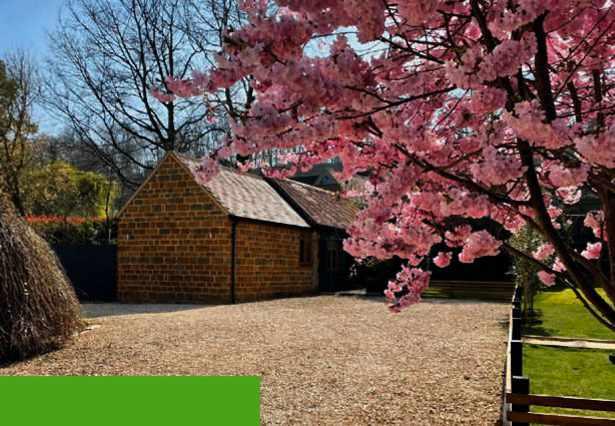
Set in four acres within the Cotswold Area of Outstanding Natural Beauty lies a collection of three luxury holiday cottages. Located in the beautiful quintessential Cotswold village of Warmington on the north-eastern tip of the Cotswolds. Ideally located for exploring Warwick, Stratford-upon-Avon and Banbury.
07967 664897 | hillsidecottages.co.uk

Avian lifespans are something of a paradox. Birds live fast, but they don’t die young. They burn energy at more than twice the rate of similar-sized mammals, so they should theoretically age more quickly due to the faster accumulation of harmful biochemical by-products. And yet, for reasons that are poorly understood, they generally live about three times longer
and show few signs of age-related decline. Large parrots routinely exceed 60 years in captivity. A macaw once owned by Winston Churchill reportedly made it past 100. The oldest wild bird on record, a Laysan albatross named Wisdom, is still going strong at 72 and was seen incubating an egg in 2020. Even a tiny broad-billed hummingbird weighing just 5g can live for 14 years. Among garden birds, house
sparrows can reach 18, blackbirds 20 and goldfinches 27. Most, though, will be picked off by predators long before that and nearly half don’t survive their first year.
At the other extreme, few Japanese quail live beyond three. This might be due in part to the rigours of their intense reproductive lives. Reaching sexual maturity at two months, they pump out a clutch of 10 eggs two or three times a year.
Cephalopods such as octopuses use suckerbearing tentacles to manipulate prey
Does any major group of animals include members as strikingly different as molluscs? Think of a cockle and an octopus. The former spends its life within a shell buried in sand, where it filters microscopic food, surfacing only to cast its eggs or sperm into the plankton. Nothing it does requires a brain, or even a head – and indeed it has neither. An octopus, on the other hand, is an agile, inquisitive, dextrous, colour-changing, shape-shifting genius.
Most molluscs belong to one of three classes. Bivalves (cockles, clams, mussels, oysters and the like) are characterised by a two-piece hinged shell, and are mostly sedentary filter-feeders. Gastropods (snails, slugs, conches etc) usually possess a single, coiled shell and are mobile grazers or predators. Then there are the cephalopods, an exclusively marine group comprising octopuses, cuttlefish, squids and nautiluses, as well as the extinct ammonites and belemnites. Like other molluscs, cephalopods are rubbery, nonsegmented animals usually equipped with some sort of shell. But they have taken the basic molluscan body plan and transformed it almost beyond recognition.
lightweight, chalky internal structure involved in maintaining buoyancy. Most octopuses, meanwhile, have no shell at all.
A mollusc’s shell is secreted by an organ called the mantle, visible as fleshy lips around the shell’s opening. In cephalopods, this has been re-engineered as a muscular chamber that provides jet propulsion by pumping water out through a siphon.
Another organ typical of molluscs is the foot. Used by gastropods for gliding and by bivalves for burrowing, in cephalopods it has transformed into a head (‘cephalopod’ derives from the Greek for ‘head foot’) equipped with a pair of sophisticated eyes and sucker-bearing arms or tentacles used to catch and manipulate prey.
“Cephalopods can match a colour despite being colourblind”
Unique to cephalopods is their ability to change skin colour, pattern and texture for camouflage and communication. Colourchange is achieved with pigmented cells that can quickly expand or contract. Mysteriously, cephalopods are able to match a background colour despite being colour-blind.

Let’s start with the shell. Among living species, only the ammonite-like nautiluses have a conventional external shell. In squid, it has been reduced to a long, flattened internal structure called a ‘pen’, which stiffens the body. In cuttlefish, it is a larger,
Octopuses and cuttlefish are widely hailed as the most intelligent invertebrates, capable of solving complex puzzles to access food, using tools, deceiving rivals and even planning for the future by rejecting one treat today on the promise of two tomorrow.
The group also includes the largest living invertebrate, the colossal squid, which can weigh half a tonne. Cephalopods, it seems, can be big and clever.
Thousands of receptors are packed into an elephant’s trunk

called the olfactory bulb, which registers the signal, integrates it with others and communicates with other brain centres, so that an animal can use the information to find food, choose mates, distinguish friends from enemies and avoid predators.
As for the best sense of smell, it depends on how you measure it. Is it the one that can distinguish the greatest variety of smells? If so, a study published in 2014 points to elephants. Given all the other uses of an elephant’s trunk – feeding, drinking, showering, shelling peanuts and carrying logs – it’s easy to forget that it is also an organ of smell. The study scoured the genomes of a range of mammals for genes that code for nasal receptor proteins. With 2,000 such genes, each coding for a different receptor, elephants have more than other contenders such as dogs (800) and rats (1,200), though other likely candidates, such as bears, were not assessed.
Be they big, small, pointy, flat, pendulous or upturned, noses are funny things. These holey protuberances are prone to drip, twitch, sniff, snort, whistle and sprout hair. And it doesn’t help that they are slap-bang in the middle of the face for all to see. They get poked into things – literally and figuratively – and wherever an animal goes, its nose almost always gets there first. But a sense of smell – a system for detecting and distinguishing airborne
molecules – is about more than just noses. Air drawn into the nostrils passes through the nasal cavity, the walls of which are dotted with a multitude of nerve endings. Each of these is equipped with a complex folded protein called a receptor that is configured to fit precisely with molecules of one particular shape, like a lock and key. A perfect fit triggers the sending of a nerve impulse to a region of the brain
This is widely held to be the lion’s mane jellyfish, based on the description of an animal caught off western North America by a geologist in 1856: “I measured myself a specimen at Nahant, the disk of which had attained a diameter of 7.5 feet [2.3m], the tentacles extending to a length of more than 120 feet [37m].” That’s longer than a blue whale, though biologists aren’t entirely convinced. More reliable are measurements of Nomura’s jellyfish from East Asia. Its tentacles are less impressive, but it can reach 2m in diameter and 200kg in weight.
“The nasal cavity has a multitude of nerve endings”
Another possibility is that the best sense of smell can detect the faintest whiff. By this measure, it’s hard to beat a male silkmoth, which can sniff out a female’s sexual pheromone at a concentration of one molecule per 100 quadrillion (that’s a one followed by 17 zeros) air molecules. And a moth doesn’t even have a nose. How does it smell then? To ruin a perfectly good joke, it has receptor proteins on its antennae. The size of the olfactory bulb might also be a good measure of an animal’s sense of smell. Among birds, they don’t get any bigger than those of turkey vultures, which rely on scent to detect carcasses from high in the air. Bears, too, are well endowed in this respect, and there is evidence that polar bears can detect seal breathing holes from 3 km away. No clear winner then. Perhaps it’s just a case of picking your nose.

Scientists estimate that there could be two million species of fungus yet to be discovered. There are already about 200,000 described species known to exist across the world.
here ar n’t an mals th t n i take e ire l n sc his appe s geologi l continen he o erh ps, ou tain r ng ba hed o sett ng uget c ab squ t, robus Paci
There aren’t many animals that can be mistaken for an entire landscape. This crustacean appears geological – a continent rising from the ocean, perhaps, or a mountain range bathed in the light of a setting sun The Puget Sound king crab is a squat, robust species from the Pacific coast of North America. Measuring up to 25cm across, it is wider than it is long, shorter in the leg department than most king crabs, and equipped with powerful crushing claws that make light work of a sea urchin.
Stuart Blackman
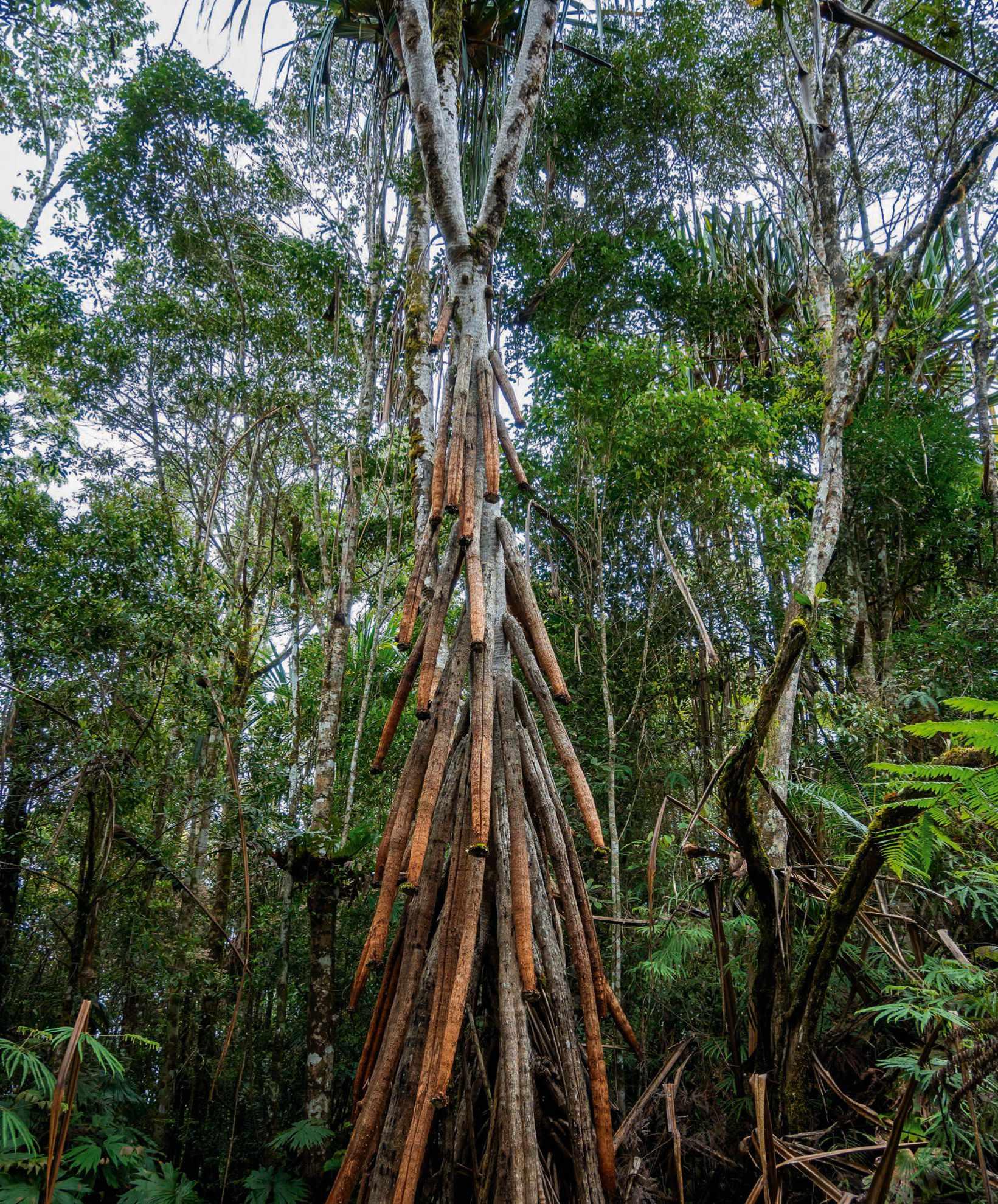
Plants don’t really do locomotion. True, some seeds can travel long distances on the wind or in the stomachs of animals, and tumbleweeds scatter theirs by uprooting and rolling around in the background whenever a joke falls flat. But as a rule, plants aren’t going anywhere.
Still, there is one enduring story out there about a ‘walking tree’. It concerns a tropical American palm named Socratea exorrhiza, whose trunk is raised off the ground on a cluster of stilt-like roots. It is said to be able to haul itself out of the shade and into sunnier spots by growing more
roots on one side and losing them on the other.
In 2015, the BBC quoted a Russian biologist working in Ecuador who claimed to have seen them move up to 20m in two years. Evidence, though, hasn’t been forthcoming. What has been shown is that the roots provide a wide, stable base for the tree, enabling it to grow tall without having to increase its girth. This gives the young palms an advantage in the race towards gaps in the canopy. In which case, the trees can indeed move into the light; it’s just that they take the lift rather than walk.

A gulper (or pelican) eel mostly looks like it should – long and sinuous – until it feeds, when it’s more like a balloon on a stick. This denizen of the deep is equipped with enormous jaws that extend backwards from the head, terminating in a pair of elbow-like hinges. Gulpers are lunge feeders, taking in smaller prey with a huge mouthful of water that causes the head to expand spectacularly. The water is then expelled through the gills, while crustaceans, fish and squid are swallowed.
Most plants are hermaphrodites. A typical flower bears both male and female parts that produce, respectively, pollen and ovules. A minority of hermaphrodite species, though, keep the male and female parts on different flowers. This strategy is called monoecy (Greek for ‘one house’) and species that employ it are described as monoecious. The male and female flowers can look very different: female hazel flowers are red pointed stars, while male hazel flowers are pendulous catkins.

In aquatic birds, only penguins have given up on flight. Their flipper-like wings would be useless in the air but come into their own underwater. Penguins tend to swim faster than other diving birds such as puffins, guillemots and dippers, and the fastest of them all is thought to be the gentoo. According to Guinness World Records, the species is said to be able to reach 36kph in short bursts – about as quick as a human can run over 100m with only air resistance to contend with.
According to a definition from the United Nations 1992 Convention on Biological Diversity, biodiversity is “variability among living organisms from all sources [and] includes diversity within species, between species and of ecosystems.” And yet conservation organisations often quantify the ongoing biodiversity crisis by loss of species. So why doesn’t the number of species reflect variety in nature?
What influences diversity?
Biodiversity results from a dynamic balance between extinction, migration and speciation (the creation of new species) –an equilibrium that’s disrupted by human activities such as overexploitation of natural resources. But those artificial causes aside, geography has a big influence on why some places are more diverse than others.
How is biodiversity distributed?
One notable pattern is an increasing gradient in diversity with latitude (from poles to tropics), which suggests that life has an ideal temperature range. There’s also an uneven distribution among freshwater, marine and terrestrial habitats.
About 15 per cent of macroscopic species (visible to the naked eye) are aquatic, while 85 per cent live on land. This discrepancy is explained by three factors.
First, productivity: land plants produce more energy to power ecosystems if they absorb sunlight in the open (unfiltered by water).
Second, habitat complexity: rainforests and reefs are biodiversity hotspots because plants and corals form 3D structures that become homes to other organisms. Third, physical differences between media: water is denser than air, for instance, so animals expend more energy moving through it.
What’s wrong with counting species?
The number of species in a particular place, ‘species richness’, has several shortcomings. One problem is that it only reflects diversity at a low level of biological classification (taxonomy). So if I said one area contains two species and another has three, you might conclude that the second is more diverse. But if all three species in the second area are in the same family (let’s say lion, cheetah, domestic cat) and the first contains two different families (cat, dog) then you could argue that the place with fewer species has greater diversity.
Another issue with simply counting species is it doesn’t consider individuals – the diversity within each species. A population with few members has a small gene pool, which gives natural selection less raw material

– distinct individuals – if an environmental change (such as a new disease) forces the population to adapt or go extinct. So a habitat is more diverse when the relative abundance of individuals living there is similar among species, known as ‘species evenness’.
So how is diversity measured?
Clearly ecologists don’t collect every individual of each species from an area. Instead, they extrapolate from samples, which might involve identifying species in video recordings, reading DNA from the environment or even acoustic surveys. But sampling alone is vulnerable to bias because numbers of recorded species are higher when an area is large or more time is spent there, and so scientists use statistical models to estimate species and individuals. That gives an ‘index’ that combines richness and evenness. An index is an abstract figure, however, which explains why conservationists still publicise numbers of species.
Why does biodiversity matter?
Just as diversity within species (related to evenness) offers a population the potential
to adapt to change, diversity between species (greater with richness) gives an ecosystem better resilience. If one prey species becomes unavailable, for example, a predator can find an alternative source of food.
Unfortunately, we humans don’t really preserve biodiversity, we protect specific species – charismatic creatures with aesthetic appeal, such as pandas, even though vertebrates are only one of the 32 phyla (a high taxonomic level) that make up the animal kingdom. The rest are invertebrates and include insect pollinators vital to plants, the producers that energise almost all of Earth’s ecosystems. Because we’re selfcentred, the best way to protect biodiversity itself may be to promote its benefits to ourselves – ‘ecosystem services’ that supply things like food, fuel and pharmaceuticals.
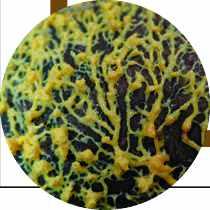

Named after the Arizona Gila River basin, where they were first discovered, Gila (pronounced hee-lah) monsters are one of only a small number of venomous reptiles and the largest lizards in the USA. The creatures have a frightening reputation, especially in local folklore, as they can deliver an agonising bite, but they pose little risk to humans if left alone.
Where do Gila monsters live?
Gila monsters are found in south-west USA and north-west Mexico, with the core of their range in Arizona and Sonora. The total adult population size is unknown but according to the International Union for the Conservation of Nature (IUCN), it is at least several thousand. These reptiles have a home range of about 2.6km2 and inhabit
dry areas such as desert grassland and scrubland, canyon bottoms, dry creeks and rocky slopes. They spend more than 90 per cent of their time in underground shelters, only emerging to hunt or bask. Though solitary, they do occasionally share these refuges with other Gilas.
What do Gila monsters eat?
Gilas can consume up to a third of their bodyweight in one meal. They have a strong bite and swallow most of their food whole. Using their forked tongues to pick up scents, they raid nests to prey on small birds and eggs, and also eat small mammals (particularly young rabbits and ground squirrels), other reptiles, insects and carrion. They don’t need to feed frequently as they store fat in their thick tails and stocky bodies, which explains why they can spend so much time underground to escape the intense heat.
When do Gila monsters use their venom?
They are more likely to use their venom on predators – coyotes, snakes and birds of prey – than on prey as they can easily handle their choice of food. The venom is released from glands in the Gila monster’s lower jaw and flows through their grooved teeth when they clamp down and chew. The venom attacks the nervous system, causing severe pain and a drop in blood pressure. When these reptiles bite, they secure a firm hold and usually hang on.
How has the lizard’s venom saved lives?
While studying Gila monster venom, scientists discovered a hormone called exendin-4. It’s similar to the human hormone GLP-1, which increases insulin production in the pancreas. This led to the development of a new drug called exenatide (the venom’s hormone in synthetic form) to treat type 2 diabetes. Exenatide mimics the effects of GLP-1, boosting the human body’s ability to release its own insulin.
When and how do Gila monsters breed?
Gila monster breeding season usually begins in late spring to early summer. Adult males compete for mating opportunities by engaging in wrestling matches, and mating
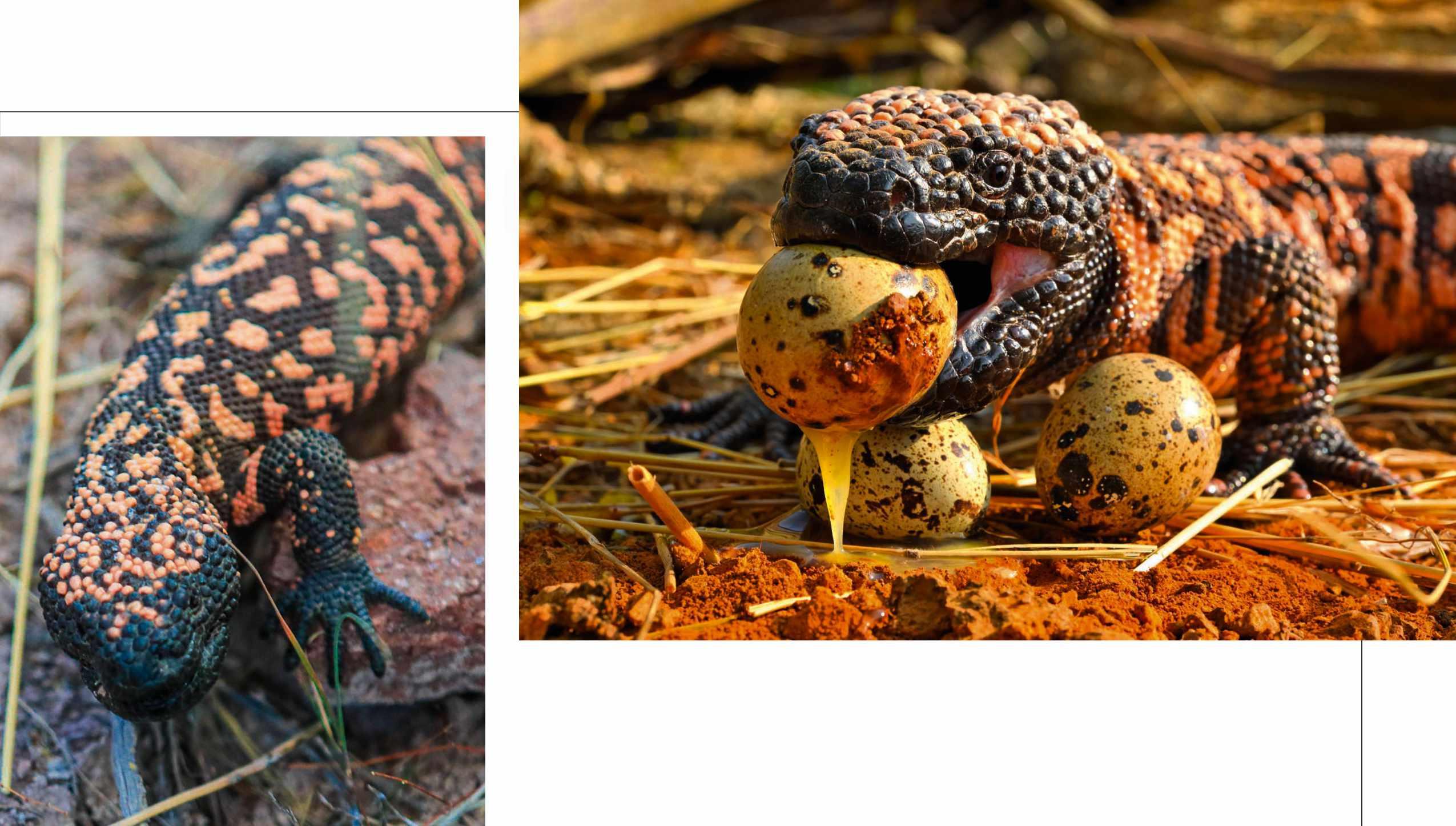
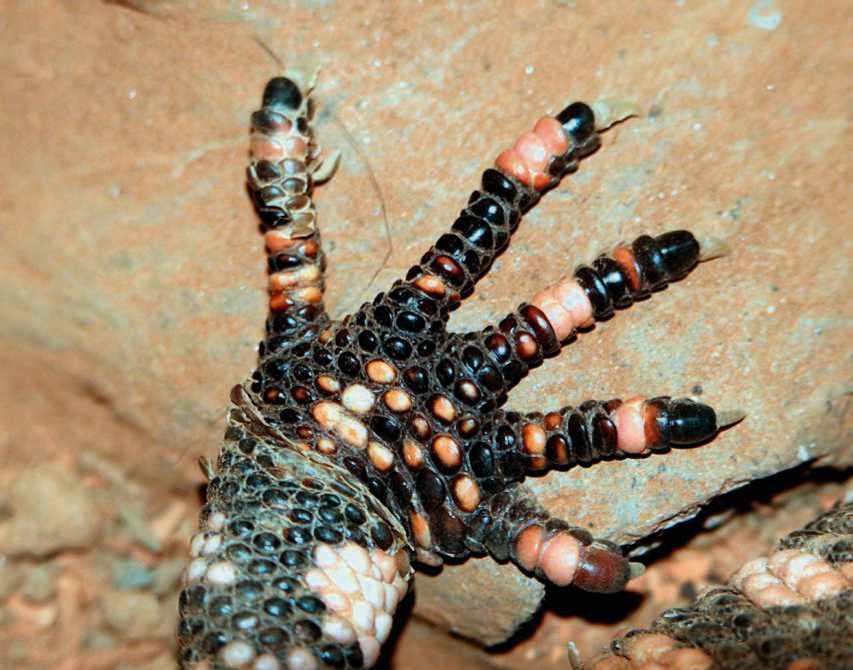
reportedly takes place underground and in sheltered sites. Females then dig holes, lay clutches of approximately two to 12 ovalshaped eggs and cover them. This tends to occur before the onset of the monsoon, to reduce the chance of the eggs drying out.
When do Gila monster young emerge?
Based on observed incubation times in captivity, hatchlings should appear after four months. However, a study by Arizona State University suggests wild Gila monster young overwinter, remaining in their nests for seven to 10 months after hatching. Hatchlings from eggs laid in July did not emerge from their nests until late April through to early August the following year. It is thought that a later emergence gives the best chance of survival. If the Gilas emerged in early spring, their prey (the kits of rabbits, for example) would be too big for them to eat. In summer, other lizards begin to lay eggs that young Gila monsters can consume. Another benefit of biding their time is that temperatures are warmer when the reptiles are foraging under the cover
AT A GLANCE
Scientific family
name: Heloderma
Lifespan: up to 20
years in the wild
Length: up to 56cm
Weight: 1.8kg

of darkness. A hatchling is about 16cm in length and will grow up to 56cm, reaching maturity at three to five years.
Do Gila monsters face any threats?
The species is listed as Near Threatened by the IUCN. It is in decline due to habitat loss, driven by urbanisation and agricultural development throughout much of its range. Also, though collection is prohibited, populations have been illegally exploited by commercial and private collectors. The species is listed on CITES Appendix II and some areas of its range are protected from development, such as national parks and federal wilderness areas.
Why do they have beaded scales?
The genus Heloderma means ‘studded skin’ and accurately describes the bony deposits in the Gila monster’s skin. These are known as osteoderms and cover the lizard’s bulky black body, apart from the underside. The protective bead-like scales, alongside pink or orange markings, warn other animals to keep their distance.
Are there any subspecies?
Two subspecies are recognised. In the southern subspecies, the reticulated Gila monster (Heloderma suspectum suspectum), the reptile’s bands are broken up to form a reticulated pattern. In the northern subspecies, the banded Gila monster (Heloderma suspectum cinctum), markings generally form bands across the back.
SHOEBILLS
Big-billed African waders


ACROSS
8 Tree that produces a firm, juicy drupe (4)
9 Large rodent of South America (5)
10 Kingfish (4)
11 Macaw or cockatoo, perhaps (6)
12 Small songbird such as the dunnock (8)
13 ___ eel, fish that shocks its prey (8)
15 Insect-eating songbird of North America (6)
17 Female of the species Panthera leo (7)
19 ___ beetle, insect that secretes cantharidin in self-defence (7)
22 Desert rodent (6)
24 Projection on the bill of a baby bird (8)
26 North Sea islet known for its gannetry (4,4)
28 Like the foot of a grebe or coot (6)
30 Extinct bird of Mauritius (4)
31 Songbird, usually tropical, that might be giant, whiskered or noisy (5)
32 Wingless parasitic insects (4)
DOWN
1 Jumping parasitic insect (4)
2 ___ marten, weasel-like mammal of the USA and Canada (8)
3 Dark-plumaged sea duck (6)
4 Fish or other creatures netted unintentionally by fishing boats (7)
5 Amber-like resin from certain African trees (3,5)
6 Island of South-East Asia, home to orangutan and pygmy elephant (6)
7 Fast-swimming mackerel shark (4)
14 Major river of France, rich in fish and phytoplankton (5)
16 ___ goose, tundra-breeding waterbird (5)
18 Flowering seashore plant, Glaucium flavum (3,5)

20 African bird also known as the whale-headed stork (8)
21 Fork-tailed raptor, now common in parts of the UK (3,4)
23 Bird in the weaver family that might be yellow-crowned or Zanzibar red (6)
25 ___ Bay, intertidal conservation area in the west of Ireland (6)
27 Small buffalo, native to Indonesia (4)
29 Parasitic arachnid (4)
March crossword
Across: 1 swampy, 4 stigma, 8 sea bass, 9 caudate, 11 Amur falcon, 12 acai, 13 loach, 14 rewilded, 16 Skokholm, 18 bucks, 20 whin, 21 Orthoptera, 23 Aral Sea, 24 striped, 25 nutmeg, 26 adders.
Down: 1 sperm, 2 Alberta, 3 pistachio, 5 train, 6 gadwall, 7 anteaters, 10 acorn moth, 13 Lake Huron, 15 web-footed, 17 kinglet, 19 citrine, 21 oxeye, 22 reeds.

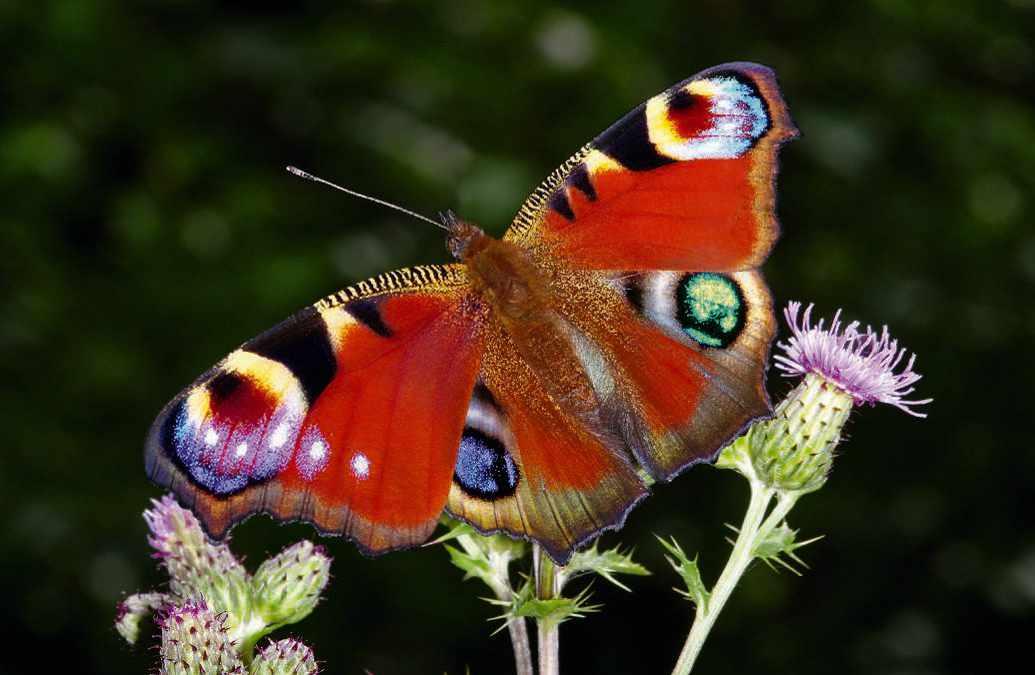

I took this photo of a true crab and its reflection in Ponnani, Kerala. True crabs, in the infraorder Brachyura, have four pairs of walking legs behind their claws.
Shibu Kesav Kerala, India
These brown bears were playfighting in Katmai National Park and Preserve, Alaska. I was grateful to capture this moment with one bear looking straight at me while shaking its head.
Karthik Subramaniam, San Francisco, USA
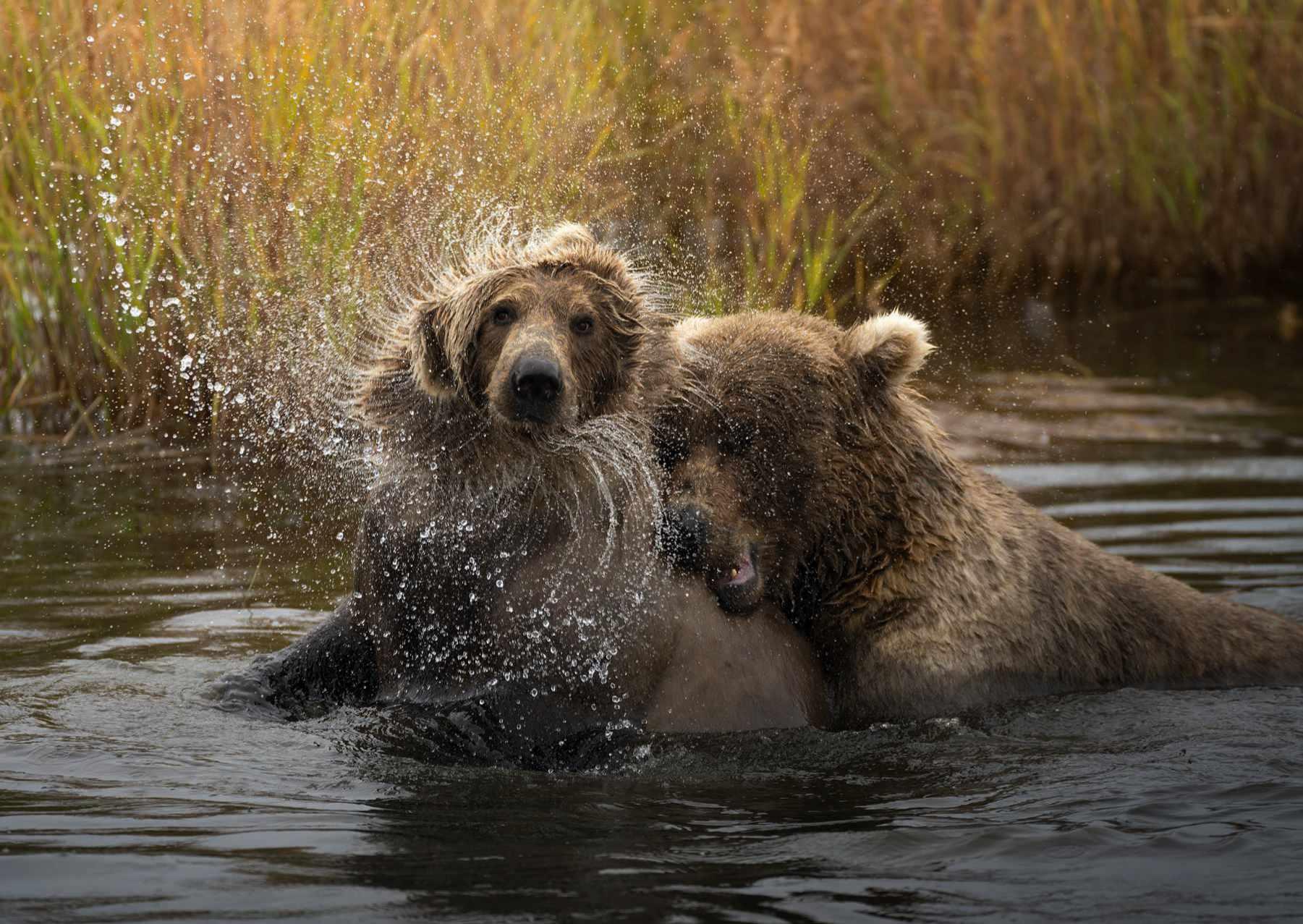
Send your pics to discoverwildlife. com/submit-yourphotos to see them in print!
I saw this beautiful fivebar swordtail butterfly ‘puddling’ in Kuldiha forest range in Odisha. Souvick Mukherjee, West Bengal, India
A baby mountain gorilla stares curiously from its mothers arms, unaware that only a few of them are left in the wild.
Hema Palan, India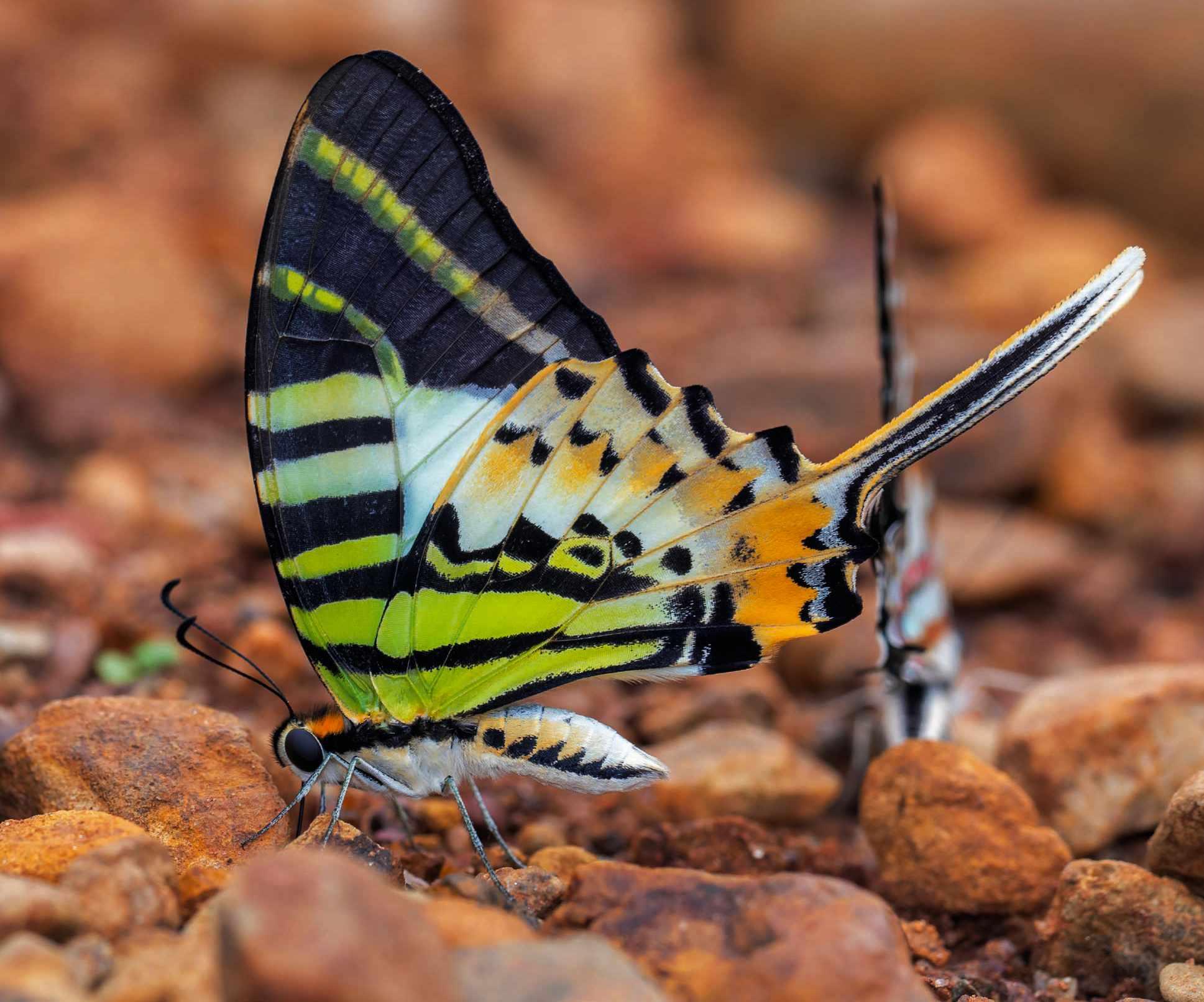

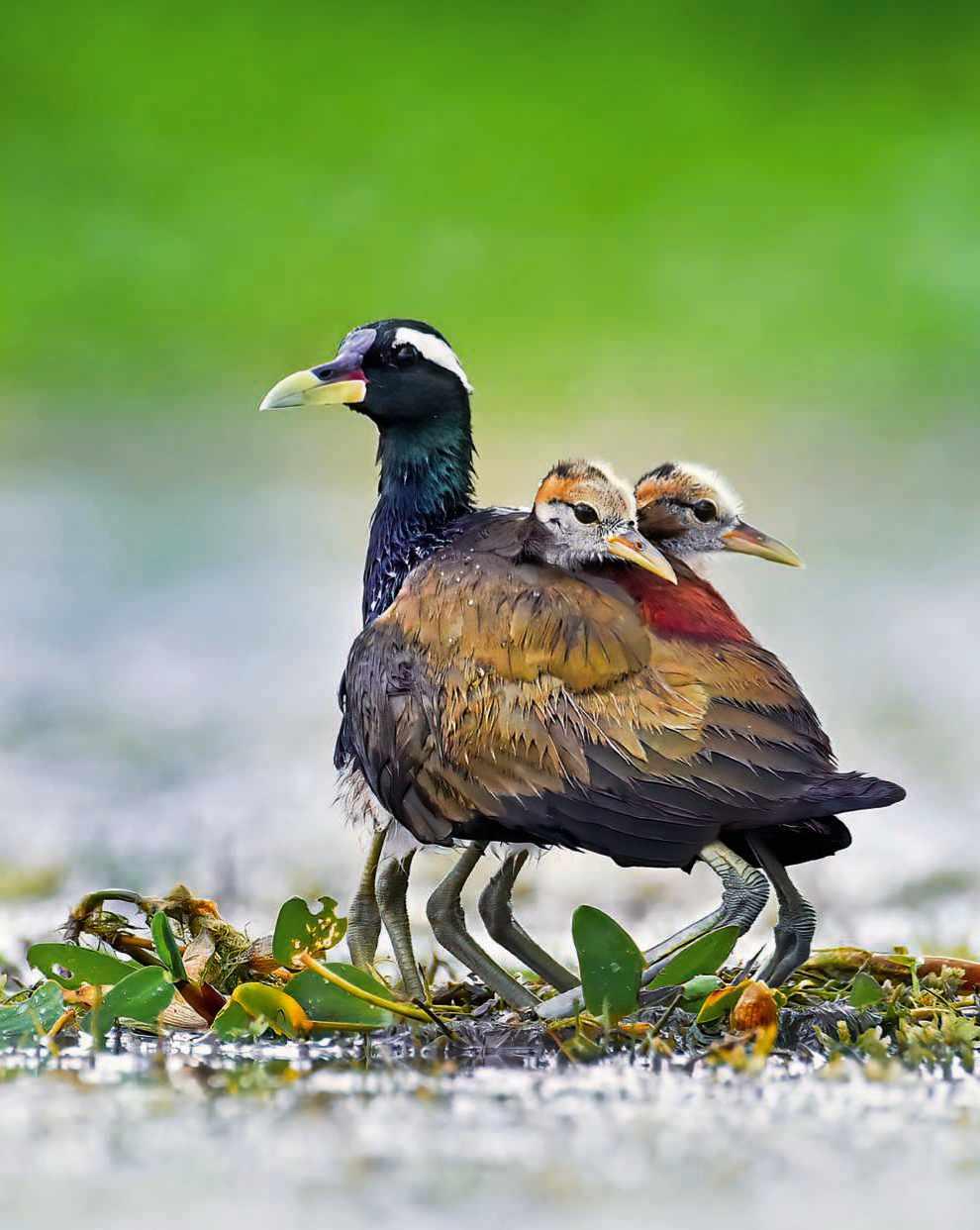
A
Prasenjit Dutta, Kolkata, India
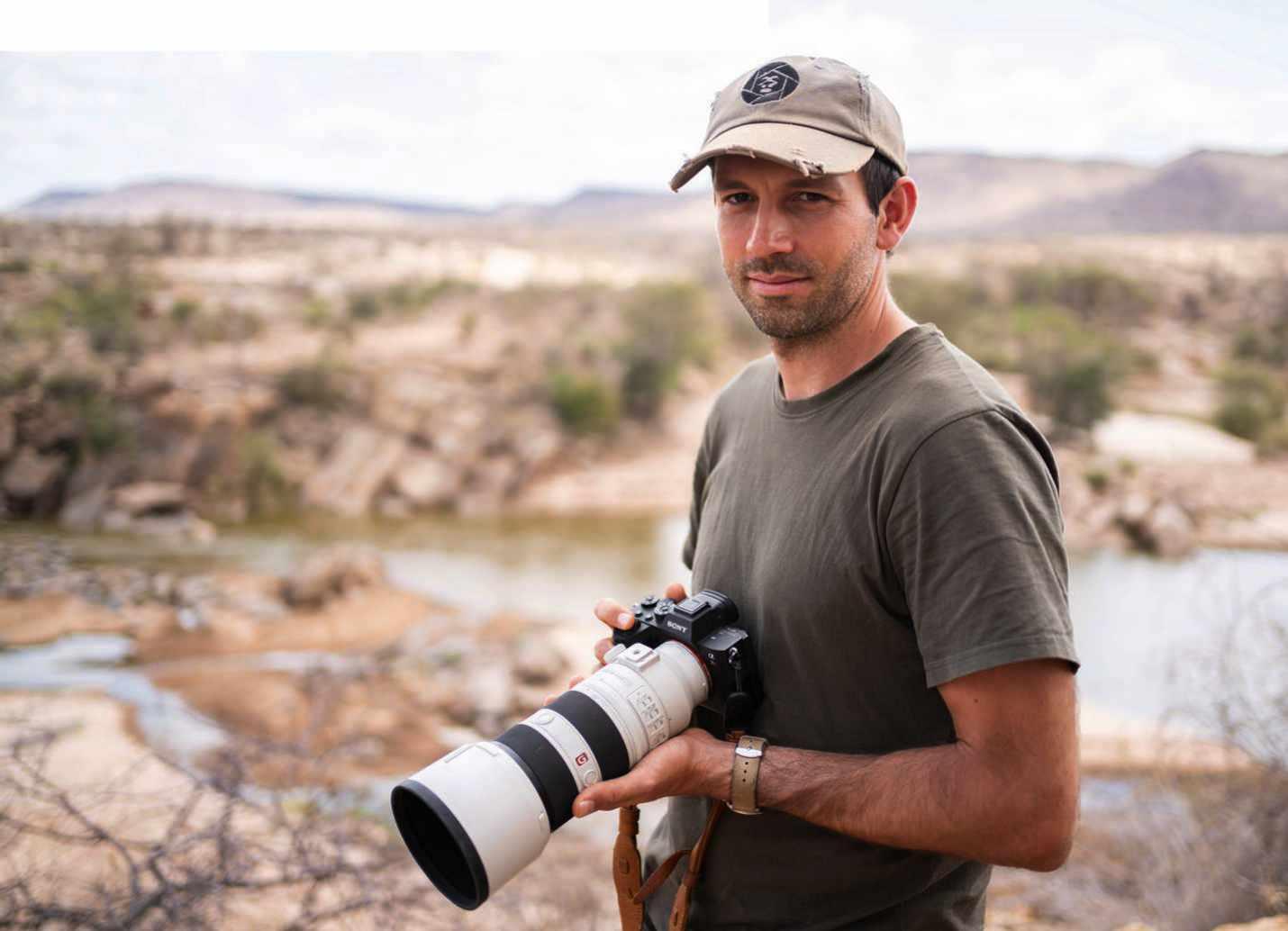
How did your career start?
I lived in Tanzania as a child and some of my earliest memories are from family safaris. That was the beginning of my passion for nature. I started university just as decent and affordable digital SLRs were entering the scene. Digital was a revelation, and at that point I really fell in love with photography.
Which of your shots is most important to you, and why?
In 2017, I worked with the Tsavo Trust to document some of the last ‘big tuskers’ on Earth. I photographed a remarkable old female whose tusks reached the ground. A few months later, she died due to drought. She was like a creature from a bygone era.
Tell us about BeetleCam...
In the early days, I found that by exchanging my telephoto lens for a wide-angle and crawling close to animals, I was able to capture intimate and engaging portraits. I dreamed of capturing this perspective for dangerous African wildlife.
In 2009, I had the idea to create BeetleCam, a four-wheel-drive remotecontrol buggy with a camera, which allowed
me to capture a unique series of images. BeetleCam has suffered various mishaps over the years, including being stolen by lions and trampled by elephants, but with continued refinement it has become an essential tool for that ground-level view.
Have you attempted any other gadgets?
In 2012, I got very excited about drones, but back then you had to build your own from
Setting up a camera trap
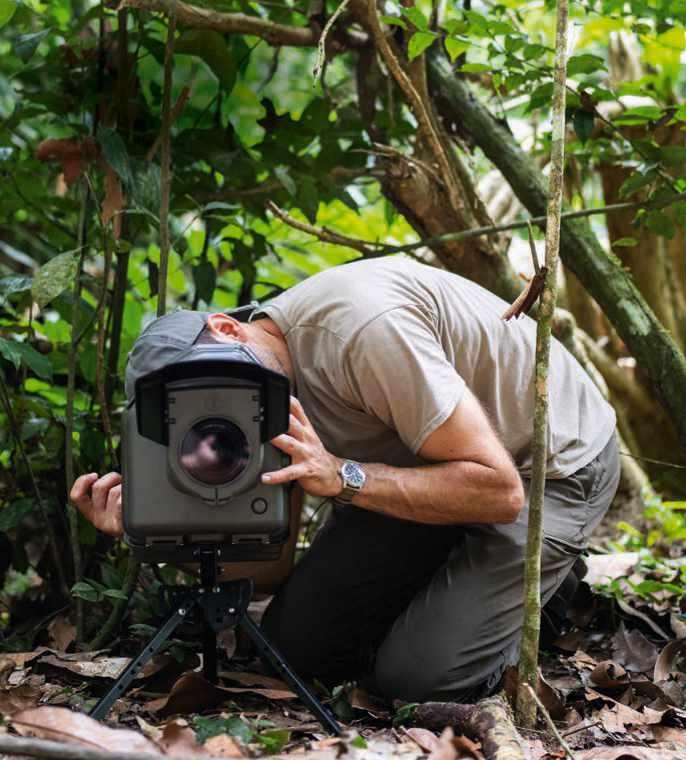
scratch. The first one I built only flew for a few seconds before crashing into a tree.
What’s your ultimate filming accessory?
Camera traps. With artistic lighting, they can reveal the beauty of the natural world at night in ways that cannot be replicated by other techniques. By deploying many camera traps and leaving them for long enough, you can capture even the most elusive creatures.
What’s been the most memorable moment in your career?
Realising I had photographed a black leopard in Kenya. It is the rarest and most stunning creature I have ever captured.
What’s been your most physically challenging shoot?
Last year, I visited Nouabalé-Ndoki National Park in the Republic of Congo three times –and that was tough. I had a team of porters, but we had more than 80kg of kit to carry into the rainforest. To reach one of the field camps, we had to hike more than 20km, sometimes through waist-high water. It was humid and we were under constant assault from biting flies, ants, ticks and mosquitoes. In the evenings, I washed in a stream while flicking away leeches.
What’s been the most rewarding experience of your career?
Moving to Zambia for a year in 2012 was a turning point. I documented the wildlife and seasons of the Luangwa Valley, and learned the value of long-term projects. I was able to revisit my subjects again and again.
What’s the least productive shoot that you can remember?
I recently helped to build a new waterhole and hide in Shompole Conservancy, Kenya. The local wildlife was very skittish and I spent several full nights watching and waiting, but still achieved virtually nothing. Fortunately the wildlife is now used to the hide and my subsequent visits have been much more productive.
What subject has so far eluded you?
A caracal. I have a few shots from fleeting sightings and camera traps but nothing spectacular. They are beautiful cats!
What’s your one piece of advice to budding photographers?
Focus. Pick a subject and photograph it in more depth than anyone else. The more time you spend on a single subject, the better you understand it and the more creative you must be to keep getting new images.

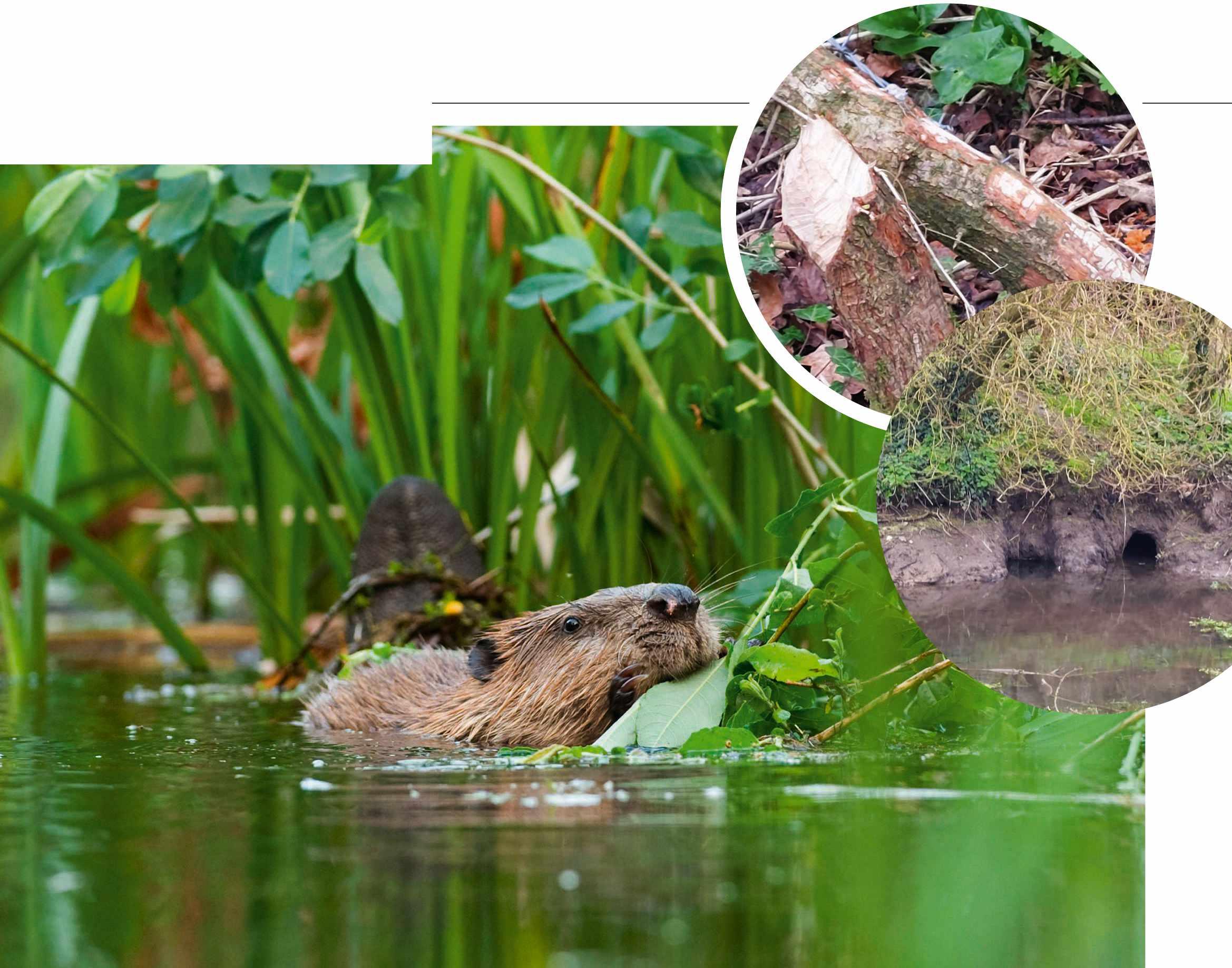
Walking my dogs down by a local chalk stream recently, I noticed some large holes and wondered what might have caused them. The holes were very close to the water so I didn’t think they could have been made by badgers. I also spotted a branch gnawed to a pencil shape and a tree that looked as if it had fallen across the stream. Could the holes have been dug by beavers? I live near Deal in Kent, which is quite rural, but I didn’t think there were any beavers in the area.
Heather Paddison, via emailBEAVER EXPERT DEREK GOW REPLIES:
These are without a shadow of a doubt the field signs of beavers. The holes in the bank are almost certainly burrow entrances. Beavers are good diggers and can excavate burrow systems in the banks of water courses, where the prospect of digging upwards to eventually create a high, dry chamber are sound. The chamber will be lined with thin branches split lengthways
to create a sort of bouncy wooden mattress where beaver families spend their days sleeping soundly before exiting at dusk. Their distinctive tooth patterns can also clearly be seen in your photograph of the ‘pencilsharpened’ branch.
A survey by Roisin Campbell-Palmer of the Beaver Trust recently identified that not only are there beavers on Kent’s River Stour, but that their presence is well-established and widespread (they have been reported in east Kent for almost 20 years). Other populations are also known to exist on the River Tamar in Devon and on the Bristol Avon.
I agree with Jonathan and Angie Scott’s opinion piece in the January 2024 issue about safaris in Kenya’s Maasai Mara “becoming more akin to a circus”. When I lived in Kenya, my profession as a pilot and an interest in wildlife photography regularly took me to the Maasai Mara, where I often met Jonathan Scott. I still
visit Kenya but have not been to the Maasai Mara since 2002 – even then it was noticeable how undisciplined drivers had become and how overcrowded the Keekorok area was. The chaos described in the Scotts’ piece should be acted upon. The image of safari vehicles crowding the banks of the Mara River during the wildebeest migration illustrates the point well, as any animals would have been trapped. I suspect this chaos went on throughout the migration.
I am appalled at the number of camps and lodges there are now in the Maasai Mara National Reserve, and the latest news is that the entry fees will more than double this year. Also, the number of ‘conservancies’ that have sprung up on the boundaries of the reserve focus on economic returns rather than on conservation. While economic returns are, of course, warranted for the benefit of the local Maasai, in the form of health and education etc, the collection and distribution of such revenue to the Maasai is also subjected to chaos, and corruption.

Years ago, Miles Turner, the legendary warden who shaped the Serengeti National Park, was briefly employed by Narok County Council to advise on the management of the Massai Mara National Reserve. One of his first recommendations was to stop the issuance of entry tickets printed on cheap paper and replace them with tickets from security printers in Nairobi, distributing them to each entrance gate in an accountable manner. Sadly, this advice was not taken up and when I visited, in 2002, the entry tickets could have come from any local printer.
The wildlife of Kenya deserves more respect, and conservation should come before the ‘quick buck’ going into the pocket of a ‘big fish’.
JolyonEllis, via email
As a follow up to your article on whether it is okay to feed bread to birds (Q&A, spring 2024), our local Christchurch Park in Ipswich provides seed dispensers as a cheap alternative. However, the problem can be more complicated, as I hope my poem demonstrates:
The gradual pollution of water, Encouraging of rats, corruption Of a natural diet, against The look of joy on a Young child’s face as a Bold mallard takes the offered Cheap slice of white bread
From an outstretched, trembling hand?
Richard Stewart, Ipswich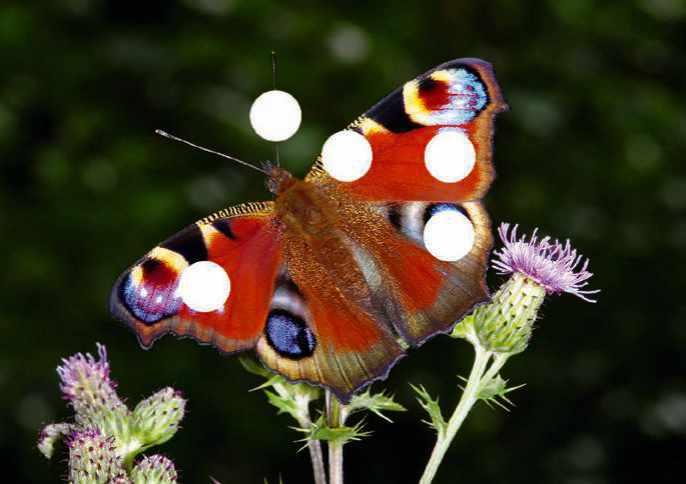

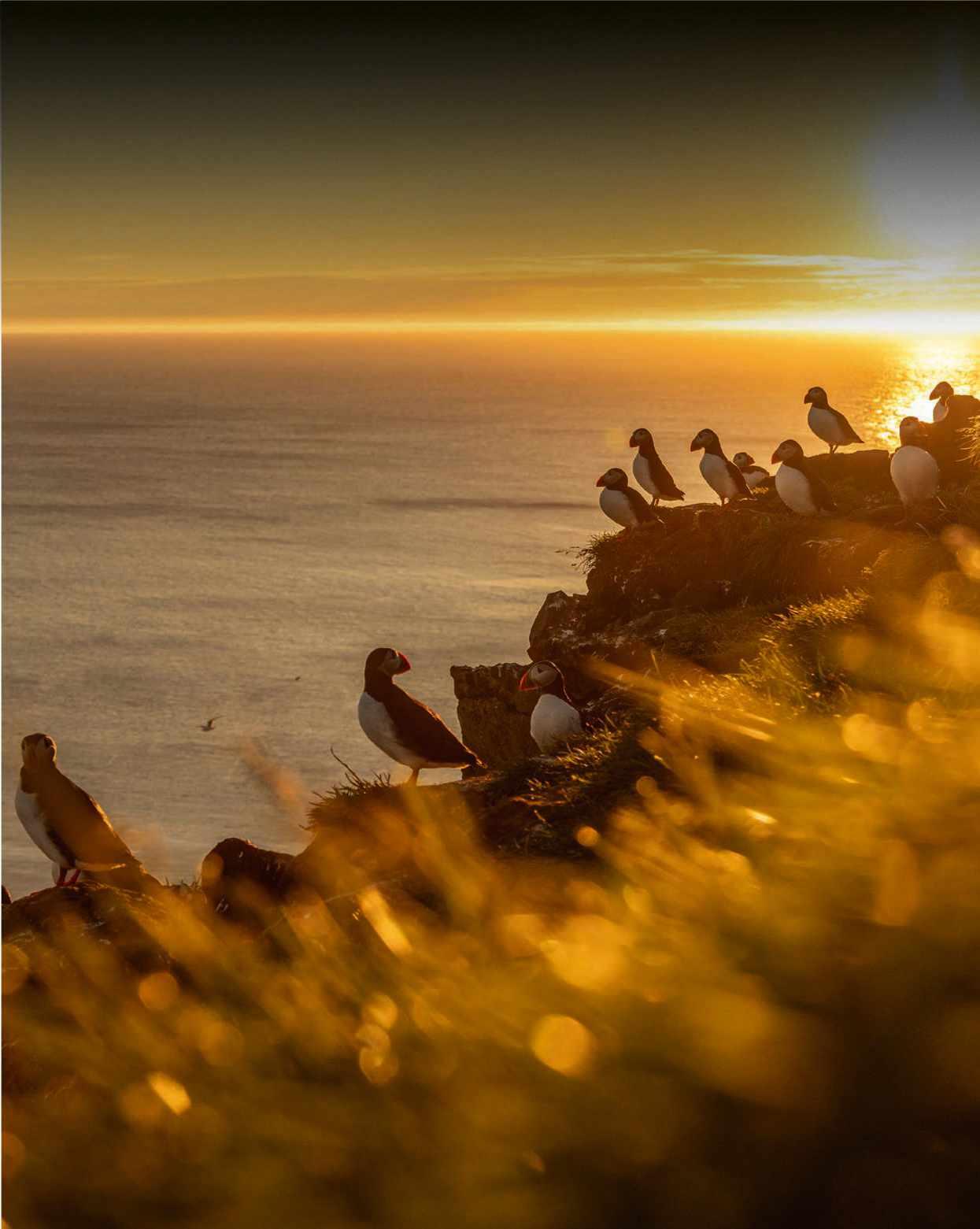
Iceland is home to 60 per cent of the world’s puffins. In 2023, for the second year running, two young photographers joined a trio of scientists to undertake an expedition known as the Puffin Rally – an avian odyssey across the length and breadth of the country that combines science, adventure and seabirds. Here, they recount their adventure in the land of fire and ice.

1 Goliath birdeater
Hailing from the rainforests of northern South America, this is the largest spider by body mass (up to 175g) and by body length (13cm). Its name derives from an 18th-century engraving that depicted another tarantula species eating a hummingbird, which led to the entire Theraphosa genus being called ‘birdeaters’. This species feeds mainly on worms, amphibians and large insects, but it does sometimes kill and eat birds.
2 Giant huntsman spider
Native to Laos in South-East Asia, the giant huntsman is known as the world’s largest spider by legspan, measuring up to a whopping 30cm. Though some Goliath birdeater individuals have matched this, giant huntsmen tend to be larger, on average, giving them the title. Cannibalism has been observed in this species, with larger females consuming males after mating.
3 Brazilian salmon pink birdeater
This next species is a bit of a mouthful, as well as a handful, weighing about as much
as a banana. As its name suggests, this tarantula can be found in the forests of Brazil, but is also popular around the world as a pet due to its fairly docile nature.
4 Brazilian giant tawny red tarantula
Glossy and all-brown, with a legspan of up to 23cm, this South American spider has the distinction of being one of the longest-lived tarantulas, surviving up to 30 years. The species is also a popular pet, sold illegally via a black-market trade in tarantulas that takes its toll on wild populations.
5 Chaco golden-knee tarantula
This particularly handsome (and hairy) tarantula is to be found scuttling around the warm grasslands of Argentina and Paraguay. Its legspan can reach around 20cm.
6 King baboon spider
Native to the scrublands of Kenya, Tanzania and Uganda, these tarantulas are known for their peculiar method of self-defence. As well as a painful venomous bite, they employ a technique called stridulation, using their 20cm-long legs to ward off
predators. By rubbing the hairs on their front legs together, they create a rasping, hissing noise, striking fear into anyone or anything nearby.
7 Colombian giant tarantula
Also known as the giant red leg, this huge tarantula is a shy spider that is more likely to run and hide than stand its ground, despite its considerable size (with a legspan of 20cm). However it does have some interesting defensive tactics, bobbing up and down as a first warning then, to confuse an attacker, spinning around in circles and kicking out with its spiked back legs, a move nicknamed ‘the cartwheel of death’.
8 Face-sized tarantula
This species surely wins the prize for most horror-inducing name. With a legspan of up to 20cm, its moniker does seem appropriate, but hopefully you’ll never be in the position to find out. Found in Sri Lanka, the spider uses venom to disable and kill its prey, which includes lizards, snakes, birds and small rodents.
9 Brazilian wandering spider
Spiders in this genus are quite variable in size but some can grow up to 18cm in legspan, with a bodylength of about 5cm. Despite being called Brazilian wandering spiders, they can be found throughout South America, from Costa Rica southwards. They are also known as banana spiders, due to their habit of hiding in dark, moist places such as banana plants.
10 Sand-dwelling huntsman spider
Found in the sand dunes of Israel and Jordan, this rare and sizeable spider was first described by an Israeli arachnologist in 2007. It lives inside the dunes, constructing clever underground dens with hinged trapdoor entrances made of silk and sand that it uses as shelter from predators and the hot sun.
Leoma Williams
Wildlife Worldwide has over 30 years' experience designing outstanding wildlife holidays across the globe; our small group and tailor-made holidays are led by expert naturalist guides to ensure exceptional wildlife encounters.
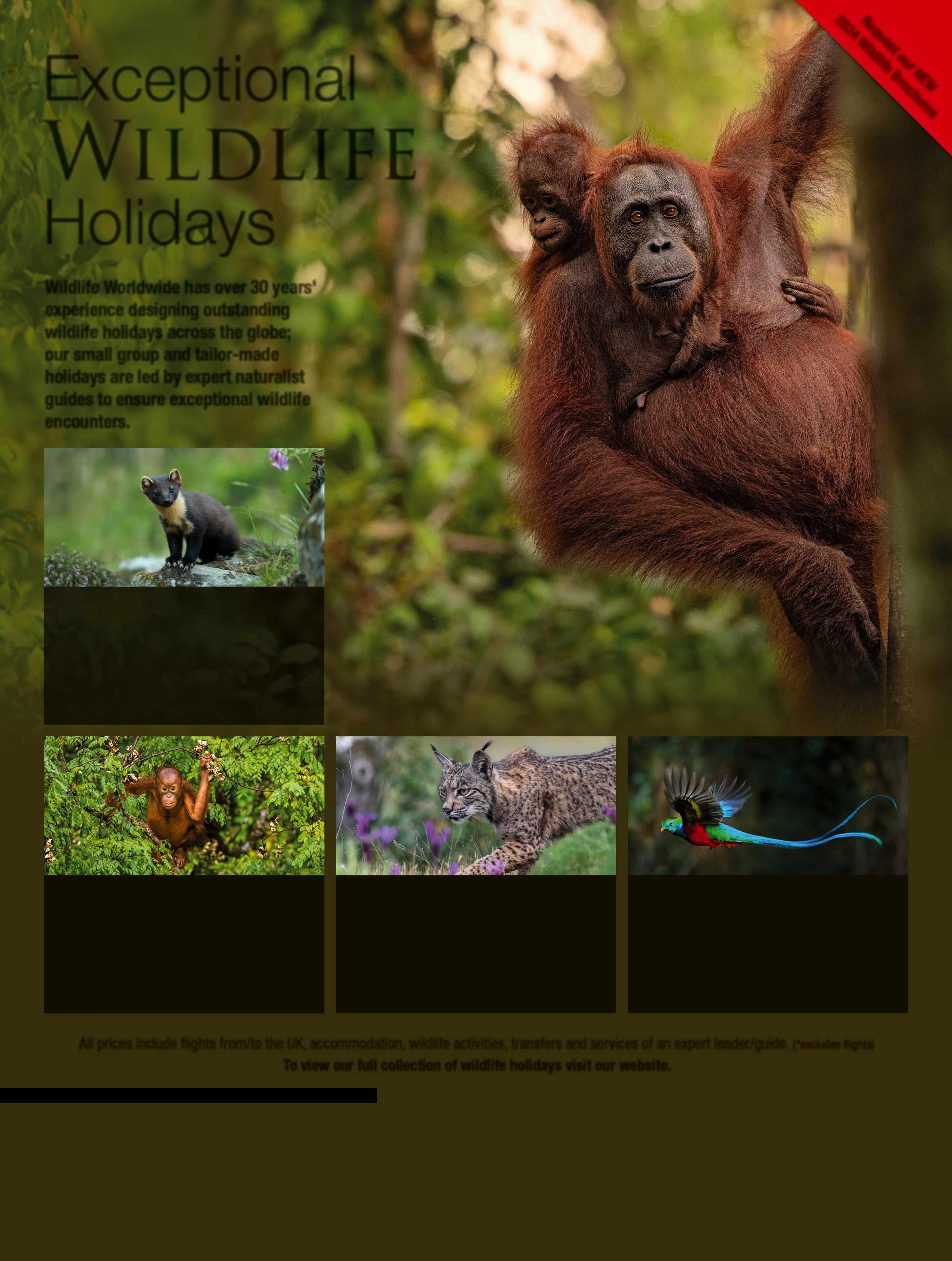
Festival of British Wildlife
Join our expert team of naturalists and wildlife photographers for exclusive use of the Aigas Estate in the Scottish Highlands From here, we hope to observe some of Britain's most iconic species, alongside spectacular scenery
18 May 2024 8 days from £3,295*
Borneo's Orangutans
On this specially designed itinerary we explore the finest locations in Sabah to observe Bornean orangutans in the wild Combining our time on the Kinabatangan River and the rainforests of Danum Valley, we will encounter a broad range of species
5 Sep 24, 5 Apr & 30 Aug 25 11 days from £5,170
Iberian Lynx in Andújar
Explore one of Spain's truly wild corners in Andalucia - Andújar Natural Park - which is home to a diverse variety of birds and mammals It is also one of the last strongholds for one of the world's rarest felines, the Iberian lynx
Departures: Sep - Jun 5 days from £1,995
Costa Rica's Wildlife Wonders
The verdant country of Costa Rica is bursting with fascinating flora and fauna Our extensive 12-day group trip visits some of the most rewarding wildlife locations in search of sloths, howler monkeys and the spectacular resplendent quetzal
2 Nov 2024 & 8 Mar 2025 12 days from £4,995
All prices include flights from/to the UK, accommodation, wildlife activities, transfers and services of an expert leader/guide. (*excludes flights) To view our full collection of wildlife holidays visit our website.
01962 302 086
sales@wildlifeworldwide.com
www

A generation ago, a woman named Sylvia made a promise. As a doctor’s secretary, she’d watched stroke destroy the lives of so many people. She was determined to make sure we could all live in a world where we’re far less likely to lose our lives to stroke.
She kept her promise, and a gift to the Stroke Association was included in her Will. Sylvia’s gift helped fund the work that made sure many more of us survive stroke now than did in her lifetime.
Sylvia changed the story for us all. Now it’s our turn to change the story for those who’ll come after us.
Stroke still shatters lives and tears families apart. And for so many survivors the road to recovery is still long and desperately lonely. If you or someone you love has been affected by stroke – you’ll know just what that means.
But it doesn’t have to be like this. You can change the story, just like Sylvia did, with a gift in your Will. All it takes is a promise.
You can promise future generations a world where researchers discover new treatments and surgeries – and every single stroke survivor has the best care, rehabilitation and support network possible, to help them rebuild their lives.
Will you make that promise to generations to come? Please, leave a gift in your Will to the Stroke Association.
Find out how by calling 020 7566 1505 or email legacy@stroke.org.uk or visit stroke.org.uk/legacy